Spring 2019
Greetings colleagues. A brief update for the week of May 6-May 10 and the last weekly update for this academic year. They will resume when the new fall term begins in August. But, of course, I might send out a note or two if I think people might be interested in knowing something or need to be informed of something. But otherwise…on hiatus. I hope everyone enjoys the summer and takes some well-deserved R&R. It has been a busy academic year—addressing all HLC concerns, approval of our new MFA and alternative teacher education program, RMAC basketball champions for the first time in the history of the institution, the successful launch of our mariachi troupe and our e-sports club, a successful GO Bond campaign that will provide about $4mil for infrastructure improvements, improving our fiscal situation by addressing several lingering and complex issues, forward movement on the Rodgers renovation (presently in budget and on time), a decent outcome from this year’s legislative session including compensation increases, resources for a Native American program in our social work degree, and other improvements and numerous scholarly achievements by many faculty members. Of course, that’s not even counting g the breakthroughs in our classes…our core work. Once again, lives have been changed here at HU even though we faced formidable challenges. I thank everyone who worked together to achieve these and other important and even noble accomplishments.
- Many congratulations to the newly elected HU Student Senate. Many leaders and celebrities held high offices in their college student governments including Ronald Reagan, Jesse Jackson, Hillary Clinton, Bill Clinton, Malcolm X, Halle Berry, and many others. Working in student government is a great way to acquire new or refine existing leadership skills. The newly elected Student Senate President, Ms. Diana Venegas, and I have been in touch and plan on meeting on a regular basis. A photo of the newly elected student government leaders:
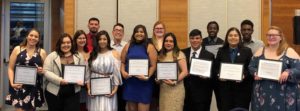
- A large group congregated on Monday to thank our building custodian, Harvey, for his high efforts over the many years. He will be retiring at the end of this month. He stated that he enjoyed coming to work every day because of the people he helped. What a sentiment—and something for all of us to think about, no? Thanks Harvey for all of your efforts and may you have a healthy and happy retirement.
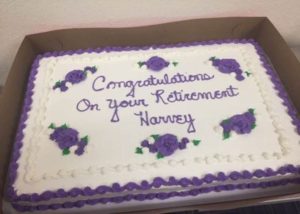
- The Executive Management Team meeting was held on Tuesday and we began with a brief discussion of poverty on American college campuses. We read an article in The Atlantic about Amarillo College and that institution’s efforts to provide wraparound services for some of the students enrolled there. Given that American students now pay a higher proportion of the costs associated with college attendance than state governments, many students really feel the pinch and if they arrive at university already struggling financially, that does not portend well for completion. The proportional shift in who pays (now, students more than state governments) just recently occurred and largely went unnoticed by the general public and even many academics. It begs the question—if students now pay more for their public education than the public pays (that is, students pay more than state governments pay)…what does public higher education really mean? In my mind and the minds of many others, this offloading of costs really and truly explains the fiscal challenges so many students (and academicians) feel today. Years ago, students could literally “work their way through college” by working summers and some part time job during the academic year. I did. Today, that’s virtually impossible. Why is tuition going up? Why are students acquiring so much debt? Because they now pay the lion’s share of college attendance…and that’s a big change and the trend line does not seem to be bending. Here’s the article we read from The Atlantic: https://www.theatlantic.com/education/archive/2018/05/college-poor-students/560972/. Just this week, I also received the Post Session Review from the New Mexico Legislature. This from that report, “The higher education portion of the state’s general fund budget has declined by 27% over the last several decades.” I think it is too easy to fault legislators for this and similar declines in other states. There are many needs here in New Mexico and elsewhere…rising healthcare costs, crumbling infrastructure, underfunded retirement programs, and others. We’ll just have to figure this out together. College affordability is in the news quite a bit lately as we are entering election season and the notion of “free college” is once again broadly discussed. The most recent player in this space is Washington State. Beginning in 2010, up to 110,000 students will attend university at very low or no cost thanks to a higher education bill recently approved by the legislature. Families of four with incomes up to $92,000 will benefit from this program referred to as the Workforce Education Investment Act. Everyone knows there is no free lunch nor free college—someone pays—and in the State of Washington program it will be a tax hike impacting about 1/5 of the businesses in that state. For more details on this one , go to: https://www.seattletimes.com/education-lab/110000-washington-students-a-year-will-get-money-for-college-many-a-free-ride/. This program joins several other free or almost free college attendance programs including the Excelsior Program in New York and Tennessee’s free community college, the “TN Promise” program. I am hardly the first person to suggest that something will have to give at some point. If trend lines in regard to state support continue to go down and trend lines reflecting tuition costs continue to go up, it will not be long before this all becomes quite unmanageable. Some of my colleagues have even suggested that the sooner we reach this crisis point, the better. Then, something will have to give. I am not smart enough to know what that might look like.
- On Tuesday evening, Joan and I hosted a reception for colleagues who were recently promoted or tenured. In higher ed, the concept of tenure was devised to accomplish two things—provide academic freedom to professors, thus allowing them to teach and research topics unpopular or out of favor with those in power and to entice very bright people to enter the academy knowing they would possibly earn less than they would get working in other professions (e.g., business, medicine, etc.). The “value” of tenure was thought to add something to overall compensation—at least that was the idea. I think New Jersey was the first state to pass tenure legislation in the United States. Later, the concept of tenure was expanded to K-12 teachers largely to combat the prevailing tendencies to fire women teachers for getting married or getting pregnant or even…wearing pants. We have come a long way, no? Earning an increase in rank and especially earning tenure are very significant in the lives of academics and mark high and consistent achievement. It is also rare…and increasingly so. Most undergraduates in America are not taught by a tenure-track or a tenured professor and that is a big change from a few decades ago. When I first began as an academic, many disciplines employed no adjunct or temporary faculty at all. I don’t think I even heard that term. But, things have changed and I think that’s too bad. But it is the truth. A photo from that event:

- On Wednesday, approximately 40 student athletes joined volunteers from the Las Vegas Community Foundation for a trash pickup in preparation for this week’s graduation ceremony. Twelve truckloads of trash were removed from the area immediately adjacent to the campus. Well done to AD Snow, our student athletes, and community volunteers to make this happen—a real demonstration of town-gown collaboration. I also recently received a request from the City of Las Vegas to use our golf course facility for the 4th of July celebration, as we’ve done in the past. I approved that request and we’ll be moving forward with the planning for that event. A photo of some our student athletes signing up for the cleanup:
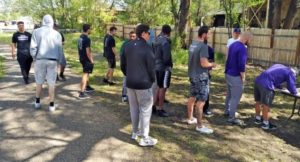
- This is the time of the year we carefully track the number of admitted students compared to the previous year. As of this week, 850 new freshmen have been admitted to HU compared to 698 the same time last year. That’s an increase of 152 freshmen students. That is looking good. We’re also up 20 additional international students and up 199 students in total students (i.e., new freshmen, transfers, etc.). Being admitted does not mean actually enrolling in the fall, but these numbers are encouraging.
- I spent Thursday afternoon and evening in Rio Rancho to attend the Phi Kappa Phi induction ceremony and then the graduation event. Both were very well organized and joyous occasions all the way around. Thanks to all the faculty and staff who made that happen and of course, congratulations to the graduates. A photo from the graduation ceremony:
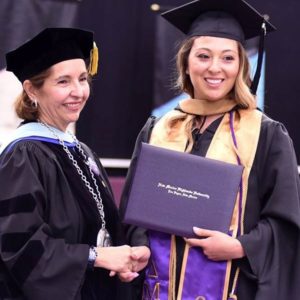
It is once again the season of graduations and those events probably attract more corny bits of advice than any other. How many times have you heard someone rely on the old “this is an ending, but also a beginning” maxim while at the graduation podium? Heck, I’ve used it many times myself. Then there are the “be bold” and “change the world” speeches. Both good ideas, but a little trite perhaps. Then again, I’ve also used those. Oscar Wilde supposedly told graduates that, “we are all in the gutter, but some of us are looking at the stars.” I like that one. Ray Magliozzi from Click and Clack gave a graduation talk once and he said, “You will never have more energy or enthusiasm, hair, or brain cells than you have today.” That was a good one and for most people, probably true. A graduation speaker I heard at East Tennessee State who was also a NASCAR driver (the Bristol Motor Speedway was very close to the campus and the president of the university had a box there) exhorted the graduates to always “steer left”. I guess that’s true if you’re a NASCAR driver, but for the life of me, I don’t know what that might have meant in regard to college graduates. Don’t get into wrecks? Do what everyone else is doing and you’ll probably be OK? Don’t change your tires unless you must? Follow NASCAR drivers around the nation while living in an RV? Unclear. But, many in the audience smiled and clapped so I guess they got it. Maybe it was a NASCAR inside joke. I tend to dislike speakers who focus on their own autobiographies and the incredible obstacles they had to overcome to somehow “make it” in life. Those always strike me as a little self-congratulatory—heh everyone, see how tough I am? Maybe you can overcome the obstacles in your life! I did. But then again, I’m pretty great! I guess I get the pride someone feels when overcoming tough challenges, but I don’t know…graduation ceremonies just don’t seem like the right place to do that although I enjoy hearing student testimonials. Those can be very moving. I really don’t think you can beat Roosevelt’s advice to his son about giving speeches. He said, “Be sincere, be brief, be seated.” That’s really good advice, but seldom heeded. Graduation ceremonies have also inspired some poetry and this week’s poem is by George Moses Horton. Allegedly (some dispute about this), Mr. Horton was the first African American slave to publish a book in the South. He was born a slave and composed poems in his head saying them aloud again and again until he memorized them. Students at a local college often paid him for love poems he composed and apparently, some students presented them to their sweethearts as their own work. Love is blind and apparently also subject to the occasional lapse in ethics. Mr. Horton was an autodidact—he taught himself to read and write around 1832 and after he learned to write he published several notable works including what is probably his most well-known collection, Naked Genius. His goal was to somehow earn enough money to buy his freedom and he finally did so. His work is published in numerous anthologies and he is generally thought of as the very first American to protest his slavery in poetry.
So, in honor of the speeches made by commencement speakers who labor so much over their comments, are often too long, and almost always utterly, unequivocally, definitively, and without question forgettable, Oscar Wilde who claimed his one true love was Florence Balcombe who dumped poor Oscar for Bram Stoker (she apparently had a thing for the literati) and Florence’s later lawsuit against F. W. Murnau (the film Nosferatu was based on Stoker’s Dracula and the filmmakers basically stole the story—I understand she never recovered a dime), Tom and Ray Magliozzi also known as Click and Clack or the Tappet Brothers and their intrepid crew who put together their long running NPR radio show including producer Doug “the subway fugitive, not a slave to fashion, bongo boy frogman” and sponsors including statistician Marge Innovera (“margin of error”), customer care representative Haywood Jabuzoff (“Hey, would ya buzz off”), meteorologist Claudio Vernight (“cloudy overnight”), optometric firm C. F. Eye Care (“see if I care”), Russian chauffer Pikup Andropov (“pick up and drop off”), Leo Tolstoy biographer Warren Peace (“War and Peace”), hygiene officer and chief of Tokyo office Oteka Shawa (“oh take a shower”), Swedish snowboard instructor Soren Derkeister (“sore in the keister”), law firm Dewey, Cheetham & Howe (“Do we cheat em? And how!”), and others (by the way, I mentioned Click and Clack/Car Talk/The Tappet Brothers to a student and she had no earthly idea what I was talking about—so, if you have no clue, but would like to hear an episode, here’s an example: https://www.youtube.com/watch?v=ovkp_yq2b0M), NASCAR, a sport (I guess it is a sport) I tried to watch a few times when I worked at East Tennessee State, but seemed really boring until someone wrecked, which frankly a lot of people seemed to expect—even desire and what’s with that?, the utter banality of speakers exhorting others to overcome obstacles “just like they did” (and patting themselves on the back the whole time they are giving that advice), FDR who launched the Works Progress Administration (WPA) often I think mistakenly referred to as the Worker’s Progress Administration and that my grandfather called the “We Piddle Around” program, but constructed museums, dams, libraries, and many other public buildings and helped get people through the Depression, the poem of the week…The Graduate Leaving College by George Moses Horton. I particularly like the line—The morning sweeps the college clean. That’s a nice image, I think. There’s some debate about the line, “Attendants come” in the second stanza. Some versions of the poem apparently have that line as, “House attendants come” and one person I read about asserted that Moses really wrote, “Slaves come” and I can’t really tell which is correct. Most versions appear as below (Attendants come).
The Graduate Leaving College
George Moses Horton
What summons do I hear?
The morning peal, departure’s knell;
My eyes let fall a friendly tear,
And bid this place farewell.
Attendants come,
The carriage wheels like thunders roar,
To bear the pensive seniors home,
Here to be seen no more.
Pass one more transient night,
The morning sweeps the college clean;
The graduate takes his last long flight,
No more in college seen.
The bee, which courts the flower,
Must with some pain itself employ,
And then fly, at the day’s last hour,
Home to its hive with joy.
Bella says, “Have a great summer. I will.”

Sam Minner,
President
Greetings colleagues. A brief note for the week of April 20-May 3. This one a little early as I will be in Santa Fe tomorrow.
- The end of last week and last weekend were busy with an all-day board meeting on Friday, a scholarship event Friday evening, the Pride Parade on Saturday and the Chevel Shepherd event Saturday evening. There was a final event Sunday afternoon where top high school student athletes from around the region were honored for their achievements. I previously sent out a summary of the board meeting including some information about a long-term legal issue we’ve had with the original contractor of the Student Union. Faculty and staff, please check your email if you want to see a more complete summary of what happened at the board meeting. The Pride Parade was a huge success. I saw one estimate that about 2000 attended the parade or a related Pride event. It was an honor for me, Joan, and Bella to ride in the parade. My exhortation to parade watchers along the way—HU welcomes all students. And all means all. As the leader of the institution, I will always respect the personal opinions and ideas of all people who work and or learn here. I am a hardcore First Amendment advocate and always will be. But, there is a bright line between people’s undeniable right to freely express themselves and discriminatory treatment of others while in the employ of HU. The former may be distasteful and even abhorrent to some, but Americans have that right. It just doesn’t work that freedom of expression is OK for some and not OK for others. For those interested, I can recommend a few countries where things work that way. Citizens are restricted in regard to free speech. But, not in America. The latter (discriminatory practices while working at HU) is my business and I will take immediate action if that type of behavior comes to my attention. Here’s a few photos from the scholarship event on Friday evening:
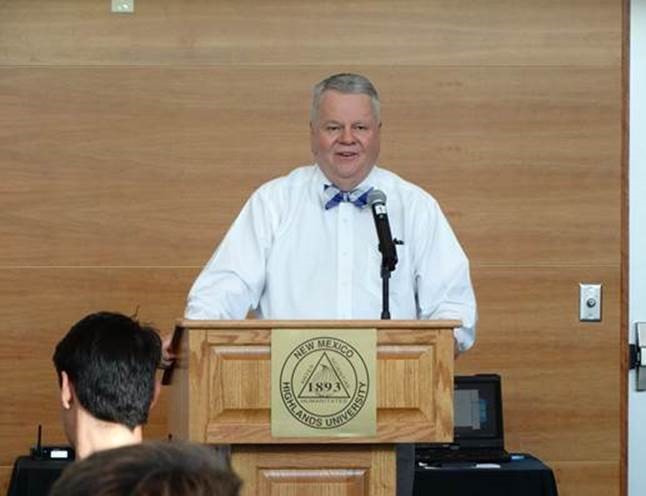
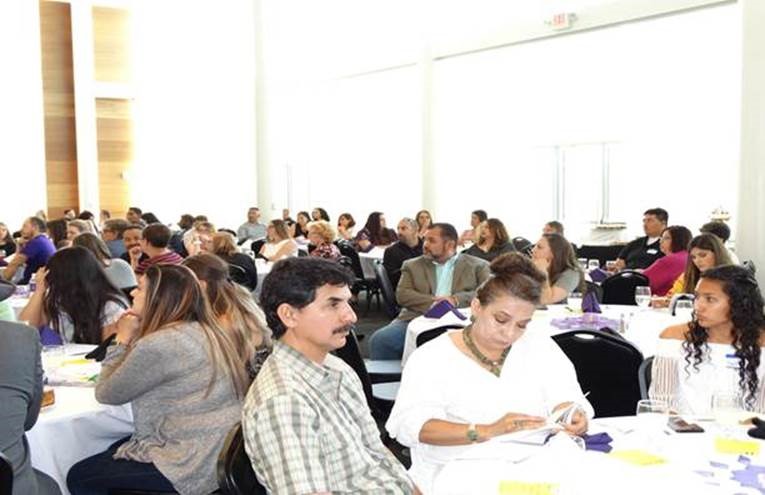
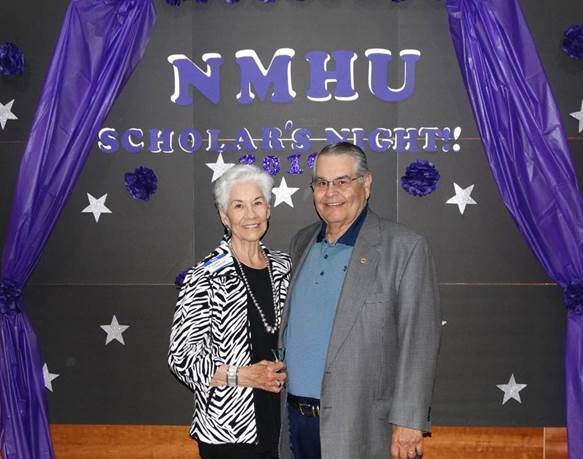
- Our Mighty Vatos shut out UWECI in Des Moines in their final match over the weekend and will once again, compete for the national championship. The Vatos won all five matches in tournament play and outscored their competitors 152-7. Our own Daniel Uballez was named MVP of the tournament. The Vatos will compete for the small school championship June 1-3 in Philadelphia. A photo of our team after their victory:
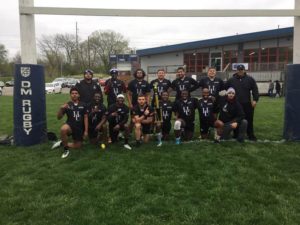
- Monday was a busy one beginning with a student march to advocate for more work hours and pay during the break when we are not in session and the summer. I appreciated seeing some student activism for a change. Year after year around the country, students remain very complacent and mostly remain silent as the costs associated with public higher education are off-loaded onto their shoulders. To me, as a Critical Theorist, this is a form of hegemony in action. Critical Theory 101—those in positions of authority structure things so those with less power do not get a fair shake in some way and in true hegemonic fashion, those who are on the short end of the stick mostly go along with it and in some cases, even think that handling things that way is right and proper. We’ll deal with this particular student wage issue as best we can. I nor anyone I know wants to see students earn less, but we must balance the budget. Believe me, doing that by having people inside the organization suggest someone else or some other office should be cut is a classic form of ideological hegemony—get people fussing internally which precludes anyone from thinking about the real reason for these challenges. These days, we in public higher ed have to constantly hunt for resources to meet budgets without directly impacting the instructional mission. Believe me, that is not fun. If you doubt me, try it sometime. But, when this is settled, I assure everyone that there will be another similar issue, then another, then another. The core problem is not about these internal issues, at least in my head. Cutting this or that internally will not solve the core problem although it might solve some immediate challenge. In my mind, the core issue is this—there has been and continues to be a major public disinvestment in public higher education and for the most part, people, including students and others working in the sector, go along with it. Last year for the first time in the history of our nation, students across the country paid more for their public higher education than was provided by state governments. That is a big deal and it has largely gone unnoticed. This truly bring new meaning to the phrase “public higher education”—is it truly public if students pay more than the public? It kind of sounds like private education, no? Until this changes, the trend lines of less public funding and more on the shoulders of students will continue. That’s too bad. Monday continued with an Economic Roundtable sponsored by San Miguel County, an Inspection of Public Records Act (IPRA) training by the Office of the New Mexico Attorney General, and finally, a visit by Lt. Governor Howie Morales. I really appreciated him coming up and spending some time on our campus. The day ended with a student dinner at the university residence. Joan and I hosted the “Educators Rising” group and as usual, it was a nice event and the conversation flowed freely. A photo of the Lt. Governor meeting with HU folks and another of the student dinner:
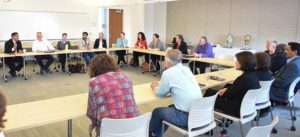
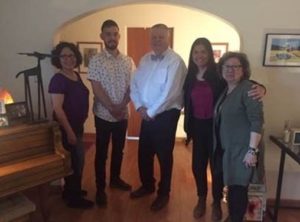
- I was talking with one of our students this week and she mentioned that her final exam consisted of a group presentation. As an instructor I’ve done that many times, but the problem she brought up was…the group started out with five, but ended up with only two. One student dropped out. One switched sections and one was just MIA. Not sure why. So, two people remaining. The student asserted that she thought it was unfair to have to do the whole thing with only two people. I told her to see her instructor, but that if she was only bringing this to the attention of the instructor at this late hour—that was a problem. Or it would be for me if I was teaching the class. Here’s yet another issue related to retention and it reminded me of my own experience many years ago as an undergraduate. For many reasons—poor advisement( believe me, that is not a recent phenomenon) and my own lack of attention to detail (that’s nothing new either)—I enrolled in the introductory class of my major during my very last term on campus. I probably should not have been permitted to do that, but it happened. Sure enough, the class was divided up into groups and I wound up in a really weak one. There were four members (including me) and basically, people didn’t even show up to work on our project. The day of reckoning arrived and the professor asked my group to come forward and do their thing. We had nothing. Nothing at all. I was not pleased with the situation, but I was not going to BS the instructor either. I stood up and announced we had nothing and that we were all prepared to take zeroes on the assignment. I had very carefully calculated my grade in the class and I believed that even if I took a zero I would pass—barely. And I was prepared to do that. The instructor, a wonderful teacher and human being, seemed to get what was going on and asked the group to step outside the classroom into the hall. I said we had not met and that we had basically failed as a group and that failure included me. She asked if anyone had done any work on the project and I said that I had done some and I showed her my research and so on. The other students admitted they had not and offered numerous reasons why including, amazingly, that they were “too busy” and had “forgotten” the due date. That didn’t go over very well. The instructor asked me to meet her in her office later that day and informed me that I could write a paper on the topic of the presentation-we-did-not deliver and she would accept it with a full letter grade deduction (i.e., a grade of A would become a B, a grade of C would become a D, etc.). I wrote the paper and received a grade of A-…so she recorded the grade as a B-. I often thought of that instructor’s approach to all this while I was teaching. She had very high standards and went on to a very illustrious career, but also seemed to understand that I was a kid, I was very much evolving as a learner, and I think, most critically, I had been honest with her. And so, she gave me a break. There’s no other way to put it. She cut me a break and I never forgot it. I think the other group members received a zero on that assignment, but not sure. I never saw them again after that class. I don’t know what happened in the case of the HU student I mentioned previously, but I think I’ll check back with her—not to judge what one of our colleagues did or did not do. That’s up to that professor…not me. Professors make their own decisions on this kind of thing, but I do think that professional judgment should count for at least something. Standards are very important too, of course. But when I think back on what I really learned from all this, I think my prof probably did the right thing. I remember absolutely nothing about the paper I wrote where I earned an A-, but actually got a B-. But, I never forgot about the kindness that professor showed me, the stern talk and the finger wagging she gave me in her office, and the break she gave me when she didn’t have to do so at all. So, thank you Dr. Rosemary Egan wherever you are. I saw a paper about this very thing in a recent Inside Higher Ed. Take a look if you’d care to peruse: https://www.insidehighered.com/blogs/confessions-community-college-dean/when-half-group-has-disappeared.
- On Thursday evening I attended the Santa Fe Graduation Celebration and that has become one of my favorite events. Graduates from that Center and their families and friends gathered for a celebratory event highlighted by several student testimonials—the challenges they faced, the support they received from fellow students and HU staff, etc. The students there clearly have great respect for the HU faculty who teach them. It was very moving. I thank the HU folks who attended and congratulations to the students we honored. A photo of the event:
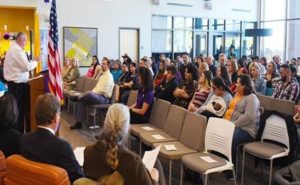
- On Thursday, Terri Law and I received a $3,000 donation from Enterprise Auto Rental, LLC. This donation will go to scholarships for HU students. I recently read that Enterprise was one of the top employers for new college graduates around the country. Many thank to them for supporting HU and our students. Also on Thursday, I held the last “lunch and learn” of the semester—this one with HU Advancement. One purpose of these luncheons is for me to learn from different staff members working in offices throughout the campus—what they do—how I might help, etc. Another goal is to simply thank them for their efforts. I do not forget who does so much heavy lifting at the institution—that would be our dedicated and hardworking staff. These luncheons have been very helpful from my perspective and I do plan on continuing them next year. Thursday ended with another tour of the Rodgers Building. Things really look great there and we are on track. The dedicated boardroom, the Heritage Room, the classroom, and the offices on the second floor are all going to be a nice addition to the campus and hopefully, broadly used by the campus community.
We’re getting closer to graduation and it is a common time for me think about students, a full career working with them, and the high honor of hopefully helping them succeed in life. Poets have thought about this kind of thing quite a bit and a number of school and or graduation themed poems have been written. There’s The School Where I Studied by Yehuda Amichai who I believe only writes in Hebrew, but whose poems have been very widely translated, Up Hill by the very fine Victorian age poet, Christina Rosetti, and then there’s Bill Knott’s An Instructor’s Dream. Bill Knott was an American poet and from everything I’ve read a really tough interview. He taught for many years and trained many poets at the well-known Emerson College in downtown Boston. The founding father of Emerson college was Charles Wesley Emerson and not Ralph Waldo Emerson…and lots of people get that mixed up. I actually knew a graduate of Emerson who emphatically claimed that the founder of his alma mater was Ralph Waldo. Not true, my friend. Look it up. Charles was an academic—Ralph Waldo was the mid nineteenth century transcendentalist whose quote about living a good life is on many a poster (including one in my own home):
“To laugh often and much; to win the respect of the intelligent people and the affection of children; to earn the appreciation of honest critics and endure the betrayal of false friends; to appreciate beauty; to find the beauty in others; to leave the world a bit better whether by a healthy child, a garden patch, or a redeemed social condition; to know that one life has breathed easier because you lived here. This is to have succeeded.”
At any rate, Knott was once awarded the Iowa Poetry Prize and later, a Guggenheim Fellowship. Those are not easy to come by. And, he was always very controversial. Among his several strange stunts—in 1966 while writing under a pseudonym, he leaked to the press (on purpose) that he had died and that he was in fact had been writing under a nom de plume. People sent condolences and there were several posthumous and positive reviews of his work. Problem was…he was not dead. It was kind of a prank…I guess. Not everyone thought it was that funny, but apparently he did. He was always complaining about the poetry bigwigs. He thought they were pretentious, narrow minded, and in many cases, antithetical to the ideals (at least those he espoused) of poetry. However, he did not limit his criticism to others. He was also extremely self-deprecating. He once asserted that his poetry was “nugatory” and that’s not a word you hear that often, but it is a good one and one I try to work into the conversation when I can. Like, “I’d say my opinion about this is nugatory” (meaning…of no significance). Since that is so often true in my case, it is not that hard to work it into a conversation. Knott liked to publish rejection slips from publishers, which interestingly in my experience, is not all that uncommon among writers. I actually knew a writer and a pretty good and successful one at Murray State University who had his entire den plastered with rejections. I could never really understand the motivation to do that, but I think it is fairly common. Stephen King once said, “By the time I was fourteen the nail in my wall would no longer support the weight of the rejection slips impaled upon it. I replaced the nail with a spike and went on writing.” As I wrote, not sure why writers do that. I love one of the rejection letters Hemingway received from a publishing house. The editor stated, “If I may be frank, Mr. Hemingway—I found your efforts to be both tedious and offensive. You really are a man’s man, aren’t you? I wouldn’t be surprised to hear that you had penned this entire story locked up at the club, ink in one hand, brandy in the other.” The editor was referring to The Sun Also Rises—often regarded as Hemingway’s greatest novel. Back to Knott—I gather that people who knew him were never really quite sure if he was serious or making fun of others or poking fun at himself. One publisher writing about Knott said, “He was pretty hostile. I thought , Well, why? I think he had a phobia about the establishment. Belonging was not his thing. It made him uncomfortable. I decided, in the end, that it was just better to admire him from a distance.” I like that line…”admiring someone from a distance” and I think that is sometimes a very good idea. I can think of several people I admire very much in at least some ways, but you know…I’d just as soon keep them a distance and I do. I admire them, but…they are unpleasant and life is too short. Knott (really) died in 2014 at the age of 74 and as you might expect, not everyone believed that he was really gone. Was it another prank? As it turned out, it was true. He left behind a substantial body of work and a history of complaints about the poetry establishment as well as a legacy of frequent and sometimes colorful self-flagellation. The poem of the week by Knott—An Instructor’s Dream—is one that resonates with me. I have taught so many students—I guess it must be thousands now—and for some reason, a number of them have recently reconnected with me. These reconnections have routinely occurred over my career, but it seems like the frequency is increasing these days. I’m not bragging, but the messages I receive (like most professors, I think) are almost entirely positive (e.g., “you made me believe in myself” or “you helped me so much”, “I now have a Ph.D. and you helped make that happen”, “I named my first son Sam after you”…that’s not true…I just made that one up), but I also still receive the occasional “you flunked me and ruined my life and I now despise you” type message. Not many of those, but a few. The interesting things about these messages, to me at least, are the students I do…and do not…recall. Some, I do remember a bit. Maybe their face or maybe some conversation I had with them. Some I remember very well. For example, I’m likely to remember pretty much all of them who participated in some high-impact type learning like study abroad or someone who assisted me with some research or published with or something like that, but some…I just don’t recall. It has been too long ago and too many students ago and I feel bad about that. I mean, if someone takes the time to write and thank you—after years and years—for something you did with or for them, that’s pretty special. And to not even remember them? It seems like that shouldn’t happen. I used to feel really really bad if I didn’t remember them (and I still don’t like that) and I frequently made many super obvious and lamo attempts to make it appear that I did remember them (“…sure Jane…from NAU…of course I remember you…how are you? It has been years.”) But now…I feel like…well, I made at least some difference in this person’s life and that’s a good and positive thing even if I don’t remember them at all. My remembering them or not apparently makes no difference in how they feel about my limited time with them. To me, that’s a positive message and a hopeful one—try to make a difference in someone’s life and you might do that…even if years later you can’t exactly recall what you did or even who they were. Another thing in this poem that rings true for me—when some former students actually see me—maybe at a meeting or something—they amazingly seem to think I pretty much look the same as I used to look at the University of Arizona or Murray State University or Queen Elizabeth College or Northern Arizona University or East Tennessee State or Truman State or Radford or the University College of Belize or…well, you get the idea. That laundry list of institutions is proof I’ve been around. But…if I remember those former students at all…they now look kind of…old. What’s up with that? My theory—they thought I looked old when they knew me back in the day and now…well, I’m still old. Maybe a little older, but basically…was an old guy and still an old guy. My memory of them is—they were a really young person and now they look….kind of old. Time is a funny thing.
So, in honor of Bill Knott, who pretended to pass away and then actually did, Emerson College in downtown Boston where it is impossible to find a place to park, the Emerson boys—one a university president and one a transcendentalist, the ability to somehow endure the betrayal of false friends, the weird but I think kind of common tendency of writers to save rejections and sometime plaster their walls with them, Stephen King’s rock band—the Rock Bottom Remainders who took their name from “remaindered books” (meaning they didn’t sell very well) and wind up in bargain bins or deeply discounted prices on Amazon, the running of the bulls and the Iceberg Theory of Writing, the sweet remembrances of students you have taught over decades and the perhaps even sweeter realization that you mattered to some students you cannot even recall at all, the lucky circumstances that allow some people (including me) to work many places here and around the world, make many friends and good colleagues, and have many great adventures along the way, fond memories of cleaning a blackboard of dust that was really satisfying, but probably messed up my respiratory system, and the weird dynamic that results in two different people living the same time on earth and finding that one has aged perhaps a bit and the other’s youth has entirely been erased …the poem of the week….An Instructor’s Dream by Bill Knott:
An Instructor’s Dream
Bill Knott
Many decades after graduation
the students sneak back onto
the school-grounds at night
and within the pane-lit windows
catch me their teacher at the desk
or blackboard cradling a chalk:
someone has erased their youth
The Erudite One says, “There is nothing more fun that a good game of tug of war. Someone wins, at least temporarily, and then you offer the rope to him so you can go again. It is not really about winning. It is about playing. That my friends, is a good time. Humans could learn a thing or two from this kind of thing. Play. Have fun. You don’t always have to win.”

Sam Minner,
President
Greetings colleagues. An update for the week April 22-26—a little early since there is a board meeting tomorrow:
- Former Chancellor of New Mexico State University and former President of the Council of University Presidents, Garrey Carruthers, continues to be a strong voice for New Mexico higher education and published an op ed in last weekend’s Albuquerque paper. I think he is exactly right—relatively speaking, this coming year will be a good one for New Mexico higher education and we really need to keep that trend going. A single good year is…well…a single good year and it is tough to really move the needle that way. You get to excellence by a sustained commitment. Here’s his op-ed if you care to read: https://www.abqjournal.com/1305095/higher-education-spending-is-a-safe-investment-for-new-mexico-ex-i-look-to-the-governor-and-the-legislature-to-continue-to-consistently-support-and-champion-learning.html
- There’s been a little buzz this week about the intent and what will eventually happen in regard to compensation increases in higher education. I’ve had several questions about this and I’ll try to shed some light on the matter. It is a little complicated. Toward the end of the legislative session, the university presidents were told that we should budget for compensation increases to “average” 4%. At most but not all universities, some type of merit salary increases are in force so in the “average of 4% increase” scheme, some high performing employees would receive more than 4% and some less, but it would average out to 4. I should note that the Council of University Presidents initially advocated for more than 4%, but 4 is where things landed. However, at the very end of the session, the governor asserted that people should receive a 4% increase—no planning for an average of 4%. This made things complicated. Some universities (like HU) had already started to establish a budget for the 4 while others had not. For example, at UNM the initial plan was to provide a 2% raise. Other schools had also already built budget models around some number less than 4%. New Mexico State, for example, recently raised tuition by 6% and was counting on providing unspecified compensation increases from a “four percent pool”—go to: http://newscenter.nmsu.edu/Articles/view/13633/nmsu-increases-tuition-cites-average-out-of-pocket-expenses-for-students-have-decreased-over-the-past-decade. So, where do things stand now? Again, at UNM, their Regents recently approved a 3.1% tuition increase, but even with that increase the institution asserted it could not do the 4% raises without using reserves. That still might happen, I guess, but apparently there is some move to submit a “supplemental request” to the governor for more cash to fully fund the 4% without hitting reserves. To make things even more interesting at UNM, students in the College of Arts and Sciences will apparently be assessed another $10 per credit hour in addition to the other tuition increase. Graduate students will be assessed an additional $50 per credit hour. Bottom line…Max and I have to monitor all this carefully. If there is some opportunity for HU to submit a “supplemental request” then obviously, we should do that. Confused? It is a little murky, no doubt. Here’s an article that will probably not shed any light on things at all: https://www.abqjournal.com/1306043/unm-budget-includes-salary-and-tuition-increases-ex-students-to-pay-115-to-145-more-a-semester-depending-on-course-load.html.
- During this time of the year, we carefully monitor our funnel enrollment and one of the critical statistics at this time is the number of admitted students compared to the same week last year. Compared to the same time last year, we are up 192 students and most critically of all, up 132 new freshmen. That bodes well for us, but everyone knows being admitted is one thing and actually showing up in the fall is quite another. But still, this looks pretty good. Thanks to all who are pushing to bring more students to HU.
- We provide numerous opportunities for students, alums, and others to provide feedback to us about their HU experiences. We administer the National Survey of Student Engagement (NSSE) every several years (we’ll hear back on that one soon) and also ask alums to respond to a survey we send them via email. We just received the results from the 2019 Alumni Survey and once again, the results were very gratifying. There is always room for improvement, of course, but HU students enjoyed their HU experience. Key finding—94.91 of our alums rated the quality of instruction in their major as “very satisfied” or “satisfied.” Another critical item—if you had to do it all over again, would you attend HU? Results—96.55% responded yes or maybe. We asked that same question at a former school where I worked and the responses always hovered around 60% yes and maybe, so we’re doing pretty well there. A couple areas of relative concern—16.95% were dissatisfied with the adequacy of financial aid and the same number were dissatisfied with the quality of career services. We need to think about this, but remember those finding were relative concerns—83% of respondents thought that was OK. Bottom line for me—out alums rate us pretty positively at Highlands. We should never think that good enough is truly good enough, but we are doing well in most areas. Here’s the website to see everything. https://its.nmhu.edu/IntranetUploads/006188-2015-2016-424201983638.pdf. Also, please note that the response rate on this survey was relatively low, but that is not at all uncommon. These were recent graduates we polled with busy lives filled with jobs, family obligations, mortgages etc. and the response rates on this kind of thing are never really great. Many thanks to Dr. Lee Allard and his team for working on this report.
- In addition to domestic enrollment declines at most schools around the nation, enrollment also continues to decline among international students. Last year, there was an overall decline of 2.7% and students from some nations—like Saudi Arabia, a nation that has historically sent many students to the U.S.— have declined 17.1%. There are apparently several reasons for these declines including some reductions in federal programs supporting foreign students, decreased scholarship programs in some foreign countries, and some public demonstrations suggesting that foreign students are not welcome on American college campuses or the nation generally. As is the case with American students, foreign students continue to line up to attend elite and or Ivy League institutions (e.g., Princeton, Stanford, etc.). Those schools are just as well-known abroad as they are here and attaining a degree from one of them carries a lot of weight. But when it comes to other schools including regional comprehensives, international enrollment is in decline. For more, go to: https://www.insidehighered.com/quicktakes/2019/04/23/international-student-numbers-us-decline .
- The City of Las Vegas will be doing some work on the Abe Montoya Rec Center and once again, HU has agreed to allow citizens to use our facilities. The agreement began April 22 so if you see some city residents there, please welcome them.
- The process to select the recipient of next year’s President’s Leadership Fellow has been completed. I received many strong applications (a record number) and the decision was a tough one. All applicants were worthy and I am confident each and every one would have done a great job. I am pleased to announce that next year’s Fellow will be Dr. Lauren Fath. Please join me in congratulating her and thanking her for taking on these new responsibilities.
Spring is definitely here with spring flowers like daffodils and jonquils popping up everywhere. That’s a sure sign of spring, no doubt and many poets have been inspired by spring flowers. There’s Walt Whitman’s When Lilacs Last in the Dooryard Bloom’d, Daisy Time by the Canadian poet, Marjorie Pickthall, and the poem of the week—To Daffodils by Robert Herrick. Those spring perennial flowers are almost all from the genus Narcissus. Like the Narcissus in mythology, spring flowers appear and are beautiful, but don’t last very long. As the saying goes—charm is deceptive and beauty is fleeting. So true. As I recall from my one and only mythology class (I still might have my Edith Hamilton book somewhere), Narcissus was a hunter and darn good looking. At least he thought he was and lots of others did as well. But, he rebuffed the attention of others thinking he was too good for anyone at all—hence, the term narcissistic. Echo, another mythological figure, fell in love with Narcissus, but as was always the case, he dissed her just like he dissed everyone else. That made another goddess upset (can’t recall who that was) and to get some payback, she lured Narcissus to a pool of water where he saw himself and kind of fell for himself. Heh…that happens. Narcissus really thought a lot of himself. Well, that love was not and could not be reciprocated and ultimately he was “burned in the fire of passion” and eventually became a gold and white flower. Lesson learned—don’t think too much of yourself or you might wind up planted in a pot somewhere. The Narcissus story has been told many many times. There’s Black Narcissus, the ground breaking 1947 film starring Deborah Kerr and Sabu, the well-known child actor from India. There’s a Canadian short film titled Narcissus that I once saw in Washington, D.C. Then, there’s another recent film loosely based on the Narcissus story. That film—and it is a doozey—is titled Neon Demon by Nicolas Winding Refn. Not so funny story about this film—it was a dark and stormy Saturday in Las Vegas, NM and I thought it might be fun to drive to Santa Fe to see a film. I saw an earlier Refn film, Drive, starring Ryan Gosling, and enjoyed it and sure enough, I saw that a new Refn film, Neon Demon, was in Santa Fe. Let’s go see that one! I didn’t know much about it except that is was “loosely based” on the Narcissus story. I didn’t check it out any more than that…we just went. Then I had another bright idea—let’s invite our son and our niece. Great parents that we are and great uncle and aunt that we are—once again—a great idea! Well…no. It wasn’t. The film was visually spectacular and very interesting, but…it was rough. Really…how shall I put it…Neon Demon has some super adult and gory images and lots and lots of them. Joan and I stuck it out, but it was a little tough to do that with your kid and your niece sitting right next to you. So, no more inviting anyone to see a film with us unless I know something about it. Another Narcissus connection—in Marilyn Manson’s record, Deep Six, the first lines of the song mentions Narcissus talking with Zeus. The lyrics:
You wanna know what Zeus said to Narcissus
You’d better watch yourself
You wanna know what Zeus said to Narcissus
You’d better watch yourself
You’d better watch yourself
Not putting down anyone’s artistic work, but those lyrics could not have taken too long to write. I mean OK, OK…I know what Zeus said to the guy and I guess he really better watch himself—now let’s move on. The escape pod Ripley entered in Alien is named—you got it—The Narcissus and I think that’s a good name for an escape pod. I mean you use it as a last resort….and it certainly is a beautiful thing to escape a mother ship—especially when it is about to explode. Like spring flowers, you escape in the pod (a beautiful thing), you eventually get down to earth or wherever (probably a short flight) and then the escape pod is useless. It is done. Just like spring flowers. Speaking of the Alien franchise, I once heard a podcast about the many connections between those films and the work of Joseph Conrad. I gather that Conrad is a favorite of Ridley Scott and references from Conrad’s books certainly show up a lot in the Alien films. Nostromo (the name of a ship) was a character in one of Conrad’s books, Nostromo: A Tale of the Seaboard. I’ve not read that one, but I think I should. I recall it was assigned in one my college classes, and I somehow kind of …ahem…never quite got around to reading it. Cliff Notes to the rescue and do they even publish those any longer? I bet not. But, I think I’ll put it on my reading list. In describing that book, F. Scott Fitzgerald said, “I’d rather have written Nostromo than any other novel”, so that’s high praise. In Alien 3, there is a ship called the USCSS Patna. The Patna is the name of a ship in Conrad’s well known novel, Lord Jim—a book I read three times while living in Belize. It wasn’t that I thought it was so great (although it is very good—on many lists of the top 100 novels ever written )—I only had access to five books and that was one of them. So, I’d read all five books and then start over. There is also a reference to a ship named Patna in one of Jorge Borges’-sometimes referred to as the father of magical realism—short stories, The Immortal. There are numerous other connections between the Alien films and Joseph Conrad. Not sure there are any other connections between or among the Alien film series, Joseph Conrad, and Jorge Borges. I think the Patna connection is it. One and done. At any rate, all this is may be useful if you ever appear on Jeopardy: Literature Edition. But, probably not.
So, in honor of all flowers in the genus Narcissus, Edith Hamilton who is proof that one can start a distinguished career at any time (she was sixty-two when she published her first book), the several narcissists I’ve known in my life including a few I’ve worked for and with, the many dangers associated with gazing too long at your own image in a pool of still water, Sabu who was supposedly discovered by a filmmaker who needed to cast someone to ride on the back of an elephant and found Sabu while he was…actually riding on the back of an elephant (what are the chances?), Nicolas Winding Refn who makes some interesting and some pretty wild films, Brian Hugh Warner aka Marilyn Manson, the many joys of recording all the Alien films and binging on them while consuming dangerous quantities of junk food, the pleasure of having the time to read Joseph Conrad’s Lord Jim—three times—while living in the jungle, driving a 1960s era Land Rover with no top and right hand steering to work, and helping to establish the University College of Belize, Gabriel Garcia Marquez, Miguel Angel Asturias, Jorge Luis Borges, and all the magical realism crew, and to the fleeting but beautiful existence of spring flowers and our own lives—the poem of the week— To Daffodils by the well-known carpe diem and rosebud gathering poet, Robert Herrick:
To Daffodils
By Robert Herrick
Fair Daffodils, we weep to see
You haste away so soon;
As yet the early-rising sun
Has not attain’d his noon.
Stay, stay,
Until the hasting day
Has run
But to the even-song;
And, having pray’d together, we
Will go with you along.
We have short time to stay, as you,
We have as short a spring;
As quick a growth to meet decay,
As you, or anything.
We die
As your hours do, and dry
Away,
Like to the summer’s rain;
Or as the pearls of morning’s dew,
Ne’er to be found again.
The Erudite Bella says, “Narcissus may have been pretty fond of himself, but if you are really and truly good looking, that’s not narcissism. It is not even bragging. And by the way, I am the former and I am not the latter. Just sayin’.”

Sam Minner,
President
Greetings colleagues. An update for the week April 15-19—a little early as we are not in session on Friday:
- Nice article in the Albuquerque Journal this week about the app the faculty and students in Media Arts and Technology are working on to assist hikers in the Los Alamos area. If you’d care to peruse, go to: https://www.abqjournal.com/1303169/nmhu-students-create-los-alamos-trails-app.html.
- Last Saturday we once again welcomed a group from Amigos de las Americas (formerly called Amigos de Honduras). The Amigos organization in a nonprofit based in Houston, Texas that works to send teenagers and young adults to various Latin American countries including Brazil, Costa Rica, Columbia, Ecuador, Guatemala, Panama, Peru, and others. Students raise funds over the year and travel to another country for a couple of weeks up to nine months. They often participate in some health, environmental, or other service activity. Many thanks to everyone who helped welcome these students and their mentors to our campus. Special thanks go to Eric Romero and Margaret Apodaca.
- We continue to gather information about students who leave HU before graduation. Recently we focused on students with 90+ credits and a zero balance—these students are very close to graduating and owe us nothing and yet, they are not in school. Why? Sixty-two students were in the data set and were able to contact 44% of them. Among the reasons mentioned for not completing, the largest group asserted they were not in school for a variety of “personal” reasons including family matters, health issues, etc. The next largest group said they transferred from HU to some other school—we didn’t have the major they wanted, LV didn’t work for them, they wanted to live in a larger town, etc. Only two students said they were not enrolled due to some financial issue. This from a recent article in The Chronicle of Higher Education, “… there is a growing recognition that poverty, rather than academic demands, poses the biggest barrier for many students…”. So, what are the implications of all this? My takeaway is that we (and I would say, many other schools as well) lose students due to a crumbling social network of programs and services to meet their basic human needs. If you are having childcare issues, experiencing food insecurity, dealing with family crises related to poverty, etc., lots of people put all that first before college attendance and I do not blame them one bit. If anything, it demonstrates they are decent human beings. Now, what to do about it? Here’s a good article on the food insecurity issue: https://www.gse.harvard.edu/news/uk/18/11/food-insecurity-college-campuses. There’s also been a lot of discussion recently about student debt—who carries the “worst” debt and who has the most trouble paying their loans. The evidence is pretty clear—the students who have the most trouble paying their school loans are not students who take on an average debt load, graduate, and get a job. For the most part—there are always outliers—those students pay their loans and given they are earning a higher salary than they would otherwise earn with no college degree, they can pay their loans over time. And most do. The absolute worst situation is for a student to enroll, take out loans, and then…not graduate. Those students have a high school diploma, no college degree, outstanding loans, and a decreased ability to repay their loans due to the fact they only have a high school education. The students in that category have the worst record in the nation when it comes to repaying their loans. That’s why some people say that we really don’t have a student debt crisis…we have a student graduation crisis.
- A former colleague—actually someone I hired some years ago—recently left an executive administrative position (new prez and he got caught up in the housecleaning—a very common thing) and returned to the faculty. We talked this week about the transition and the challenges he’s facing. I’ve been around this kind of deal several times and once left an interim administrative job myself and went back to a regular faculty position so I know something about it first-hand. From my perspective it is mostly about why the person left the administrative post. Sometimes life circumstances change and you need or want a more flexible schedule so….you move from an administrative role to a faculty job. I’ve known a few colleagues who just had it with administration—they grew tired of trying to solve tough and sometimes intractable problems and wanted to just concentrate on their own work for a change. They wanted a simpler life with fewer moving parts. The job of university president, for example, has been famously referred to as the toughest leadership job in the nation (go to: https://www.forbes.com/sites/robasghar/2013/11/15/the-toughest-leadership-job-of-all-its-not-what-you-think/#7506b3b063cd). I’m not sure I agree with that, but heh…ask Robert Sternberg. Obviously, folks who wanted a change were glad to return to the faculty…it was their wish to do so. So generally, no problems with them. But….a significant group of colleagues I’ve known are either fired from their administrative job or just as commonly, resign under threat of dismissal. Higher education is somewhat unique in that lots of people who don’t make it as administrators, for whatever reasons, maintain a job at the institution and move to the faculty. That’s pretty common—the so-called retreat rights. Things can sometimes get weird in those circumstances. Some find that returning to the faculty is just fine…even though they might be a little or more than a little hurt after being removed from an administrative post. Some move on to other jobs at other places. But some remain in the faculty role and simmer…their removal from an administrative job becomes, like poor Sir Urry’s experience, truly a wound that never heals. A colleague I knew and really liked at another institution had a pretty high administrative job (director or coordinator or some title like that) at a satellite location and was convinced to resign (Him: “Sam, I think I am going to lose my administrative job.” Me: “Well…yeah…everyone knows that.”). Problem is he built a beautiful dream home on a large lake next right next to the satellite campus he managed and then after returning to his “first love” (teaching…read…was pressured to resign)—he had to drive to the main campus to work plus he really couldn’t easily afford his new grand home anymore since his salary was decreased considerably. Believe me, he was not a happy camper and even though I liked this guy, I observed him do everything he could to cause trouble for others including people who had nothing to do with his dismissal. His issues were with the institution—not a single person. My former colleague and I are thinking of doing a paper on this kind of thing or perhaps a presentation at some conference. Maybe focus on how to handle this, best practices, policies that work or don’t, etc. If you have examples of this, let me know and with your permission, I’ll include them in the paper or presentation. Here’s some articles touching on this topic: https://chroniclevitae.com/news/2054-leave-your-administrative-job-and-find-out-who-your-friends-aren-t and https://www.insidehighered.com/advice/2009/07/24/and-out-administration.
- This week was the deadline for new applications to the President’s Leadership Program and I received a number of applications from good colleagues throughout the institution. I thank everyone who applied and everyone who submitted letters of support. I’ll be making the selection soon. Leadership has always been important in the academy, but I do think that the challenges we face in the sector today require strong and courageous leaders like never before. Taking a leadership position is not for everyone. Some don’t want to do that. Some want to, but perhaps shouldn’t. Some try it on and then learn they don’t want to do it. It is different from a regular academic life, no doubt. But, at the end of the day, bold and courageous servant leaders are very much needed today and I am proud that so many of my good colleagues at HU are willing to give it a try.
- I attended a brief session this week on the faculty/staff giving campaign. I was pleased to hear that several good colleagues have already given to this appeal. The major push will come this fall. I appreciate the fact that our Advancement Office is pursuing this worthwhile campaign and especially appreciate the folks who have given or will do so. Four major areas have been identified for potential giving: (1) a Student Success Fund designed to help students finish their programs of study, (2) a Student Extreme Hardship Fund that assists students who , for example, need some support to attend a family funeral or other important family event, (3) the General Student Scholarship Fund, and (4) a special fund to support activities at Rio Mora National Refuge. At the meeting I read a brief passage from The Prophet by the great Lebanese poet Kahlil Gibran. In writing about giving, he said (italics added), “ There are those who give little of the much which they have—and they give it for recognition and their hidden desire makes their gifts unwholesome. And there are those who have little and give it all. These are the believers in life and the bounty of life, and their coffer is never empty. There are those who give with joy, and joy is their reward. And there are those who give with pain, and that pain is their baptism. And there are those who give and know not pain in giving, nor do they seek joy, nor give with mindfulness of virtue. They give as in yonder valley the myrtle breathes its fragrance into space.” This latter group in the poem just gives because…they think it is the right and just thing to do as a human being. They give generously and freely…like flowers give scent to the air…to make the world a better place. Their giving is not transactional. I think that is a beautiful ideal and one we should strive to achieve.
- Two potential employers of two of our recent graduates called me this week doing reference checks. Both of these potential employers asked me about the private social media accounts of these former students and expressed concerns about some postings on their accounts. Like most employers these days (I think), they had simply did an online search for the names of these applicants and some of their social media accounts popped up. Some postings/images were not in good taste or reflective of someone you probably wanted to hire. I responded that we really had nothing to do with those private accounts, did not monitor them, nor did we sanction students for things they put on them including images and or messages that may be or are may not be consistent with our institutional values. I stated that in these cases, the students were acting as private citizens. The conversations I had with these two potential employers were remarkably similar—they both said they understood me and accepted my response, but also asked me what training, if any, we provided to our students about the risks associated with their private social media postings—digital images that, for the most part, will follow them forever. They’ll follow them if they apply to graduate school. And clearly they follow them when they apply for jobs. I had proof positive of that this week. I don’t think we provide any training in this domain whatsoever. My thinking is that we need to plan and implement some training for students about all this. I’ll work with HR, Dr. Blea, and possibly Career Services to get this done. If anyone has any other thoughts on this, please let me know.
I had a little time to come up for air over the weekend and tuned in to some news and political shows. I was struck by the number of people running for some office who have situated climate change at the center of their campaigns. Others seem to be focusing on the apparently deepening divisions between and among Americans. There are other issues as well, of course (e.g., healthcare), but those two issues seem to pop up frequently in this political season. One of the Sunday news commentators mentioned that the novels and poetry of Barbara Kingsolver were important things to read as people reflect on both climate change and issues of human diversity. Good idea. Her work almost always focuses on one or both of these topics. I have several connections with Kingsolver. She and I both lived in Tucson and were both students at the University of Arizona at the same time. One of my doctoral cognates was philosophy (believe me, I barely skated by) and I once attended a symposium on The Philosophy of Decreasing Biodiversity—as I recall this session, the speaker asserted that species were dying off at an alarming rate and yet so few seemed to care. I sat right next to Barbara Kingsolver during that meeting. She was very friendly and clearly super smart. Yet another connection Joan and I had with Kingsolver was the restaurant she and her husband operate in Southwest Virginia. This restaurant, The Harvest Table, is located in Meadowview, Virginia population…well…however many people are eating at the restaurant. There are some homes in Meadowview so I guess the population is greater than those seated at the restaurant, but I’ve been there many times and I don’t ever recall seeing a single human in town at all. I mean…it is a super small town. The establishment is an outgrowth of Kingsolver’s experiment to subsist for a year on only food materials grown on or near her farm. She and her family deviated from that standard a bit—things like coffee, sugar, tea, etc.—but they pretty much stuck to their rule. This experiment was captured in her bestselling book Animal, Vegetable, Miracle: A Year of Food Life. It is a cool book. Barbara wrote most of it and her husband added some interesting sidebars about agribusiness and even their daughter added some recipes. As I wrote, it is really an interesting book and I have a vivid memory reading it. I read it while in China far away from grocery stores of any kind. The university I was with at the time operated a program where we sent students to one of two very rural schools or to a large city, Shuizhai (pop. 400,000), to teach English to Chinese high school kids. The Chinese students studied English in school, but most had never heard a native English speaker before. Our students lived in the local community and spent one semester there. Needless to say, it was an incredible experience for them. Someone from the university visited the students on a routine basis and I was once there long enough that I had to shop at the markets and believe me, there were no prepared foods whatsoever. It seemed everyone there ate locally—there really wasn’t any option—even in Shuizhai. You could eat at a restaurant and I occasionally did so. I did a lot of pointing, but since I had no idea what I was ordering, it was a little risky. I once ordered some dish that was just terrible and my Chinese friend later told me I had ordered pig frog congee. It was so bad. I really couldn’t eat it. I guess you just can’t get good pig frog anymore. At any rate, The Harvest Table serves so-called “neo-Appalachian” food and believe me if you pronounced that word with a long a (Appa-lay-shun), you would hear about it and not kindly. In that part of the world, the first and middle “a” is short and mispronouncing it was usually met with derision and possibly worse. There are many important values and unique cultural features in that part of the world and many of them have origins in Scotland. Those traditions are powerfully felt throughout Appalachia—the Radford University team was called the Highlanders. At HU we have the mariachis. At Radford we had the pipes and drums. Another interesting Appalachian tradition is that so many people are named John L. and then their surname as in Bobby John L. Smith or Ray John L. Jones and if you don’t know where that comes from, you are no union brother or sister to me and you probably don’t know what a “crust of bread” speech is either. Back to the restaurant—incredibly, the Harvest Table—in tiny Meadowview, Virginia population however many people are dining— got some notice from The New York Times (https://www.nytimes.com/2011/07/27/dining/local-food-has-been-no-easy-sell-in-appalachia.html) and Vogue Magazine (https://www.vogue.com/article/why-this-region-of-virginia-could-be-the-souths-new-food-hotspot). Joan and I used to stop there frequently on our way to Abingdon, Virginia or Johnson City, TN. My fishing buddies and I sometimes stopped on the way to a fishing excursion on the Holston River. The food was really great and there was also a small shop where you could purchase local honey, wool (there is an alpaca farm close by), and….signed copies of Barbara’s books. She was often there in person. She is mostly known, I would say, as a novelist and a number of her books focus on environmental themes. That’s no surprise since she is a trained scientist. My favorite is Flight Behavior. However, I’d say her most well-known book is The Poisonwood Bible and it is one of my wife’s favorites. But, Kingsolver is also a poet. One of her best, in my humble opinion, is Justicia. That poem is not so much about environmental issues (I don’t think), but does touch on social and equity themes. I’ve read several analyses of this poem and as is often the case (and I think that’s totally OK when it comes to poetry or really, any art), people have really different ideas about what it might mean. My take is it is about how terrible things continue to exist in the world—things like discrimination, bigotry, etc. There are these terrible ideas and some terrible people promote them (the wolves) and they are among us. No doubt. Plus, these terrible things transcend borders. They are ubiquitous in the world. You see examples in Texas and Managua and on and on. Even in your hometown. So, Bolsheviks (people who are in the majority and in positions of power and authority) lock their doors and yet…the wolves deserve a meal and…will find one. If you know more about poetry than me (which would not take much), please be gentle in grading me. Let’s go with a gentlemen’s “B”, OK? I’d actually be OK with a C. I mean, that’s a passing grade, right?
So in honor of Sunday news and political shows where pundits comment on what they think instead of anything they’ve actually done, The Old Pueblo (Tucson) and the University Of Arizona (an institution older than HU), the study of philosophy, which is a noble thing to do, but tough to somehow work into a career (some lines from one of my favorite films, Lost In Translation: Bob—played by Bill Murray, “What did you study?”— Charlotte—played by Scarlett Johansen, “Philosophy.” Bob : “There’s a lot of money in that racket. You just have to work out all the angles.”), the incredible and slightly creepy eyebrows of John L., the Meadowview Restaurant—absolutely the best (and only) place to eat in Meadowview, Virginia, food shopping in central China and wondering what the heck you just purchased and how on earth you are going to prepare it, pig frogs in congee or served a la carte (really terrible either way, in my opinion), all of Barbara Kingsolver’s wonderful novels and poems, the many assets, incredible beauty, and yet deep social challenges facing all inhabitants of Appalachia including those named (insert first name) John L. (insert last name), and the audacity of an amateur student of poetry to suggest what something means…the poem of the week…Justicia by Barbara Kingsolver:
Justicia
by Barbara Kingsolver
The feral incantations of our dreams
bring the wolf
through the door.
The southern sun is flint
on his charcoal eye.
The image of a person, tiny and perfect, shines
in the mirror of his cornea.
His orange pain becomes a desert sunset.
His hunger perceives the scent of blood
on the wind,
the sleep of sheltered animals,
everything
but borders.
The television says McAllen, Texas,
is closer to Managua than to Washington, D.C.,
and housewives in McAllen
check their own
possibly Bolshevik eyes in the mirror
and lock the windows.
Their peaceful constitution sings of liberty
and justice
and their outlaw dreams
say the wolf deserves a meal.
The Erudite One says, I basically have no eyebrows at all, but I totally agree…John L’s are impressive. In the event you can’t quite tell, that’s me on the left. John L on the right.”


Sam Minner,
President
Greetings colleagues. An update for the week of April 8-12:
- On Friday, Joan and I attended a very nice dinner and reception at the McCaffrey Historic Trolley Building. It was the first meeting of the Advisory Committee for the new MFA—our one and only terminal degree program (at least at this point). We dined with an eclectic group of people—a video game designer who is moving to Las Vegas, a graphic designer who works in LA, a sculptress, and others. It was really a nice evening. I always enjoy being around the Media Arts faculty and staff—so positive, so upbeat, so professional, so enthusiastic about what they do and the accomplishments of their students. Really great. On Saturday, we attended an open house at Duke and Suzanne Sundt’s home where Duke unveiled his latest piece—a life-size piece depicting the mother of a soldier killed in action. The female figure is holding the folded flag traditionally given to the parents of those killed during military service. It was an incredible piece—very moving. We are lucky to have artists like Duke living and working right here in our community. A photo of the wonderful Media Arts and Technology faculty and the Advisory Committee:
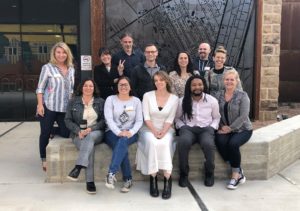
- The HU team attending the Higher Learning Commission (HLC) left last weekend for the national meeting in Chicago. This year, we sent a team consisting of Dr. David Sammeth, Dr. Roxanne Gonzales, Mr. Max Baca, Dr. Edward Martinez, Dr. Lauren Fath, Dr. Lee Allard, and Regent Marr Montoya. This meeting is very large with all kinds of sessions, keynote speeches, vendors, etc. I have attended the meeting about 10 times over my career, but I did not attend this year. I think it is important to involve a variety of colleagues from the faculty, the staff, the board, and the executive ranks to ensure continuity. The meeting is in downtown Chicago so that’s nice if one has any time to stroll around the Navy Pier and so on, but believe me, most attendees do not. One of my former doctoral students completed her dissertation on the history of accreditation in the United States so I know something about the origins of this business. I recall this—early in our country, institutions of higher education were doing all kinds of things and it was virtually impossible to determine the good schools from the bad. Voluntary membership in different accrediting bodies began, but it was just that—voluntary—and absolutely not tied to the federal government in any meaningful way. That started to change under the GI Bill®. Basically, the government said if they were investing heavily in higher education (e.g., the GI Bill®), they needed to know if their investments were being devoted to quality programs. The government did some studies back then and found—sure enough—that some of the higher education players were suspect. They found that some schools charged excessive fees, some faked attendance records, some didn’t even really exist and issued fake degrees in exchange for money, etc. There was a rather infamous case of a very low quality school seeking federal approval and providing a loaner car to accreditors during their visit. Guess what? The institution kind of forgot to ask for the car back. Basically—a bribe. The Teague Committee (I think named after a senator at the time) found all kinds of issues—kickbacks, bribes, etc., which eventually led to the basic accreditation system we have now. Back then, there were no efforts to improve the work of bad actors, but if you were found to be one, you had some problems. The huge change came in the 1960s with the passage of the Higher Education Act of 1965. The federal government began to provide grants to eligible students wanting to attend higher education (Pell Grants, named after Senator Claiborne Pell) and limited funds only to “accredited” schools.” That’s basically the situation today. If you are accredited, students can access federal funds (e.g., Pell Grants). If you are not—no federal funding. In a nutshell, that’s why accreditation is so critical today. Many thanks to our good HU colleagues who this week devoted a great deal of time to this activity. It is important that HU have a consistent and strong presence at the annual HLC meeting and that we are active in HLC programs including getting some HU folks approved as HLC examiners. I am committed to that as long as I am at HU. A photo of the HU contingent in the Windy City:

- The HU Mighty Vatos were in action over the last weekend and took third place in the Pac West Championship by defeating Regis University 65-50. The club finished with a record of 13-3 and 7th in the nation. One of our great student athletes, Lawrence Garcia, won the MVP of the tournament and graduate student Justin Stallworth won the Heart and Soul Award. The Vato’s 7s season begins soon with a qualifying tournament in Des Moines, Iowa on April 26-27. The Vatos continue to represent HU so well on and off the pitch. I keep hearing that rugby is the fastest growing sport in the United States, but I also hear the e-sports is number one. Not sure which is true. I do know that rugby is attracting lots of attention. I recently heard an interview by the former National Security Advisor and retired US Army general, H.R. McMaster, about how, in his opinion, rugby was such great preparation for military service and life in general. Deemed too small to play football at the United States Military Academy, McMaster switched to rugby and fell in love with the game and only quit when he received, “no sympathy anymore from his wife while on the way to hospital after a rough game.” I liked his quote from the interview, “I think the warrior ethos is analogous to what a good rugby team has. They’re not going to be daunted by another team or a difficult situation. They’re going to bind together and overcome.” Good things also continue to happen across our NCAA teams as well. For example, the Cowboys men’s baseball team recently picked up a third walk off win in three days with a victory of Regis in 11 innings. Three walk off wins over three days—pretty remarkable.
- You may have heard or seen that Regents at some universities across the state are making their decisions about 2019-2020 tuition and fees. Our board recently adopted a 3% increase. The board at NMSU went up 6% (https://www.usnews.com/news/best-states/new-mexico/articles/2019-04-05/nmsu-raises-tuition-again-as-enrollment-drops) and at UNM, the regents have recently considered a $300 increase for students majoring in the arts and sciences (https://www.krqe.com/news/latest-news/unm-considers-fee-increase-for-arts-and-sciences-students/1897233339). At a meeting on Tuesday of this week, the possibility of a 6% increase at UNM was discussed (https://www.abqjournal.com/1301365/unm-regents-postpone-budget-vote-to-address-employee-pay.html). During this time of year—and not just in NM but across the nation—these tuition discussions often result in people revisiting the possibility of tuition-free college. In America, these program are most commonly referred to as “promise programs” meaning that students must first access other federal and state programs and then….the remainder is waived so students can attend at very low or no cost. Ideally in promise programs, no one takes out loans. Most of these programs now occur at community colleges, but some have suggested that they should be expanded to four-year schools. One example is the Excelsior Program in New York. There, families with incomes up to $125,000 per year will be able to attend a SUNY or CUNY school for “free” if they complete 30 hours per year and live and work in New York at least two years after graduating. The program does not cover books or room and board—just tuition and fees. So, students do not live “free,” but they can attend for free. The program will be fully implemented in 2020. There are countries where college attendance is nearly free or free altogether. Norway offers free tuition to citizens, but as you might expect, it has one of the highest costs of living in the world. There are similar programs in Finland and Sweden. One interesting model is in Germany. There is a severe shortage of workers in Germany, particularly people with high technical skills. The government is trying a “come to Germany, go to school for free, and hopefully…stay here” type program In Germany, citizens and non-citizens can attend for free and many programs are in English so no German required. American students studying in Germany still have to pay their room and board costs, but it is often less expensive than living on an American campus. Plus, American students in Germany pay much less for healthcare than they would in the USA. In some cases, American students in Germany receive a free train/bus pass allowing them to travel to and from campus for nothing whatsoever and a few German schools even provide a modest food program for students—a snack in the morning, a full lunch, and a take away snack at the end of the day…again, for free. Everyone knows there is really no “free lunch” (or free tuition)—someone pays in the end. In the case of these European countries, taxpayers pay. The citizens there have determined that managing higher ed this way is the right thing to do and or will reap social/economic benefits over time. That is, people believe that the nation will become stronger and things will get better by virtue of the free tuition scheme. That’s the theory. Turning to tuition in America’s most expensive schools, the trend has been for those universities to do deep discounting and that trend continues today. For example, the most expensive school in 2018—Columbia University—charged $57,208 to attend (that’s just tuition and fees), but it met all unmet financial need without asking students to take out loans. Basically, it you’re admitted there—they will find a way for you to attend. At Columbia, if parents earn $60,000 or less, their kids actually pay nothing at all. Other privates have similar programs. Of course, a student has to first be admitted to those schools and that can be tough. Some of them admit only 1-3% of all applicants and basically, no one even applies unless they are a really good student. It is good that high performing students attending elite schools can afford to attend. Wealthy schools simply often take that money out of their foundation corpus and some of those schools are so wealthy, they don’t even miss the money. But, the reality is the very poor students attending very affordable public institutions often have to borrow to attend. Private loans—to be paid back with interest. Go figure—-attend an elite school and you pay, in some cases, nothing. Attend an affordable school and you take out loans. It would not have to be that way. That’s a choice we make as a society. But things do work that way today…and that is too bad. When I was in college—that’s years ago now—I could literally “work my way through school” by working full time during summers, working part-time during the academic year, completing 15 hours (or more) each term, and living very modestly. I graduated with zero debt. Why? State support for public higher education was so high back then that tuition was very low. Tuition at the state school I attended as an undergraduate? A couple hundred bucks. I could literally work 100 hours somewhere—2 ½ weeks of full time work over the summer—at three bucks an hour and pay my tuition. Books? Rental fee of about $30.00. That was another ten hours of work. Percentage of operating costs of the university directly provided by the state? About 96%. In other words, it really didn’t make any difference how many or how few students attended. The tuition they paid was so minimal that the university could basically operate with no tuition coming in whatsoever. That’s the story my colleagues. Why does college “cost so much” today? The cost of higher education has been offloaded from state government to students.
- I read Inside Higher Ed every day and it was nice to see some national press for New Mexico in this week’s edition. The new HED Secretary, Dr. Kate O’Neill was quoted in a story that focused on college enrollment. This from the story:
In New Mexico, which has seen some of the nation’s largest declines in enrollment, Kate O’Neill, secretary of the New Mexico Higher Education Department, said part of the downturn — especially in community colleges — is attributable to an improving employment landscape. “Between 2016 and 2018, enrollment declined by 10.3 percent, or nearly 10,000 students.” In the same period, the state saw a two-percentage-point drop in unemployment. The state is now pushing to get most 3- and 4-year olds into prekindergarten, which translates into a need for public colleges to produce an estimated 350 new pre-K teachers over two or three years. “We’re looking at scaling up every education program in the state,” O’Neill said.
Here’s a link to the article if you care to peruse: https://www.insidehighered.com/news/2019/04/09/student-public-spending-recovers-halfway-recession-study.
- On Tuesday I appeared before the San Miguel County Commission to talk to them about our challenges at the golf course. I basically made the same presentation I made at the City Council. That is, I said that my goals were to (1) retain the course as an important asset in the community, (2) improve the course, if possible, but (3) no deficit spending as we have done there for many years. I was assured that the Commission would talk this matter over and get back to me as things developed. I also requested that the Commission provide me with a few names to serve on a Town-Gown Commission (name could be changed) to more powerfully collaborate to make the community better, solve concerns/problems before they became major issues, etc. HU clearly has many friends on the Commission and I heard many expressions of thanks for some of the things we are doing on campus. Tuesday evening ended with a student dinner at the University Residence. This time, I welcomed the Computer Science Club and their advisor, Dr. Richard Medina. As is typically the case, we had a great meal and great conversation. Clearly, those students have high respect for their professors. A photo from the dinner:

- I understand that there were numerous sessions at the recent HLC meeting on the so-called “mega universities” operating in the nation and I was struck by the graphic (below) that captures this phenomena. Take a look—those bottom three lines depict the median enrollment in 4 year publics, 4 year privates, and 2 year publics. As you see, those lines are flat. Basically no growth. The other upward trending lines represent the enrollment growth in the so-called “mega” (largely online, but not exclusively online) schools—Arizona State, Grand Canyon, Liberty, Southern New Hampshire, and WGU. Look at that growth since 2007. This is a picture of what is happening today. I personally do not think that this graphic predicts doom for traditional schools, but there has not been growth and those trend lines suggest little or no growth in the future. This might mean—-the schools in those sectors (those depicted by the bottom three lines) will just have to adjust to limited or no growth…a new reality for them. A few new players are attempting to join the ranks of the mega schools, but most experts think that will be tough to do. Schools wanting to be major players in the “mega” environment began investing in that more than a decade ago and they’ve built up very sophisticated and expensive infrastructures and processes to serve students—mainly adult students. However, there are still “niche” markets that can be accommodated with quality online programming. I recently read a quote from Michael Crow , President of ASU. He said, “There is no shortage of college students these days. There’s a huge population of students just waiting to be served. However, they are not traditional eighteen year old first-time freshmen.”

- Wednesday began with two early morning meetings. The first was with a team examining our program in forestry. The accreditation team was on campus several days talking to faculty, students, administrators, and others. I familiarized myself with the accreditation report so competently executed by Kyle Rose and others. There are always things to do and improvements to make, but the vibe was very positive. That meeting was immediately followed by a meeting with an examiner from the Compliance Group—a private company working with the NCAA. We volunteered to stand for an NCAA compliance audit and the NCAA contracts the work out to this private firm. We’ll receive a copy of the audit and then make improvements as we can. Again, this is not something we have to do, but I am pleased that AD Snow and his team volunteered to participate. That meeting was followed by a conference call with HED that focused on numerous issues—workforce development, new programs, funding issues, etc. I really appreciate the efforts of Dr. Kate O’Neill for her leadership to bring the higher education sector together.
- The HU website upgrade is proceeding on time and on budget for a mid-June launch. If you haven’t done so already, please go to https://www.surveymonkey.com/r/NMhighlands and vote on your favorite design tile. These examples aren’t what the website will look like; they are element concepts that will give the designers and our consultant direction on the final product. As you recall, a major lift on our website was one of my financial priorities last year and we’ve made substantial progress this year. I thank our new web content manager, Anne Maclachlan, for her tremendous work on moving the project forward and Sean Weaver for his overall leadership.
- Last week I did a brief musical tribute to Jim Burns on KEDP. I so enjoyed our conversations about music, especially Americana music. He was a real expert when it came to that genre. Here it is if you’d care to listen: http://its.nmhu.edu/IntranetUploads/Minner-Jim-Tribute.mp3
- Thursday began with the annual Employee Recognition Awards Ceremony. Numerous colleagues are retiring or have retired from HU and each was recognized. Colleagues with 30, 25, 20, 15, 10, and 5 years of service were also recognized and thanked. Ms. Carmen Lopez received the President’s Staff Award. Congratulations to all. As I said at the event, lots and lots of variables make a difference in any organization’s performance and outcomes. Resources matter. Buildings matter. Leadership matters. Technology and other tools matter. But…the thing that matters most—the variable that drives outcomes in any organization—is the commitment, the dedication, the efforts, and the creativity of the people who work there. If an organization has enough people really leaning in—really trying—things will probably turn out OK. If an organization does not have a critical mass of individuals behaving that way—things will probably not turn out as well as they could have otherwise. I feel fortunate to work at an institution where so many people are of the former type. I see their efforts every day. It is also true, at least in my experience, that if you ask people in the organization for the names of those really trying hard, really dedicated, really leaning in—you very quickly get to the same names. Bottom line for me—we have lots and lots of great colleagues here at HU who try harder than they need to each and every day. And for that, I am thankful and grateful. A photo of the Awards Ceremony and a second of our good colleague Carmen Lopez with the ceremonial check:
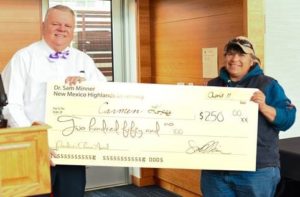
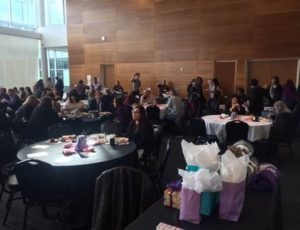
- There was a research day at the School pf Pharmacy on the UNM campus this week and there were two proud HU alums who took first-place honors. Mr. Sebastian Medina won best poster by a pharmaceutical sciences graduate student and Mr. Marcus Garcia also took first places honors by a PharmD student. Colleagues, this is how the world gets better. We do all we can with our students at HU. They try hard and aim high after they leave us. And…great things happen for them, their families, and the world. So proud of them. Well done to all. Also, our Research Day event was held on Friday with lots of presentations from faculty and students. Many thanks to Mike Petronis and everyone who made things happen. A photo of our alums at the Pharm research event:
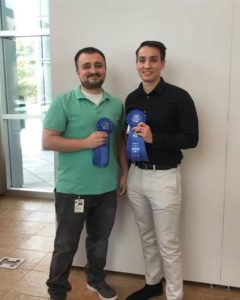
- Thursday was a busy one ending with a very nice event in the McCaffrey Historic Trolley Barn. The newly established Las Vegas Community Foundation (LVCF) honored their first grantees. Our mariachis performed a few tunes and The Skillet catered the event. I have served on several community foundations and I have seen the good these organizations can do. The LVCF is certainly no exception and I am honored to serve on that board. A photo of our troupe performing at the event:
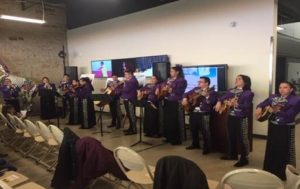
One of my first experiences taking students abroad was in the 1980s (man, a long time ago). I was a young Assistant Professor at Murray State University and saying “no” to any halfway interesting opportunity was just not in my vocabulary. The program was called the Consortium of Colleges for the Study of Britain (CCSB). For three summers, I was responsible for American students who spent pretty much the entire summer in London with side trips to Edinburgh, Stonehenge, Dublin, Paris, and a few other spots. Students studied all kinds of disciplines and somehow—I have no idea how—I wound up in charge of the program and as has typically been the case in my life, I really had no idea what I was doing. The students were mostly college freshmen and sophomores, but we always had a pretty good contingent of younger students who had just graduated high school and were planning on attending university in the fall. In other words, lots of them were young. We flew over as a group and the CCSB rented an entire campus—Queen Elizabeth College—located in West Kensington. It was a really nice area of London—close to the Underground, hundreds of shops, restaurants, and pubs, and right next door to the home of Christopher Reeve, aka Superman. I occasionally saw Reeve working out on the streets in front of his home with the English weightlifter, David Prowse, who interestingly, was the person in the Darth Vader suit in the first Star Wars film. Both of them were always really friendly, but then again, I didn’t ask for an autograph or anything. I should also note that I think the only showroom for Bristol automobiles—an exclusive and handmade line of sport cars—you can buy a Bristol Bullet for about 300K—is on the High Street. Clearly, you’d have to have more money than sense to pay 300K for a car, but I guess if you have that kind of money, it doesn’t matter. I’ve also heard that the owners of Bristol decide if they will sell you a car—not the other way around. Just because you have the money and interest does not mean you’ll get one. That’s pretty exclusive I’d say. At any rate, quite a few of these students were very young and most of them had never been abroad. I can’t quite recall how it worked, but some of them had scholarships for the trip so we wound up every summer with students from all socioeconomic levels including poor kids from Kentucky, Tennessee, and other states, which was nice. Some of them had never been beyond the county lines where they grew up so this was a really big deal for them and some of them (and their parents) were really anxious about it. This was London—one of the most incredible cities in the world, where everyone spoke English (of a sort), and where familiar American businesses, restaurants, and so on were on every corner. It was pretty familiar to most of our students, at least on the surface, except people drove on the wrong side of the road. And yet….every summer a dozen students or so were so anxious over there…so scared…so homesick…that they couldn’t really handle it. Although I had no clue about what I was doing (I won’t mention that again), I did anticipate that some students would have these issues so my colleagues and I planned several “group” excursions designed to make students more comfortable. We rode the Underground as a group and became familiar with all that. We went to the Tower of London and did that tour. We went to Kew Gardens. We visited one castle after another. That wasn’t fun—at least for me. We went to the theater—over the three years, I literally saw The Mousetrap nine times—eight more than I really enjoyed. But during the evening, the typical attractions were closed and some students continued to be anxious about going out on their own. They holed up in their rooms and would not come out. Not good. There was an Odeon Cinema about a block from the college we rented and we told students we’d have a film night every Wednesday. If they were interested, join us. The very first week of film night a film titled Reuben, Reuben was screened at the Odeon. I had never heard of it, but it really didn’t matter. The idea was to get students out and do something. It wasn’t about me seeing a film I was personally interested in. Reuben, Reuben is a dark comedy starring a really great actor, Tom Conti, who was nominated for an Academy Award for his performance in that film. It also starred a very young Kelly McGillis (not sure, but may have been her first starring role). The film was adapted from a play, Spofford, which was adapted from a novel with the same title as the film—a classic page to stage to screen progression. The main character is loosely based on—maybe “inspired by” is a better descriptor—the life of Dylan Thomas, the famous and I would say infamous Welsh poet. The Tom Conti character has an affinity for great meals (if someone else paid for them), strong drink, and…Kelly McGillis…a woman half his age. He is a poet, but can’t quite get things together enough to produce any new work. I won’t give away any more of the plot, but it is a good film. I should also note that the Reuben in the film’s title is a rambunctious dog and well…Reuben plays a key role in the film, especially the ending. A few days ago I saw that this film would be on TV and I recorded it. In the final scene of the film (again, I won’t say more), the Tom Conti/Dylan Thomas character is reflecting on his life and trying to finish his first poem in many years. The poem is untitled, but I think quite good.
So, in honor of all academics who courageously take students abroad to experience the world—almost always a life changing event for them, lurching along in life and somehow and someway winding up responsible for all kinds of things you know nothing about but having a lot of fun along the way, in my opinion, the first (1978) and best Superman movie, Kensington High Street—regarded as one of the best shopping streets in the world, the very cool, very fast, but also very expensive Bristol Bullet, Dylan Thomas who really enjoyed shocking party goers during his 1950 lecture tour of America, to everyone who rages against the dying of the light, Kelly McGillis who is a pretty decent actress, but just wasted her talent on the Top Gun film with Tom Cruise (classic lines from the film: Maverick: “I feel the need …” Goose: “… the need for speed!” I mean is that lame or what? Maverick? Goose? Really?), and the many joys of the Digital Video Recorder (DVR), one of the best inventions ever made…a kind of dark poem (actually the last lines) from the film Reuben, Reuben:
Untitled Poem From The Last Scene Of The Film, Reuben, Reuben
Come, let us spread a picnic upon the precipice.
Eat, drink, and be merry
And turn our backs to the abyss.
Til in that dusk, where bats cannot be told from swallows,
Nor gilt from thread
And we will banish solemn songs like this.
This is our hopeless heaven,
these flowers our eyes have watered,
wine drawn from our veins,
tunes piped from hollow bones,
and gaiety pouring from every wound.
The Erudite Bella says, “Can’t say I enjoyed the humiliation of wearing a birthday hat, but loved, loved, loved the pupcake treat at Flea’s adoption party.”

Sam Minner,
President
Colleagues. A brief update for the week April 1-April 5
- On Monday I attended the New Mexico Society of Human Resources Management (SHRM) meeting in Albuquerque. This was a large statewide meeting bringing together HR professionals from throughout the state. The two-day meeting began with some remarks from Lt. Governor Howie Morales and included various other sessions from notable state and national experts including Alicia Keyes, Cabinet Secretary of Economic Development, Vince Kadlubek, the Co-Founder and CEO of Meow Wolf, and Johnny C. Taylor, the President and CEO of SHRM. Perhaps you’ve seen Mr. Taylor on some television commercials—SHRM routinely runs them on various networks. This was a very successful meeting and quite upbeat—it really feels that New Mexico is on a positive path. Dr. Denise Montoya, our HR Director and current President Leadership Fellow, was the key to organizing this meeting and I thank her for her efforts. A photo from the meeting with someone on his phone instead of paying attention to the presentation:
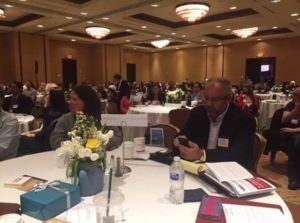
- Given the job I have I routinely receive feedback about student concerns and issues—some negative experience in one of our offices, a professor not in her or his office during posted office hours, etc. I hear the whole range as you might expect. One of my recent favorites, “There are too many weeds in a certain area of the campus” followed the next day by another individual, “Heh, why did you cut down all that beautiful greenery?” I feel it is part of my job to handle these as best I can and I do so as quickly as I can. As you might expect, it is far less common for students (or others for that matter) to take the time to write or call me to express their thanks for the job we are doing at HU or to name a specific person as someone particularly helpful or meaningful. However, this week I received quite a number of those positive messages. One student (unnamed, of course) wrote me to thank Dr. Eric Romero who was described as “very passionate in helping us to think about who we are as individuals”. Dr. Denise Montoya was described as a “very motivational, energetic and compassionate professor who loves to see all of us reach our potential in life and she gives us the knowledge and skills to reach our goals”. Another students commented, “Mr. Leon Bustos is a great inspiration and the soul of HU.” I always thought Leon had a lot of soul. I guess I was right. A parent at the meeting in Albuquerque (see above) commented that her daughter was in one of Dr. Jessica Snow’s classes and went on at some length about how much her daughter admired Jessica. Yet another student dropped by my office to comment on her very positive experience in Dr. Lindline’s class. A lawyer I met with this week (an opposing counsel, no less, so not someone inclined to be all that friendly to me) commented on how positively his daughter was treated by one of our coaches. Apparently, this attorney’s daughter is interested in playing on one of our teams. Hearing just these few comments this week suggest to me (and really, I already knew) that there are so many more good news stories about our work with students, how we treat them, and the high efforts of our good faculty and staff make. There is plenty of good news…I just don’t hear about most of it. I thank the faculty and staff of HU for going the extra mile and I feel fortunate to call them my colleagues.
- University Relations is working with HU Athletics to designate approved logos and marks for our athletic program. Some time ago, we adopted a policy for the university generally and we’ve been sticking to that since. There’s maybe been a few slips, but we try to stick with the standard. However, when it comes to athletics, we really don’t have a policy or even any guidelines about logos and marks. Sometimes we use the cowboy on a horse graphic, sometimes we use the block H, sometimes we still use the NMHU in front of a mountain landscape, etc. There just isn’t any standard. We’ll work on that, make a decision, and use that going forward. I suppose we could just use our institutional mark for athletics. We’ll see how that works out. The official and approved mark of the university:
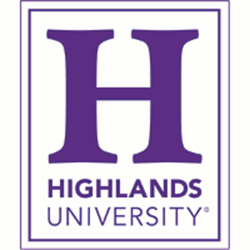
- The NMHU Student Regent was recently named and we now have a full board. Our Student Regent, Ms. Rebekah Peoble, is the sitting President of the NMHU Student Senate. I am confident Ms. Peoble will be an excellent regent and will do all she can to promote the institution and help us serve students in even more powerful ways. Our complete board consists of Mr. Leveo Sanchez, Mr. Frank Marchi. Ms. LouElla Marr Montoya, Mr. Bill Garcia, and Ms. Peoble. I should note that my efforts to expand the board to more members including a faculty member did not prevail in this legislative session. I will try again next year.
- On Wednesday, I joined an HU contingent to visit the NMSU Forestry Research Station in Mora. Highlands has developed numerous connections with that facility over the years and I visited in part, to prepare for the upcoming accreditation visit from the Society of American Foresters. There is incredible work going on out there and a number HU professors and students are involved in fieldwork, research of various types, publications, etc. The accreditation visit will occur soon and I have reviewed the substantial accreditation report prepared by numerous faculty members, but led by Josh Sloan. It is extremely well done and a model of what happens when dedicated faculty and staff members work together at a high level. It is really an impressive effort and a unique and strong HU program. A photograph of one of the greenhouses at the Research Station located in Mora and one of the researchers there patiently attempting to explain to me (sometimes successfully, but in truth, sometimes I could not quite follow) the science of forest restoration:

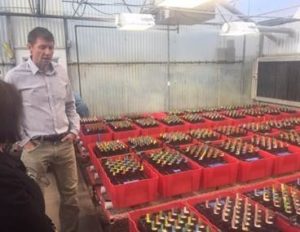
- Our Strategic Enrollment Management Team participated in a two day workshop this week. The workshop was titled “Yield Boot Camp” and our facilitator talked about best practices in communicating with prospective students, their parents, and others. Basically, how do you increase yield from the pool of interested students? The session was led by Ms. Jeanne Gosselin of Paskill, Stapleton, & Lord. A photo of Ms. Gosselin leading the session:
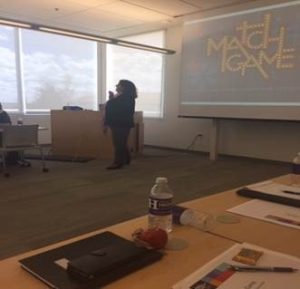
- The Office of Campus Life has secured a bus to transport students/faculty/staff to the University of Denver on Saturday, April 6. The Mighty Vatos will be playing in the Final 8 PAC West against Cal Maritime. The bus will be leaving the parking structure across the Student Center, along 8th street, promptly at 6 am on Saturday. The game is scheduled for 12 noon. The bus will leave Denver and return to Las Vegas promptly ½ hour after the game has ended. Should you wish to reserve a seat on the bus please stop by, email, or call the Office of Campus Life with your name and a contact phone number. Let’s cheer the Mighty Vatos on to another national championship! As they say, “The only pain in rugby is regret.” Go Vatos!

- On Wednesday evening Joan and I attended the banquet where we recognize various student achievements and name the staff and faculty member of the year. It was a very nice event. Thanks to everyone who attended and congratulations to the winners. A photo of Dr. Chris Stead honoring the chemistry students of the year:
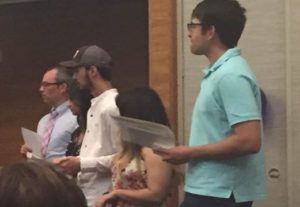
- The HU Board of Regents met on Thursday. They honored Dan Padilla for his service on the board and then went immediately to the critical agenda item—tuition and fees for 2019-2020. These are always tough meetings. Should we make a change in tuition and fees? Cut them? Leave them alone? Raise them? Believe me, I don’t think I’ve ever known anyone happy about raising them. And yet, people want (and deserve) salary increases, students want (and deserve) improved services or at the very least, no reduction in services, and I think most people agree that we have to find a way to somehow move forward with new things…new programs, new services, etc. Of course, all that takes money. Often the kneejerk reaction is to recommend that universities simply “reallocate resources”—administrative lingo for cutting things—and sometimes that has to be done, no doubt. I’ve done it many times over my career. But I ask you…can you think of any organization that somehow and someway cut their way to excellence? Cutting to avoid a catastrophe, yes. Cutting to avoid the sky falling, yes. But cutting to make things great? That’s very hard to do and I’ve never personally seen it. As I’ve said many times, HU is just a small part of a much broader picture of what is going on in public higher education funding. The driver and major cause of tuition and fee increases is not boards increasing tuition because they just think that’s a good idea. All this happening due to the disinvestment by government in public higher education. As state funding decreases, the resources necessary to operate a public institution must come from somewhere and, of course, there is really only one main place it can come from—-students. Check out this article: https://www.cbpp.org/blog/by-disinvesting-in-higher-education-states-contributing-to-affordability-crisis. If you open that link, you’ll see that New Mexico had the seventh largest reduction in state funding for higher education of all states in our nation—a 34% reduction from 2008-2018. I am not an economist, but this is what that means to me—we lost 34% of our funding over that period. Where did the money to operate come from? Students. That is really tragic and it simply must change or we are all in for a wild ride. Two other troublesome dynamics are at work in all this. The first is what is called Baumol’s Cost Disease. Again, I’m no economist, but this notion suggests that some activities cost more than they used to even though there are no real productivity improvements. The classic Baumol Cost Disease example—it cost more, much more, to play a Beethoven quartet today than it did in the 19th Century. Why? Well, you need the same number of people and instruments and so on to play today as they did back in the day and yet, salaries and benefits have gone up a great deal since the 19 Century. I can’t imagine anyone received any benefits in the 19th Century. Hence, you hear and experience the same thing people heard way back then, but it costs much more. In a sense, this activity is immune from theories of classical economics. Many have suggested that what we do in higher education is also influenced by the Cost Disease. Back in the 1800s, university classes were led by a professor, a little bit of equipment (chalkboard, whatever), and lots of interactions between students and a skilled teacher. It was a human thing. The “costs” were all about paying people to do things and not just any person—it had to be a highly knowledgeable and skilled person. Today, well……it works pretty much the same way. Back in the day, professors were paid whatever they were paid and today they earn more (still not enough, in my view), so the basic human activity remains the same, but costs have risen. Baumol’s Cost Disease in action. Critics of what we do (I would say naive critics) suggest we just put everything online, teach hundreds or thousands at one time, and break the dynamics of Baumol’s Cost Disease. First, handling things this way is not always cheaper, especially on the front end, and more critically, doing things that way works great for some students, but not so great for others. A stay-at home parent transitioning to some new career might do well in that kind of environment. A poorly prepared 18 year old student who doubts her or his ability to make it at university and needs a lot of individual attention will probably struggle with that model. Maybe quit altogether. A second big issue with adding or decreasing tuition has to do with the changing demography of university students. Just about the only sub-groups of university students increasing in American schools are poor students, first generation college students, and poorly prepared students. In other words, students who have struggled in American higher education and in some cases have not even been welcomed. No one wants to add to the debt of these particular students so there is a tendency to not increase tuition or to even cut tuition. The problem with that is that these students often require lots and lots of ancillary services and programs and those cost money. The pinch point is—let’s not increase tuition for those students, but in a time of diminishing state support, that means less services and programs for students who desperately need them. If you can’t find a way to provide what they need, it can actually decrease their chances for success. This is really an example of hegemony. As I mentioned, it is tough to find a way through all this. I appreciate the careful thought the regents gave to it on Thursday. I’ll be sending out a more detailed summary of the actions the Regents took as soon as possible.
- On Friday I recorded a three song set—a kind of tribute—to Jim Burns who recently passed. Jim and I frequently met to talk about all kinds of things, but we always gravitated to Americana music. We shared a love for that genre and often played a game of “do you know this artist” or “have you heard of that song” and his knowledge of Americana always impressed. I’ll inform everyone when the tribute will be aired.
- James Hearst, sometimes called the Robert Frost of the Midwest, was an acclaimed and pretty prolific American poet and professor at the University of Northern Iowa. Growing up in Iowa, James was raised on a farm and like so many who have that experience, came to love the natural rhythms of rural life and the ways of rural people. I can certainly relate to all that. As a young man, James dove off a dock into a too shallow Cedar River and was left paralyzed for the remainder of his life. He was only nineteen years old. He came up with some pretty creative workarounds to keep farming, but eventually his health deteriorated and he turned to writing—mostly poetry, but also an autobiography, a book of essays, and other works. Most of his writing focused on rural themes, especially farming. Joan and I once lived on a farm in Northeast Missouri (actually pretty close to the Iowa border and on several occasions a border I came very close to due to the fact that one of my horses would not cross water so I had to keep riding north until I could get him turned around) and we worked hard at being rural people. We lived in Greentop, Missouri—population about 250 and we were looking for a change—something rural. Of course, we failed at the rural life quite often and sometimes hilariously, but it was so much fun. We lived in a three story brick pre-civil war farmhouse surrounded by outbuildings, horses, pastures, a creek, and a pond. A couple bright green and yellow tractors were in the barn. A John Deere 790 was my favorite. I had a pretty intense job at the time and nothing soothed the soul more than heading home on a mile and a half gravel (mostly dirt) road (no use washing your truck—rural people quickly just give up on that) , changing out of my suit into torn jeans, a work shirt, a Carhart jacket, and a St. Louis Cardinals ball cap and getting on the tractor for what I called “tractor time”—my time to forget about a boss who could be pretty tough to work with/for, budgets, personnel problems, someone upset about a MWF teaching schedule instead of a TTh arrangement, and all the rest. My favorite activity was cutting down the weeds in our pastures. I could put on my music, put a drink in my official John Deere cup holder, and pretty much let my mind go—or so I thought. I was quickly informed by real farmers and I later personally confirmed that cutting brush was one of the most dangerous jobs on the farm. Now this was the Midwest where it rains all the time—moisture is not a problem there—and weeds can literally grow eight feet high. Much of the time you really couldn’t see what was right in front of you as you were cutting things down—a downed tree, a log, some animal just resting there (I still have Stephen King level nightmares about those occurrences), a creek bed that had shifted after the spring floods—you just didn’t know. So, one minute you were cutting weeds down, sipping a cold beverage, and listening to Lucinda Williams or our neighbor at the time and bluegrass star, Rhonda Vincent, and then…boom…you hit something. The big fear was that the tractor would buck up and you’d fall off the back of the darn thing onto the rotary cutter—often considered the most dangerous implement in the barn. They didn’t call it a “cutter” for nothing. That never happened to me, but I came close a few times. Implements were important on the farm. If you had a tractor and no implements…well, you had nothing but a slow ride to town. So you had to have them. A lot of them. And most of them cost quite a bit. One implement in our barn was the plow and I do like that line in Hearst’s poem—As I scrubbed the rust from my brightening plow. I’ve actually done that very thing a few times. We needed a plow to prepare the ground for our crop of grapes to make wine under our label, Hickory Hills Vineyard. We grew a hybrid of Maréchal Foch grapes that worked pretty well in the high temperatures and wet weather in Northeast Missouri. Foch wine, as it is sometimes called, is inky purple with notes of toasted wheat, fresh coffee, and bitter chocolate (I try use my wine snob language when I can—I really have no earthly idea what any of that means). To plant the vines, I needed to break the ground. That required a plow. New plows were hundreds of dollars, but there was another way. In the rural area where we lived, there were always farm auctions where you could pick up implements of various types and Joan and I saw a listing for an auction advertising a two bottom plow. For those not in the know, a two-bottom plow has two moldboards or discs allowing you to plow two furrows at once. In short, you can get more work done faster with a two bottom plow. We met an older woman at the auction and we came to learn that she owned the place and all the items stacked on farm wagons and piled in the yard belonged to her. She was selling all of her farm equipment—her husband had passed away and she was getting out of the farming business altogether. Hence, the auction. We got to talking with her about her farm, our farm, what she and her late husband grew, why we needed the plow, her kids, our kids, etc. I could tell that she was pleased with our story…a professor…a doctor, nonetheless (she emphasized those words) and his wife embracing the rural life—wonderful! I assured her I wasn’t a real doctor and I did not require anyone to address me that way since…oh, I don’t know…six months after graduating from the University of Arizona., but she was undeterred—she kept telling everyone that the doctor and his wife were going to go home with her plow and believe me, the real and true farmers at the auction were not impressed with that. Or me. At any rate, it was totally obvious that she desperately wanted us to get that plow. I think she saw something of her younger self and her younger life in us and that was really meaningful to her. The auction started and after a couple hours of bidding on boxes of Mason Jars, wooden containers of rusted nails, nuts, and bolts, Avon commemorative pieces, sharp and pointy farm tools of unknown utility or purpose and looked like something hanging in the barn of The Texas Chainsaw Massacre movie set, and other assorted odds and ends of farming life, the auctioneer finally got to the plow. The plow was sure enough two bottom, but also had a coulter. You have to be pretty hard core farmer to know what that is. A coulter is a piece of sharp metal that cuts an edge about 7 inches deep ahead of the plow. It makes plowing easier and more efficient. So, what I was looking at was a two bottom plow with a coulter. Up for bid. There was no hurry at these events. They were as much about socializing or as they say in the Midwest, about “fellowship” as buying something. The bidding on the plow finally began. The woman stood right next to me…the doctor…and kind of nudged me every time someone outbid me. I mean…I knew I was outbid…I really didn’t need someone else telling me that, but she was determined. The whole deal changed for me. I thought I was there to maybe buy an inexpensive plow. Unbeknownst to me, the cosmic reason for being there, apparently, was to make certain this woman I really didn’t know was not disappointed in the fate of her two bottom plow. The bidding went higher and higher—I mean, it was approaching the cost of a brand new plow and the one I was bidding on was old—it looked like it could have been used in the Depression or the Dust Bowl or something— but given the circumstances I felt we just had to get the darn thing. No matter what. And we did. Joan and I somehow loaded the plow that seemed to weigh a ton in the back of our Chevy truck and we drove away with the woman we did not really know waving and smiling at me…the doctor…and his wife. I wasn’t pleased about what I paid, but I must say…Joan and I were smiling too. Something good had happened in the world that day. Who knew that a two bottom plow (with coulter) could mean so much to anyone.
So, out of respect to Mr. Hearst’s unfortunate accident that ended his farming career, but perhaps contributed to his prolific and wonderful career as a poet, everyone who courageously makes a change in life and tries on a totally different way of living (e.g., suburban to rural, big city to small town, Chicago to Las Vegas, NM (shout out to Beth and Mark),on my best day a fair to middling university president to on the best day…someday…an untrained and very poor poet—just a thought), gravel/dirt roads that make it utterly impossible to keep your truck clean, the bright green and yellow colors of anything and everything John Deere, Marshall Foch who helped negotiate the end of WWI and later was honored with a grape variety bearing his name, the utter banality of wine snobs, Lucinda Williams’ best record (in my opinion), Car Wheels on a Gravel Road, plows one or two bottomed with or without coulter, and the well-worth-it price of pleasing someone who is reflecting on her life and is so happy that others have in some even small way honored her experience (even if doing so costs way more than it should), the poem of the week: In April by James Hearst:
In April
James Hearst
This I saw on an April day:
Warm rain spilt from a sun-lined cloud,
A sky-flung wave of gold at evening,
And a cock pheasant treading a dusty path
Shy and proud.
And this I found in an April field:
A new white calf in the sun at noon,
A flash of blue in a cool moss bank,
And tips of tulips promising flowers
To a blue-winged loon.
And this I tried to understand
As I scrubbed the rust from my brightening plow:
The movement of seed in furrowed earth,
And a blackbird whistling sweet and clear
From a green-sprayed bough.
The Erudite Bella says, “Love my toys, but believe me, having an opportunity to chase that pheasant in the poem would be a Chocolate Lab dream come true. Not saying I want to catch it…just chase it.”

Sam Minner,
President
Greetings colleagues. A brief update for the week March 25-29:
- I completed a national phone survey this week focusing on why the number of students in teacher education programs continues to drop. I think about 100 presidents and chancellors around the country were randomly selected for this study. Virtually all schools and college of education across the nation, including HU, are in enrollment decline. In the 1970s, around 220,000 students graduated each year from schools and colleges of education. Today, the number is less than 100,000 and going down at a precipitous rate. Students in 2019 simply are just not that interested in teaching careers. A few other troubling trends—there is a real mismatch nationally between what students who are enrolled in teacher education programs are studying and what types of teachers are needed in K-12 schools. Schools need bilingual teachers, science teachers, math teachers, and special education teachers and we are simply educating too few of them. The average age of Professors of Education (now around 62) is sometimes an issue. Some of those professors have not been in charge of a classroom for many years and some critics have suggested they are a little out of touch with the many changes in K-12 schools. Attrition also continues to be a problem. New teachers leave the profession in droves. A 50% attrition in the first several years is a common finding. One recent study in the Midwest revealed that after four years, only about 10% of teacher education graduates were still teaching. Just 10%. Wow. Some have suggested that the precipitous drop in the number of students going into teaching is perhaps at least partially due to a positive development—the expanded opportunities available to women today. Back in the 70s, women often majored in nursing or teaching. Today, that is much less true. There are more options. Others suggest that the low numbers are due to the lack of respect shown teachers, the lack of agency they are allowed in their daily work, the crazy testing culture where little kids (and their teachers) are subjected to high stakes testing with little or no relationship to the curriculum, the promotion of drill and kill teaching methods so kids do well on those tests, and on and on. So, as is the case in many situations, the challenges in this domain are not unique to HU. Still, we must do what we can to get more students into teacher education programs without reducing quality or bending any standards. How to do this? Colleges and universities are trying a variety of things—more clinical and or in-situ experiences, more Professional Development Schools, actively recruiting more mid-career professionals, doing more online programs, forgivable loans, etc. HU and the state of New Mexico are trying most all of these things, but problems persist. The only real hope of improvement, according to some, is for faculty members in schools and colleges of education (and others) to work at a more macro and policy level with elected officials to make teaching a much more attractive job. I think of what is called the “Finland Dream”—in that country (a consistent top performer when it comes to K-12 outcomes) , getting into a teacher education program is extremely tough. Only the best students need apply. Less than 10% of applicants are accepted. All teachers there are active researchers…not merely consumers of research. Finnish teachers are highly respected and even honored in their local communities. They receive top quality and ongoing professional development. The school day there is shorter than in America, teachers give much less homework, and teachers are provided paid time to collaborate, share ideas, and complete collegial critiques of lessons. Basically, the whole system there is quite different than how we manage things in the USA. Perhaps these types of structural changes are what we really need to work on. Paying teachers more (and that will apparently happen in New Mexico) is absolutely needed, no doubt, but…if the problematic structural issues related to the profession do not change, it might not really make all that much difference. Increased compensation might be part of the solution—not the entire solution. If people have any other ideas about what we might try to recruit more students into teacher education, I welcome them. Here’s a link if you care to read a bit more about this issue: https://www.washingtonpost.com/news/answer-sheet/wp/2017/09/18/where-have-all-the-teachers-gone/?utm_term=.9517d6377bfb.
- Thanks to everyone who attended Monday’s HLC Update—this one focusing on Core Component 5A: Institutional Finances. As you may recall, to address the concerns of the HLC relative to 5A, we needed to do four things: (1) present evidence that we are not relying so much on the state to meet our fiscal needs (that is, relying more on tuition and or other sources of revenue), (2) present evidence that we have no repeat audit findings and ideally, no findings whatsoever, (3) present evidence of a clear strategy to recruit and retain more students, and (4) demonstrate a stronger Composite Financial Index or CFI (a statistic capturing the institution’s overall fiscal health). I am pleased to say that we are addressing each and every one of these issues. For example, in regard to #1, we now have a BoR policy requiring us to build up reserves and we have done and are doing that. The modest tuition increases we’ve had have helped enormously and still, we are the most affordable four-year school in New Mexico. In regard to #2, we have a detailed recruitment plan and some evidence that the plan is working (e.g., a modest increase in new freshmen this year), in regard to #3, all previous audit findings have been cleared, and in regard to #4, our FY 2018 CFI is 2.27—up from .02 in FY 2012. We’ve got an upward trend line in regard to our CFI. A photo from the HLC session:
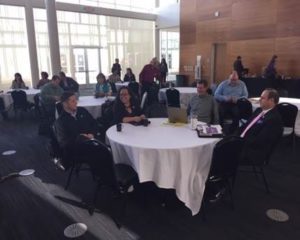
- On Tuesday, I attended an early morning meeting at Luna to visit with their accreditors. This was an important meeting for Luna—a few folks from the community, some LCC employees, a couple representatives from LANL, and of course, a contingent from HU. Let us hope that our in-town higher education colleagues do well during the visit and move forward in a positive way.
- This week I had an interesting discussion with an elected official focusing on economic polarization and higher education. Within the last year (and for the first time in the history of our nation) public colleges and universities in most states accrued more of their revenue from students—that is to say, from tuition—than state appropriations. In 1992, only about three-tenths of the total education revenue came from tuition. Today, tax dollars pay for less than half of what it really costs to educate someone at university. Students pay the majority of the costs. This is true at most universities….it is not true at New Mexico Highlands. You hear a lot about how much New Mexico universities receive from state government or what percentage of total costs come from the state and that is all true. I think one could argue that at a public university, that should be the case. But, as I wrote, in most states it is not. Today, HU receives about 70% of what we operate on from state government and about 30% from tuition revenue. I have worked at some institutions where the state governments contributed less than 10% of what it took to operate. As the saying went, those schools were “state situated” (that is, located somewhere in the state), but not really state supported. As I wrote, this isn’t true at HU or other state universities in New Mexico. I predict this will change (really, it is already changing) and like most universities across the nation, we’ll come to rely more and more on tuition revenue. I’m really not happy about that, but the national trend is very well established and we are a bit of a lagging outlier. If I am correct, that means we must bring in students to pay what remains the most affordable tuition of any four-year university in New Mexico. Another alarming issue related to all this is the very real fact that while state (public) support for higher education is waning, just about the only demographic groups adding to the total college population are students least capable of paying the bill—first generation students, poor students, students from weak high schools, etc. Is this occurring by chance or might it be an example of hegemony in action? Good question.
- I strongly encourage everyone to attend the 16th Annual NMHU Faculty and Student Research and Creative Showcase Day on Friday, April 12. More details are forthcoming. This is an important day on our campus and we should support the event in every way we can. My favorite research quote and certainly true in my case:Research is what I’m doing when I don’t know what I’m doing. Wernher von Braun
- At this time of the year, we carefully monitor the number of admitted students and I pleased to report that compared to the same week last year, we are up a bit—up 41 students. Forty-one students doesn’t sound like a lot, but given our faculty to student ratio…you can see what this means. We are up 23 new freshmen (a student is a student, but this is a critical category) and also up in transfer and international students. Thanks to everyone in recruitment (and everyone else) who is pushing hard in a tough recruitment environment.
- We recently installed the last piece of public art we purchased last semester. All of the pieces really look great and I’ve heard numerous positive comments about them. Well done to all who helped make this happen. A photo of the final piece being installed:
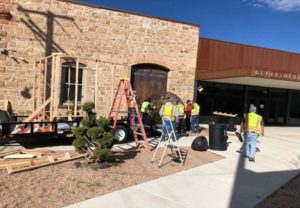
- The time period for our students to participate in this year’s National Survey of Student Engagement (NSSE) is now over. We wound up with a response rate of 28.5% and that is really quite good. I’ve worked on campuses where the response rate was in the single digits. Many thanks to Lee Allard, Shawn Flood, and Ivy Romero for their great work as well as Sean Weaver and his team to push this out on social media. We won’t get our results until August, but when we do, I’ll let everyone know what they look like.
- Please try to catch the screening of the documentary, The Providers, on PBS on April 8 at 9 p.m. and April 13 at 10:00 p.m. The film focuses on the challenges and rewards associated with providing healthcare services in rural areas. Our healthcare provider, El Centro, appears in the film and some of the doc was shot in Las Vegas. The film has won numerous awards at festivals around the country. Here’s a link if you care to screen a preview: http://www.pbs.org/independentlens/films/the-providers/.
- On Tuesday, I welcomed Dr. Kate O’Neill (the new HED Secretary) and her Chief of Staff to the HU campus. They visited with a group of faculty members, staff members, and administrators. We had a free and open and I would say quite a wide ranging discussion about higher education in New Mexico. From my perspective, it felt very honest, and frankly….hopeful. Over lunch she said to me, “We are in the hope business” and I just loved that. That’s true of all us in higher education, no? Many thanks to her for taking the time to visit our campus and her selfless dedication to New Mexico and the higher education sector here.
- Loved the cool photo and the quote from this week’s Voices of HU posting on our Facebook site. HU career peer adviser Dorian Miranda is a current freshman at Highlands University. Dorian’s favorite HU core value: Accessibility. He asserts, “Most students in this country who graduate from high school have to figure out how to pay for college themselves. Highlands is really accessible.”

Photo by Samantha Madrid, NMHU
- On Thursday I joined a contingent of HU Recruiters on a visit to Bernalillo High School. We met with school administrators, Pueblo officials, and some students to share the many assets and advantages of attending HU. A photo from that school visit:
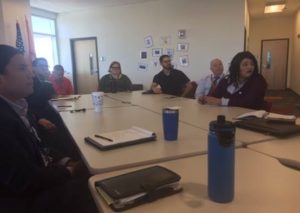
- Later on Thursday, Joan and I attended the opening reception of HU’s Ghost Light Project. This project is designed to promote reflection about the importance of human diversity on our campus and in our personal lives. Seventeen Ghost Lights will be installed around the campus. The final activity of the Ghost Light Project will be the premiere of the play Fall Out at 7:30 p.m. on Friday, March 29 in Ilfeld. The play is free and open to the public. Please note that the play does contain adult themes and language. HU alumna , Patricia Crespin, wrote the play. The playwright said she was moved to write the play after the 2016 election and all the bitterness and divisiveness she observed. I strongly encourage everyone to attend the play and when you see one of the lights on campus, please take just a moment to reflect on the value of the human spirit and how human diversity enriches our world and lives. Thank you, thank you, thank you to everyone who put this together.
- Farmington native Ms. Chevel Shepherd, winner of the 15th season of “The Voice,” will be on our campus on April 27 to do a concert in Ilfeld Auditorium. This is an Arts@HU event and is free to all HU students. A photo of Ms. Shepherd:

Courtesy Photo Chevel Shepherd
- Spring is a season that’s inspired lots of poets. There’s When Lilacs Last in the Dooryard Bloom’d by Walt Whitman, Lines Written in Early Spring by Wordsworth, Melancholy by Edna St. Vincent Millay, and then we come to The Trees by Philip Larkin. Larkin was kind of an unusual character…to say the least. He was an English writer, but was perhaps more broadly known as a librarian. He devised the GEAC System—an early library management software program ultimately adopted by numerous libraries including the US Library of Congress and the Bibliothèque Nationale de France. He was offered the Poet Laureate position in England, which he promptly refused and returned the offer letter after scribbling some pretty colorful profanities on it. He disliked being in the public eye and allegedly went out in disguise so no one would recognize him. He was quite the curmudgeon and was well known for being a little hostile at parties. He once said, “My idea of hell is a literary party” and he apparently made certain that others in attendance agreed. Come to think of it, I’ve attended a few that were pretty bad so maybe he was right. His letters (mostly to his mother—another weird dimension of his life that I’ll not go into) published posthumously have been described as “hair raising” yet also “hilarious”—he had some really weird ideas about all kinds of things including a few not really appropriate for this blog or for that matter, to send to his mother. He supposedly detested cars and stated on numerous occasions that he would never own one. Or even drive one. When he did drive, he liked to drive in reverse…I have no idea why. Things changed when he met a person he was interested in and apparently she liked to dance. That meant he had to get to dances and at that point, his disdain for cars kind of dissipated plus it was really tough to drive to dances totally in reverse so he pivoted a bit and drove forward. He purchased a car—a Singer Gazelle (a pretty cool looking car for the day, but not fast—0-60 in about 20 seconds)—and the story goes he wrecked it the very first time he drove it. He was apparently not in reverse—he was equally bad driving forward or in reverse. The car was repaired, but he kept hitting things—other cars and occasionally, people—and I’ve read that people who saw him coming ran as fast as they could to get as far away as possible. His driving was that bad. He was known to somehow and someway maintain relationships with multiple partners and paramours—perhaps up to five at a time—and was so adept at managing those dynamics that others sought him out for advice about how to do the same. He even gave some lectures on the topic and charged people for the privilege of listening to him. Like I wrote…he was odd. He was also a pretty accomplished jazz critic, but true to form, it was rumored that he smashed the recordings he did not like and sent them back to the artists with really mean notes (e.g., Take that Dizzy Gillespie!).
So, in honor of spring, the challenges and in some cases, the banality of some literary (or let’s face it, in some cases, departmental or college) parties, the classy lines, but poor power of the Springer Gazelle, driving in reverse as much a humanly possible which comes in pretty handy if you are putting a trailered boat in the water and by the way, isn’t it kind of amusing to watch someone who can’t drive in reverse getting a boat in the water?, the drama of destroying recordings you do not like (try that with downloaded music…hitting delete is just not really that dramatic), and the 45 degree upward trumpet bell of Dizzy Gillespie’s horn, the poem of the week—The Trees by Philip Larkin. I do like that “greenness is a kind of grief” line. New life emerges from trees, but like all living things, in truth that means they are really only getting older (captured in those rings of grain) and someday will die. Just like all living things. Now that I’ve depressed everyone…the poem:
The Trees
Philip Larkin
The trees are coming into leaf
Like something almost being said;
The recent buds relax and spread,
Their greenness is a kind of grief.
Is it that they are born again
And we grow old? No, they die too,
Their yearly trick of looking new
Is written down in rings of grain.
Yet still the unresting castles thresh
In fullgrown thickness every May.
Last year is dead, they seem to say,
Begin afresh, afresh, afresh.
The Erudite One says, “Taking a ride in the car—going forward or backward—is always a good time. Put the top down on the little sports car and things are even better. As the person who lives with me says, that little car can go 0-60 in five seconds, but at his age, it takes him 5 minutes and lots of groaning to get into the darn thing. I really think that is funny.”

Sam Minner,
President
Greetings colleagues. A brief update for the week of March 14-22:
- I hope everyone had or took some time for some well-deserved R&R last week. Life including the academic life (irrespective of what people with no experience in that domain might say) can be very busy and stressful. Taking time for oneself is important and doing so should not result in any guilt although, frankly, I have struggled with that a bit over my career and life. Psychologists have studied this matter and there are empirically based reasons to spend time away from work and maybe even spend time alone. I think the general consensus is the busier one is, the more you are likely to benefit from some quiet time. Possible advantages of alone time include a potential increase in empathy. When you spend lots of time with the same people who tend to think like you (or you like them), it is easy to adopt a “we vs. them” mentality. That is, the group you commonly affiliate with vs. those not in the group. Time alone sometimes develops compassion for others. Spending time alone has shown to increase life/career planning. When you’re with others, there are usually many issues/concerns/problems to solve. Being alone helps you think about your own goals—away from other people and their potential influence. There a many other potential advantages of unplugging and just being alone. I hope you had or took the opportunity to do that over the break.
- Perhaps you caught a really nice story airing on KOAT TV about the wonderful work going on in our Media Arts program. Faculty and students there are working on a mobile app to assist hikers in the Los Alamos area. HU is providing all the mobile app development allowing hikers to see where they are, how to connect to other trails, and other features making hiking those trails more enjoyable and safer. Students working on this are on paid internships—an incredible high-impact learning experience for them and a real sweet spot at HU. Well done to the Media Arts faculty, staff, and students. Media Arts—one of the great strengths and assets of HU!
- This year’s legislative session is over and HU did well, particularly compared to previous years. Things still could change with the veto pen, but we anticipate that we’ll receive some additional resources for I&G (our basic operations) , $205K for a Native American Social Work Institute, $50K for CESDP, about $80K for wireless improvements on the main campus, about $165K for furnishings and equipment including some technology, about $119K additional dollars for athletics, $1mil for Rodgers, and resources to fund some compensation increases. Many thanks to everyone who worked hard to bring these much needed resources to HU.
- I recently heard that one of our good colleagues, Dr. Rebecca Alvarez, signed a contract for a book that will be published by Routledge in 2020. The working title is Vigilante Gender Violence: Mob Attacks on Women Worldwide. Congratulations to Rebecca on this notable academic achievement. Well done.
- The men’s basketball season came to an end last Friday afternoon. The Cowboys lost to West Texas 109-95 in the first round of the NCAA tournament. There was a nice HU crowd at the game. A generous donor paid for a coach to transport fans to Canyon, Texas and others drove up to see the game on their own. A few out-of-towners also showed up including our own Carol Linder who drove over from East Central University. It was a great season for the Cowboys and our coaching staff. They finished with the most wins in program history. They won the RMAC for the first time in the history of the institution and were the first 7th seed to do so in RMAC history. Congratulations to all. A photo of Raquan Mitchell who scored a career high 42 points in the game:
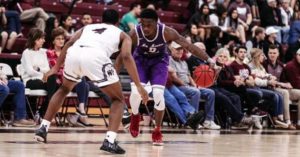
NMHU Cowboys’ Raquan Mitchell
- As many of you know, HU has been involved with the Rio Mora National Wildlife Refuge for many years. In fact, a visit to the Rio Mora was one of the first trips I made when I arrived at HU. Many colleagues are working hard to maintain or expand the activities at the Refuge, but none more actively than Brian Miller. Brian provides a historical perspective on the Refuge here: https://rewilding.org/rio-mora-conservation-science-center-at-rio-mora-national-wildlife-refuge/. It is well worth reading. We face some major challenges on the Refuge due to the fact that a major gift provided by Eugene and Clare Thaw is just about expended. Brian and others are working on multiple fronts to keep things going out there. Let us hope. HU faculty and students have gained such valuable experience there and we must do everything possible to continue that work.
- On Monday evening, Joan and I hosted another student dinner at the University Residence. This time we had dinner with the PRISM student group. It was really great to get to know them, their dreams and aspirations, and their thoughts about life at HU and life in general. I should also note that what I think is perhaps Las Vegas’ first Pride Parade will be held on April 27 and the HU PRISM group is leading the way to organize the event. A photo of the PRISM group (and the Erudite One) after dinner:
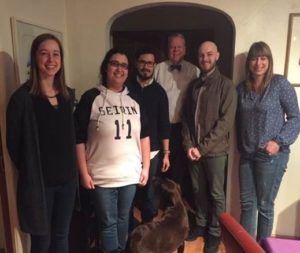
- I hope everyone had a chance to peruse the most recent SEM Newsletter that went out this week. If not, here it is: C:/Users/sminner/AppData/Local/Microsoft/Windows/Temporary%20Internet%20Files/Content.Outlook/8JKW5CUV/SEM%20Newsletter%20Issue%2011.pdf. The new office we engineered to help answer student questions continues to assist hundreds of students in an efficient way and the overall trend suggests that our students are using this service more frequently. The recommendation to use artificial intelligence to improve efficiency even further (read the newsletter) is a good one and I’ll look into it. It may be more costly than we can handle right now, but perhaps not. We also continue to add a number of activities aimed at increasing our enrollment. For example, we will be co-sponsoring a High School Athlete Scholars banquet that will bring dozens of top student athletes to our campus. Of course, we will do all we can to convince them to attend HU. We are talking with our colleagues at CNM about some data sharing and reverse transfer agreements in the hopes that will attract more of those students. We continue to contact students with 90+ hours of credit (but not enrolled) to see if we can help them. We recently phoned over 1000 students who have applied for the fall term, 2019 to answer questions and encourage them to show up in the fall. This week Dr. Martinez attended the All Pueblo Council of Governors to encourage them to send us their students. And more. We will continue to add new activities to attract more students to campus and or one of our centers. If you have other thoughts about what we might do, I welcome them.
- I did a “Facebook Live” interview on Wednesday. It focused on enrollment and fiscal issues, but a few other items also came up. You can catch it on our Facebook page or just go to: https://www.facebook.com/HighlandsUniversity/ . Scroll a few screens down on our page and you’ll see it. Also on Wednesday I welcomed a large group on our campus who were participating in a workshop by Mr. Brian Colón, the Auditor for the State of New Mexico. Mr. Colón said many nice things about HU and the work we are doing here.
- On Thursday, I attended an event in the SUB honoring the remarkable achievements of our men’s basketball team. The Cowboys’ 22 wins are the most in program history and the RMAC Tournament championship is the first in NMHU men’s basketball history. It was the Cowboys’ first trip to the NCAA Tournament since 2010. It’s the first time a school outside of Colorado has won the RMAC Tournament title in men’s basketball since 2006. The Cowboys were just the second No. 7 seed to make the RMAC Tournament championship game – and the first to win it. Gerad Davis was named RMAC Tournament MVP while Raquan Mitchell, Nnamdi Okoro and Desmond Carpenter were named to the All-Tournament Team, the first Cowboys in history to make the RMAC All-Tournament team (and the first RMAC Tournament MVP). Davis and Mitchell were also named to the South Central Regional Team as well as the All-RMAC team. Jordan Jones and Okoro were named All-RMAC Honorable Mention. And finally, the Cowboys concluded their season in the top 15 in the country in scoring. Truly a remarkable season. A photo from the event:
- Sticking with the HU student athlete theme (this time, club sports) I attempt to keep up with one of our great alums, Kevon Williams (NMHU Alumni, 2016 BA in Computer Science). Former colleague and Jefferson Fellow Dick Greene tries to keep me up to date when it comes to Kevon. The photo below is Kevon scoring against Chile in a recent match in Sydney. Kevon is a 3 year member of the USA National Rugby Team which is currently ranked #1 in the world in the second most popular sport in the world. He is perhaps the most watched NMHU student athlete ever. He plans/contracted to represent the USA in the 2020 Summer Olympics and subsequently return to a career in computer science. He often participates in front of >40K in stadiums and scores of millions on international TV/Web (ESPN, NBC, etc.). He is the model of an outstanding citizen and humble professional athlete—really a great representative of HU. He helped the NMHU Vatos to 2 National Titles, annual Final 8 finishes, and a national brand name. A photo of Mr. Williams in action:
-

Kevon Williams
- I recently learned that two very good HU colleagues will be leaving us. It is always tough when truly good and dedicated colleagues move away and I always try to find out the motivation for doing so. Sometimes it is simply going after a better or what is perceived as a better job. Sometimes people just want a change. Sometimes it just isn’t a good match between an individual and that person’s department and or the institution more generally. If academics keep up on their careers (and there is really no mystery about what that means)—they are competitive in searches and they can leave if they want to do so. There are all kinds of reasons to make a change and far be it for me to judge. I’ve moved many times in my career and for all kinds of reasons. I really loved every institution I left and came to love each new one. In this particular case, I did find out the reasons our colleagues were leaving and they were both gratifying and concerning. For example, I learned they both loved Highlands, our mission, and our commitment to serve our students who are the center of what we do. I learned that they will miss HU—they are not leaving because they have some big problem with the institution. Their decision to leave really had nothing to do with HU per se. As is often the case, the main reasons had to do with personal/family issues. This comes up time after time. Really, all too frequently. Those “personal/family” issues usually have to do with some combination of housing (too little housing available that works for them), jobs for trailing partners (really tough to find a decent job, but not relevant in this particular case), healthcare issues (having to drive one or two hours for healthcare , particularly access to some specialists), and schools (wanting more choices on preK-12 schools that work for them and their child/children). I think it is just too easy to throw our hands up and assert that there is nothing we can do about these matters. That is true to a point—we employ people to teach students, to discover new knowledge, and use what they know to serve humankind and make the world a better place. We are not land developers so we don’t build houses for employees. We don’t operate a hospital where employees get healthcare. We don’t operate a K-12 school. But…have we been involved enough in these issues to address the needs of many of our colleagues and frankly, to improve outcomes in the larger community? If we wanted to try to do that, what would first steps look like? I am giving much thought to all this and if you have ideas, I welcome them.
- I am so pleased to announce that the commencement speaker for the Las Vegas graduation ceremony will be Ms. Felicia Ortiz. Ms. Ortiz is an HU alumna and in 2012 was named one of the top 10 Latino Power Brokers in Las Vegas, Nevada. She is president and CEO of PM Solutions Consulting, a project management firm in Las Vegas, Nevada. She serves on numerous boards and is the only Latino member of the Nevada State Board of Education. Felicia is a fierce advocate for equity for all students and will share some of her life lessons including some acquired while she was studying at HU. She will address our 2019 graduates at the ceremony on May 11. A photo of Ms. Ortiz:

Felicia Ortiz
Courtesy Photo - Thanks to everyone who attended the Thursday morning Coffee With the President. All tables were filled as I discussed current campus events and some issues immediately before us. Also, thanks to everyone who participated via Zoom.
- Also on Thursday, Joan and I welcomed several faculty and staff members and our Ballen Scholar, Dr. Michael J. Apter, to the University Residence for a reception. Dr. Apter is an internationally known scholar who has done work in many areas, but is most known for Reversal Theory. It was a great evening and many thanks to Dr. Jay Lee and his team for arranging Dr. Apter’s visit to our campus. A few photos from the event:


- Really interesting article in this week’s Chronicle of Higher Education on where so many new college graduate start their careers. #1 for 2019—Enterprise Rent A Car. In 2019 (thus far) Enterprise hired about 8,500 entry level management positions. Even more interesting (to me at least) are the differences between how some of us in higher education see the relative merits of things like choice of major, grades, prestige of the institution, etc. and how this employer sees things. Enterprise pays little attention to the student’s major—that really doesn’t matter much to them at all. Grades either. Attending an Ivy League will not necessarily get you more points than attending good old State U. What matters to this employer is—-you have to graduate. You have to finish. Somewhere. Somehow. With some major and some GPA. To this employer (according to the article I read) finishing university is a very strong marker of so-called soft skills like managing different responsibilities (e.g., classes, some social life, maybe work, playing a sport, extracurricular things, etc.). One Enterprise recruiter I spoke with once told me that the company really likes to recruit student athletes. The discipline required to play an NCAA sport and graduate was, according to this guy, a very strong marker of soft skills. Enterprise is often a called a “bachelor’s degree true believer” but again, not really for the reasons many academics would think. It got me thinking about how we manage things in the academy. For many of us, the discipline—the major—is still critically important and we often structure things consistent with that view. How many times have I heard people say…get through general education so you can get to the important stuff—the major. It is almost as if we think we’re preparing most students for Ph.D. level work in the major. Some students do that. Some. Not many. But, we sure like our acolytes and disciples. As a faculty member my heart soared when students told me that wanted to do what I did. But really, very few of them stuck with it and in some ways, it was a good thing they didn’t. There were simply not enough faculty positions in the discipline to accommodate them. There still aren’t. I wonder—if most businesses—let’s just say many of them—don’t really care very much about things like grades, academic pedigree, major, etc.—and we didn’t abandon the major, but put more emphasis on soft skills, what would that look like? What changes would we make to do that? Here’s a article if you want to do some background reading on this: https://www.chronicle.com/article/Why-the-College-Degree-Is-a/245923. And here’s something from C-Span: https://www.c-span.org/video/?441218-1/after-words-bryan-caplan.
While driving (once again) to Santa Fe last week, a coyote dashed across the road and I heard the unmistakable and kind of sickening thump of flesh on metal. I tried to avoid the animal, but alas, I could not. It is impossible to immediately tell how much damage is done on this kind of thing, but my experience suggests that any contest between a relatively small mammal and a vehicle travelling 75 miles per hour (or maybe a little bit more, but I am admitting to nothing) is really no contest at all. The Jeep Cherokee wins almost every time. Coyotes are everywhere these days. Several months ago, I was meandering around the house around 4:00 a.m. I looked out the window and…a coyote was walking right down the middle of 5th Street. Right in town. On our farm in Missouri, I heard them almost every night and saw them frequently, especially in the winter. The deer population was so large there that the coyotes on the farm were always well fed and not particularly wary of humans. However, when our two rescue labs, Cartman and Kyle appeared, the coyotes left and left quickly. Recognizing the names of our labs is a generational test. I’d say, it you are under 40, you probably get it. Over 40…maybe…maybe not. Back to coyotes—I heard and saw them many times when I was working on different projects on the Navajo Nation. Of course, while there I also heard many stories about coyotes—one of the most important characters in Navajo mythology. I was even invited once to a Coyoteway Healing ceremony—a special honor as I understood it at the time—but I became hopelessly lost trying to get there and never made it, which I regret. Interesting fact—coyotes are also noted for being monogamous. There is some disagreement on that point, but some biologists assert they mate for life and only change partners when one member of the pair dies. So—the poem of the week—Trickster—by the contemporary and very prolific Jane Yolen. Jane was educated at Smith and UM-Amherst and is primarily known as a science fiction and fantasy writer and a children’s author. She served as former president of the Science Fiction and Fantasy Writers of America. Another interesting tidbit unrelated to coyotes or Jane Yolen—did you know that we have two very successful science fiction writers on staff here at HU? They are private people so I won’t mention their names, but they are very successful authors and courageously living their dreams to make it as writers and publishers. Back to our poet of the week—in addition to all her science fiction and children’s stuff, Yolen is also a highly regarded poet and is particularly known for her work titled Radiation Sonnets: Love in Sickness and in Health written about her late husband’s personal experience with cancer. I recommend that book to anyone seeking solace when dealing with major health issues or supporting someone who is. It is really great. While her husband was being treated for 43 consecutive and very grueling days, Yolen spent evenings writing the book. She later read excerpts from her work on NPR’s All Things Considered resulting in an outpouring of praise here and abroad. Here’s a podcast of the NPR interview: (it is a little long): https://www.npr.org/templates/story/story.php?storyId=1147535.
So—in honor of the untimely death of the noble creature I accidentally and regrettably hit on I-25, the New Mexico speed limit of 75 that actually means about 82, the Trickster, Cartman and Kyle (both female rescue labs with male names—our son insisted on going that way—and now both deceased, but just about the best dogs anyone could ever want and by the way, Cartman was not overweight just big-boned—another reference that some generations will get and others probably not), driving somewhere near Kayenta, Arizona at dusk and wondering if I was even on a road or just tooling around the desert and about to fall into an arroyo, the monogamy of coyotes, and freshets flowing toward the sea and a great word too seldom heard or written these days—the poem of the week:
Trickster
Jane Yolen
I didn’t see you trotting sideways,
Coyote, thicket-born shape-shifter,
ears pointing toward the wind.
Where were you when the story turned,
faltered, placed a stake in its own heart?
When need was so great, I wept
over the keyboard, mistaking
your bold footprints, that wild track,
for something much tamer.
Help me find the trail again,
out here in the wold where stories start,
where crag and sinkhole
speak a language we all knew once;
and stories poured forth,
gushing like a freshet in the spring.
The Erudite Bella says, “I am no coyote, but almost all of my DNA is identical to my Trickster friends. So, I am more like a coyote than unlike one. I heard on the TV that, just like dogs, all humans are more like each other than otherwise. In fact, they are almost identical beings. Might be a good idea to remember that these days, no? Also, it was asserted that rugby is the second most popular sport in the world. A bold claim. Surely fetch is #1.”

Sam Minner,
President
Greetings colleagues. A brief update for the week March 11-15. This one going out a little early since I’ll be out of town on Friday:
- I was informed last Friday afternoon that the NMHU regent’s confirmation hearing was scheduled for Wednesday. I drove to Santa Fe on Wednesday to attend the hearings and speak on behalf of the regent nominees—Leveo Sanchez and Bill Garcia. Both nominees were confirmed. Now, we have only the Student Regent to finalize and when that is done, we’ll have a full board. I should also note that many positive comments were made at the hearing about HU generally. The campus experienced some weather-related drama while I was in Santa Fe. Several trees toppled, some roofs were damaged, the power was out for a while, and phone and internet service was sketchy. Thankfully, there were no injuries reported and the large trees that came down did minimal damage to structures. Many thanks to our wonderful Facilities team for handling all this efficiently and professionally.
- This legislative session will wrap up at the end of this week. Things could still certainly change, but at this point HU is scheduled to receive an additional $1mil for the renovation of Rodgers, additional resources for the establishment of a Native American Social Work Institute, and additional funds for Minority Student Services. We anticipate an increase in our I&G budget and remain hopeful for a compensation increase. We’ll see where we land on all this. Several items are still up in the air—a coordinating board for New Mexico higher ed, athletics funding for UNM, specific language in regard to compensation, and a few more. But, overall…things look good. Many thanks to Max Baca who led the way on these initiatives and Dr. Denise Montoya who gained a lot of knowledge and experience on legislative matters as part of her Presidential Leadership Fellowship. The students who participated in the Legislative Leadership Program also helped a great deal plus they gained keen insight into the legislative process. All in all, it looks like a good session for HU and for higher education generally.
- A huge higher education story broke this week (TV news, papers, online sources) describing various illegal methods some parents undertook to get their kids into elite colleges and universities. The scheme involved several illegal activities including having confederate students sit for SAT or ACT exams, faking credentials about athletic abilities, out and out bribes, and other shady deals. Apparently, some of the kids involved in these schemes were not even aware their parents were engaging in the illegal activities—they thought they were admitted on their own merits. Sad. Allegedly, parents paid millions to guarantee admission for their children at elite colleges and universities. Some people—parents, coaches, others—may be going to jail over all this, but jail or no—it is a sad commentary on the ability of very wealthy people to manipulate the system to benefit their children. It is also sad how incredibly important attendance at elite schools is—or is perceived—by so many people in our society. The concept of “signaling”…that is, attendance at an elite schools “signals” competence and high ability even when the person in question may not possess any of that, is very powerfully felt. Perhaps the worst aspect of this matter is that college admission is a zero sum game. That is, for every student admitted (in the regular way or some hinky way), that’s one less slot for students who try to get admitted on their own merits. This is a case study of hegemony. The lost opportunities hard working students who maybe had a shot at getting admitted are so unfair. Terrible. Here’s one story to provide some background information about this scandal: https://www.insidehighered.com/admissions/article/2019/03/12/dozens-indicted-alleged-massive-case-admissions-fraud.
- I imagine everyone knows that our men’s basketball team won the RMAC tournament last Saturday evening. The team played Black Hills State in Golden, CO and led for most of the game. My understanding is that is the first time in the 125 history of HU that the men’s basketball team won the RMAC (of course, there was no RMAC back in the day). We had a good (and loud) crowd of supporters who cheered the team on to victory. We will participate in the Division II tournament and are scheduled to play Friday in Canyon, Texas. Thus far, I have received 63 congratulatory emails and phone calls from alums and friends around the country—two from abroad. A few stories about the victory: https://www.krqe.com/sports/local-sports/nmhu-men-s-basketball-earn-an-8-seed-in-this-years-dii-ncaa-tournament/1839278103 and https://www.abqjournal.com/1290326/n-m-highlands-wins-rmac-tourney-earns-ncaa-bid.html. A photo of the team and our coaches and another shot pf a sign proudly displayed in the front yard of the university residence:
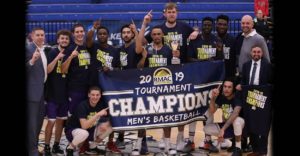
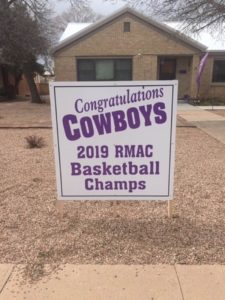
- It was Spring Break this week, but I still had some interactions with faculty who were on campus to meet with students, work on their research etc. I talked to a couple colleagues and the subject of meetings came up…as in, we have too many of them. Believe me, lots of people have leveled this complaint toward higher education, not just HU. I once worked at a school where there was an attempt—note I wrote “attempt”—to institute a zero-based meeting initiative. That is, we started the year with no meetings scheduled expect one faculty senate meeting per semester, one meeting to assess tenure and promotion portfolios, and one to meet on sabbaticals. Each college/school had one meeting scheduled at the beginning of the year. Department meetings were “as needed” and the thinking was that they would only be needed infrequently. That’s it. Of course, people could add meetings as they pleased and or needed, but we started with a skeleton schedule. Things started out OK, but over time some people expressed a desire and in some cases, even a need, to meet more often. Sub-committees of the senate were added (instead of the plan to do everything as a committee of the whole), frequently scheduled college and department meetings were added to the mix, and before the year was done, we were basically back to where we started. What I found (and I was a faculty member at the time) is that the faculty distribution regarding all this was kind of bi-modal. Some faculty seemed to care less if there were meetings at all. The reasoning went—if something comes up, let’s just meet then. No big deal. But, some others really wanted to meet more often—much more often. A few seemed to actually miss meetings, which was weird to me, but to each his or her own I guess. I vividly recall one particular colleague who after leaving a marathon session that solved absolutely nothing (I can’t even really recall what it was about so that tells you something right there) and was a total and complete waste of time emerged smiling from ear to ear and asserting, “Man, that was a great meeting.” What he thought was so great about it with the exception of him holding forth for hours and dominating a discussion that no one really cared about one way or the other…I do not know. Maybe that was enough for him. People mostly did not pay attention to him outside of meetings. As I wrote, by the end of the year we were basically back to where we started. The zero-based experiment had failed. I had been warned about this in graduate school. My mentors told me again and again that I was being trained for important academic work—not going to a bunch of meetings. Their advice to me, “Think of it like doing the dishes. Do your fair share, but no more and don’t think that even doing your fair share will probably make that much difference in the long run. I believed that then…I mean, that’s what my mentors were telling me so what did I know? Now, I don’t think they had it quite right, but I do see the wisdom of the broader point they were making. I also wonder if our propensity for so many meetings is yet another vestige of earlier times when faculty taught less, soft money was easier to win so you didn’t have to chase it so much, the pace of academic life was slower, and we all cultivated the genteel “life of the mind” in our daily work. As a junior faculty member (many years ago), colleagues got together at least twice a week for lunches and some of them were l-o-n-g lunches. There was a strong culture of being on campus—present and accounted for. No zooming in or showing up for your classes and office hours and nothing more. Remember that time? Man, I barely do. Today, things have changed, no? But maybe…when it comes to meetings (and many other activities) the times have changed but we simply have not. The subject of meetings in higher education comes up a lot and much has been written about them. Here’s one good article (https://www.insidehighered.com/advice/2018/05/03/10-worst-types-meetings-academe-opinion). I like the author’s description of what he refers to as Meeting Type #7— the I Hate This Particular Tree Meeting:
No. 7. The I Hate This Particular Tree meeting. These meetings start with some other stated purpose in mind but get hijacked. Most often, the new focus is a personal grievance or ax to grind that then quickly devolves into venting about related (or completely tangential) annoyances. Typically, those complaints are procedural or about technology or an undesirable change at the institution. The individual points are valid, but they are often idiosyncratic to the person raising them, or the issue is not being raised with anyone capable of making a meaningful change. The problem is that complaining is contagious and without any way to directly address the underlying issues, bad feelings will fester.
I also enjoyed his description of Meeting Type #10:
No. 10. The kick the can down the road meeting. Some problems are not easy to solve, and many decisions are difficult or unpopular. To avoid uncomfortable interactions, or simply to buy more time, decisions are tabled for a future meeting or require another, smaller group to consider it. The larger group is then unable to proceed until the smaller group reports back. That inevitably takes several weeks because the group needs to coordinate schedules among members of both groups. It gives the appearance of a conscientious and responsible decision but only delays the inevitable. Complete unanimity is rare. Leaders of meetings need to embrace difficult conversations and work to resolve even the thorniest issues.
But the best article is clearly “Everyone’s Favorite Meeting”:
Everyone’s Favorite Meeting. The best type of meeting is easily the canceled one. It should be. It’s simple addition by subtraction and realistically should occur more frequently. If the meeting you are considering scheduling has any realistic chance of being one of these other types, cancel it. There is a general sense of meeting fatigue among administrators and faculty because we have all been in one too many bad meeting. Each type shares one thing in common: they waste time. By canceling a meeting, you communicate something very important: I value your time and do not want to waste it. Meetings are a fact of academic life and can be essential to the institution’s success. Simply by eliminating undesirable gatherings, our hours spent together with colleagues will be more efficient and productive. As a result, meeting attendance, enthusiasm for important service roles and overall productivity will improve significantly.
I wonder…do we have too many meetings at HU? Too few? About right? If we wanted to make a change, how would we do that? I have one regularly scheduled meeting each week. I am going to think about that—are they really necessary? I also enjoyed this piece by Stephen Aguilar who asserted, “Meetings are a great equalizer — they subject nearly everyone to needless suffering.” That’s a good line, I think. Here’s his article: https://www.insidehighered.com/advice/2018/11/29/advice-making-meetings-productive-opinion. Here’s another good one: https://www.insidehighered.com/views/2015/08/14/essay-calls-end-most-committees-and-meetings-higher-ed.
- The HU Advancement Team continues to do great things for the benefit of the university and ultimately, our students. A faculty/staff campaign is planned for April and a donor has already kicked things off with a nice gift. This week we cashed in a CD ($160K) that a generous donor gave us and are also close to closing on another $250-300K cash gift. We closed out the Pajama Gala and made about $1500 there. Many thanks to all friends of HU and donors to our beloved institution.
The Ides of March—March 15—was a really bad day for Julius Caesar. March 15 may have been the first day of the rest of his life, but as it turned out…it was also his last day. A seer warned him about the day and apparently, Julius was not overly concerned. He had a pretty big ego. I mean, after all…he was Caesar. On the way to the theatre Caesar commented that the “Ides are come” and well…he was still among the living. So…in your face, seer. The seer replied, “Aye, Caesar, but not gone.” True. True. I like the lines in the poem below— Fear grandeurs, O soul. And if you cannot overcome your ambitions, pursue them with hesitation and caution. And the more you advance, the more inquisitive, careful you must be. I heard a couple versions of that sentiment many many times as a kid. The Midwestern values I grew up with were replete with warnings like “don’t get above your raising” (but usually spoken as “don’t get above your raisin” which always required that I laugh at the joke, but really got old and wasn’t all that funny to begin with. My grandmother, when admonishing me and she did that a lot, always said, Don’t’ get above your raisin…or raisin pie.” Ha. Ha. I never cared for raisin pie.) and “you’re riding a tall horse, son” and “it really hurts when you fall off a high hill” and “you’re no better than anyone else and don’t forget it” and “Boy, you’re batt’in way above your average right now.” All that stuck with me. As I achieved the very little I did achieve in life, I frequently reflected on those admonitions. The more I “advanced,” the more “careful” I was. Or…at least I tried to be. I didn’t want to get above my raisin and I worried about that quite a bit. Really, I still do. Maybe that’s a manifestation of Imposter Syndrome. Not sure. Of course, a more recent version of the Ides story was in the famous Stonecutters episode of the Simpsons. You’ve probably seen it. It is a classic. Homer accidentally winds up the leader of a cult like group—it goes to his head, of course—and has this exchange with Lisa:
Lisa: Remember, dad, all glory is fleeting.
Lisa: Beware the ides of March.
Homer: No.
Lisa: Dad, I know you think you’re happy now, but it’s not gonna last forever.
Homer: Everything lasts forever.
Of course, things turn south for Homer, but then again, that pretty much happens in every Simpsons episode. The poem below is by Constantine Cavafy; a very interesting Greek poet. He is highly regarded these days though not all that well known when he was alive. He was not widely known since he basically refused to formally publish his work. According to him, his work was for “the people” so he published in local newspapers and magazines and in some cases, he simply passed out his poems to people on the street. So, in recognition of the Ides, the dangers of ignoring seers, the inherent wisdom of not getting above your raising or raisin, the intentionally occluded but much speculated on location of Springfield, the really wonderful ideal of writing poetry or anything else for “the people” and literally giving it away for their enjoyment, and the lost art of oneiromancy (one of Artemidorus’ specialties), the poem of the week—The Ides of March by Constantine Cavafy:
The Ides Of March
Constantine P. Cavafy
Fear grandeurs, O soul.
And if you cannot overcome
your ambitions, pursue them with hesitation
and caution. And the more you advance,
the more inquisitive, careful you must be.
And when you reach your peak, Caesar at last;
when you assume the form of a famous man,
then above all beware when you go out in the street,
a conspicuous ruler with followers,
if by chance from the mob approaches
some Artemidorus, bringing a letter
and says hastily ‘Read this immediately,
these are grave matters that concern you,’
do not fail to stop; do not fail to push aside
all those who salute and kneel
(you can see them later); let even the Senate
itself wait, and immediately recognise
the grave writings of Artemidorus.
The Erudite Bella says, “The problem with humans is they chase their ambitions like the world depended on achieving them. They don’t…maybe can’t…live in the moment. Like dogs. Too bad for them. I’m with Ram Dass—be here now—that’s my motto.”

Sam Minner,
President
Greetings colleagues. A brief update for the week of March 4-8:
- Last weekend was a busy one. On Friday Joan and I drove up to Pueblo to see the women’s and men’s teams play. We made our way back to Las Vegas barely in front of a pretty major snowstorm. Due to the trip to Pueblo, I missed the annual Northeastern Regional Science Fair held in Wilson on Saturday, which I regret. More than 200 students participated in this event including students from Los Alamos, Taos, Roy, Penasco, Las Vegas, and more. Many thanks to Kino Hurtado and others who organized this wonderful and important event on our campus. A photo of the fair before the students and judges arrived and another shot of NMHU student Austin Griggs congratulating an obviously proud chemistry student:
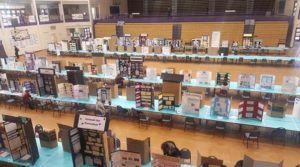
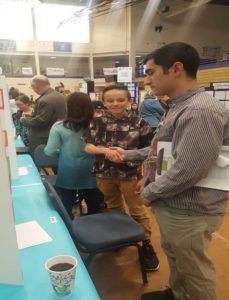
- As I imagine most people know, the board retreat scheduled for this Friday was cancelled and several colleagues asked me why. The name of one new Regent has been put forward and he is awaiting confirmation. We think two other Regents will be named very soon—probably next Wednesday. The meeting scheduled for Friday was going to focus on enrollment and after discussing this with Chairman Sanchez, we decided to cancel the meeting and reschedule soon after all new Regents are seated. That way, everyone can participate in the Board Retreat, hear the same presentations, and be a meaningful part of any solutions we devise.
- On Monday I drove to Santa Fe to serve as an expert witness in relation to Senate Joint Resolution 6. Basically, the resolution proposes the establishment of a nominating committee to screen potential regents for service at public colleges and universities. The basic idea is to wind up with strong regents and to try to decrease the possibility that someone would be named primarily or only due to political connections. It was a long hearing. I spoke in favor of this Resolution as did the presidents of several faculty senates around the state. I had a nice conversation with the President of the Faculty Senate at UNM and was impressed with her dedication to that institution and her overall approach to leadership. The Resolution was passed by the committee. I’ll keep people informed as it chugs through the rest of the process. The senator sponsoring this legislation is also carrying another bill to increase the number of regents at regional comprehensives from five to seven. I also endorse that bill.
- I was expected in Santa Fe again on Tuesday, but I decided to participate in a CUP meeting by phone so I could remain on campus and get caught up a bit. It also allowed me to participate in a Learning Happens Here session—this one led by Dr. Peter Linder. Peter’s talk focused on colonial missions in Venezuela and the tensions between and among the missionaries, government officials, and the indigenous people of the region. The session was really great (even with the power going off and on during Peter’s remarks) and a much needed intellectual boost. Given the job I have—all about budgets, government relations, lots of problems to solve from small things like, “heh, there’s a pothole near Wilson” to trying to bring enrollments up, etc.—it is important to at least occasionally reconnect with the primary mission of any university—the noble triumvirate of teaching (and learning), scholarship, and service to improve the world. This session did it for me. Thank you Peter for taking the time to do this. He is a sterling example of the strength of the faculty here.
- The team in Advancement continues to perform at a very high level. This week alone, we brought in a nice gift to support student travel, a fifty-percent interest in a local home, and a $160,000 CD in support of a scholarship fund. Well done to the colleagues there.
- We continue to make good progress with Rodgers. On Tuesday I met with several colleagues to discuss the technology we’ll be installing in the board room and the classroom. These are always tricky issues. You really don’t want to install technology relevant and useful just for the present. What will instructional and other technology look like 5, 10, or 15 years down the road? That’s a bet. A guess. And my experience with that suggests that it is difficult to make good guesses. My goals—make the new classroom in Rodgers as good as it can be by installing the best technology we can afford and hopefully, make good decisions that will make that space great well into the future.
- Many colleges and universities face enrollment challenges and one major factor in all that has to do with declining birth rates and a smaller number of students graduating from high school. According to Nathan Grawe, an economist at Carleton College, this drop is at least partly directly related to…what else?…the 2008 financial crisis. He reasons that many people viewed all that economic uncertainty as a reason to have fewer kids. The number of children born between 2008 and 2011 fell precipitously and most colleges and universities will feel that well into the future. The figure below captures these reduced numbers. Only a few states (in blue) are expected to see any post-secondary enrollment increases from now until 2029. New Mexico is expected to see somewhere between a 7.5%-2.5% decrease. That’s not good, but not as bad as several others states, especially some in the Midwest and East. I think the circles on the map represent large metropolitan areas and their projections for growth (or declines). When it comes to enrollment, the critical figure we report to various agencies is the fall census. On that date in fall, 2017, we enrolled 2980 students. Last fall (2018), we enrolled 2877. That’s a decrease, but the sky isn’t falling. Let’s hope we improve in fall, 2019. Our most significant gains from year to year were new first time/full time freshmen (that’s a good sign), online students, and student athletes. As I discussed in a previous message, the population challenges here in New Mexico are pretty significant. In 2015-2016 (the last year we had these data), 19,128 students graduated from New Mexico high schools. That year, New Mexico high school students had about a 72.4% continuation rate. That is, about 72.4% of all New Mexico students pursued some form of postsecondary education. That meant about 13,849 students went to higher education right out of high school. About 13.9% of all New Mexico high school grads left the state and attended university somewhere else. So…then we were down to 11,921. UNM enrolled 2,660 in-state students (less than anticipated). Another 1,886 went to CNM (again, less than anticipated) and 1,359 students attended NMSU. That left 6,016 students across all other remaining New Mexico schools—41 institutions of higher education in total. If those 6,016 were evenly divided among those 41 schools, each would yield about 147 students. 147. That’s it. Now I know that those 6,016 students are not distributed evenly across the 41 schools. Some institutions enroll more. Some less. But, this is illustrative of the challenge we face, particularly when it comes to new first-time freshmen. My conclusion—-enrollment challenges will not be solved by relying on increases in new freshmen as was done in the past.
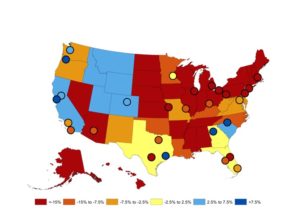
We are now carefully tracking enrollment in a much more systematic way and that helps so much in planning. We track this on a weekly basis. Here’s the detail I received from SEM for this week. The data below compares our performance from this week in 2019 to the same week last year:
Admits for Fall 2019
Dual credit: 0 – (same as last year)
Freshmen: 635 – (94 more than last year)
Transfers: 67– (3 more than last year)
Re-Admitted: 4 – (1 more than last year)
Int’l: 17– (1 more than last year)
Non-Degree: 0 – (same as last year)
Obviously, the most critical number is the new freshmen and that’s looking pretty good. Hopefully, that positive trend will continue and grow even more.
- Our men’s basketball team played their first RMAC tournament game on Tuesday evening and came away with a victory over the #2 seeded Dixie State team. Dixie was on a thirteen game winning streak. Coach Snow’s team has now won 20 games and I think we haven’t won that many in about a decade or so and I believe it is only the third time in the last 44 years we’ve won that many. Wow. HU is ranked #18 in the nation (Division II) in regard to average points scored per game (87.2). The team plays again today. You can watch or listen online—just go to NMHU Athletics. Speaking of our men’s team, I am so pleased to announce that DJ Bustos was just recently named the winner of the 2018-2019 RMAC Summit Award. This award is annually given to one male and one female player with the highest cumulative GPA participating in the finals of the RMAC tournament. DJ, a sophomore at HU and Las Vegas native, has a cumulative GPA of 3.964. DJ is a case study of the Division II motto—“life in the balance”—the notion that student athletes are students first, but can also achieve at very high athletic levels and that the mix so often produces people of high character and high achievement. AD Snow and I are on the same page when it comes to our athletics program…our goals—(1) students have a great academic and athletic experience (Life In The Balance), (2) student athletes graduate from HU with a quality degree preparing them for a life of meaning and purpose including a great career, and (3) students participate on competitive teams with dual goals of winning while also demonstrating high levels of sportsmanship. Congratulations to DJ who embodies these goals. A photo of Mr. Bustos:
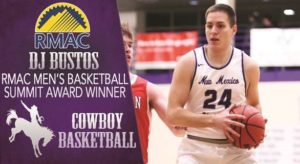
- It isn’t every day that someone calls me out of the blue to tell me some good news story about Highlands. I know positive things happen on campus all the time, but most people do not take the time to share good news. But, that actually happened twice this week. I received a call from one of our former students who was having lots of issues with his teacher certification. I’m really not clear what the issues were, but he was really feeling hassled. He called me to let me know that the staff, faculty, and administration in the School of Education “bent over backwards” to assist him and help him solve his problems. He went on and on about this and I could tell he was sincerely thankful. Another current student called me to express her thanks to the staff at the library. She was having a tough time finding what she needed and she wanted me to know how much help she received from our colleagues there. She literally said, “I hear that Highlands is a family. Well, that’s true.” I didn’t take notes during these calls so I am hesitant to thank people by name. I think I would leave someone out, but School of Ed and Library colleagues, thank you. You made a difference. Of course, as is true in any complex organization, I also receive any number of concerns and complaints from students and believe me, no office or even individual (including me) is immune from these. Those complaints are sometimes legitimate…that is, true and accurate. Sometime not. But I really don’t think of them that way. If a student or someone doing business with the university believes something, we need to address it as best we can. Who might be “right” or “wrong” is relevant, but of secondary importance to me. This week I also received two student concerns. I learned a valuable lesson from a good mentor at Northern Arizona University about how to think about and handle these matters. My mentor said issues, complaints, concerns, etc. are inevitable in any human enterprise like a university. Because the work we do is so high stakes (that is, it is critically important to students that they advance and complete their degrees), things can get emotional or even heated pretty fast. I get that. Here’s what my mentor said—when some issue comes up, people can be divided into two camps—those who are upset that there was some quality error and complain that things would get better only if someone else (e.g., Professor X, Office Y, whatever) did something and…those who do what they can to correct the issue as best they can, in their own way, and not first go to a blame game or only complain. Now I know some people sometimes do not follow through as they should and our students are upset with us. We are all human dealing with other humans in a complex context with lots of balls in the air. Six Sigma is not likely or frankly, even desirable in a university setting. But, when things happen, I apologize and then do what I can to correct the situation. I usually have to work with others including some who were directly involved in the issue, but I concentrate on solving the problem before us before I bring up any corrective actions or suggestions. Frankly, that’s what I learned from my parents and learned once again from Clara Lovett, former president of NAU and a great leader.
10. Many thanks to the faculty and staff who attended the Retention Forum on Thursday morning. The team who visited Georgia State last December provided an overview of what that institution is doing and what lessons we might learn from them. One difference between their approach and our own touches on learning communities. We have them. So do they. But, in their learning communities, there is relatively little attention paid to outcomes touching upon interdisciplinarity or related learning outcomes. Their learning community goals are mostly about retention. New students are handed a schedule—a complete schedule—and they take the classes on that schedule as a group. If faculty want to get together and talk about ways to integrate their courses, that’s fine, but again…the driver is retention. Students in each learning community quickly get to know each other and hopefully, establish a support network. I really think we should consider this approach. The goal of achieving some understanding of interdisciplinarity is a good one, but might be an overreach for first time freshmen or frankly, undergraduates in general. To truly understand enough about one discipline, during a single class, and to gain insights into how it connects with a second discipline is a pretty high bar. Here’s a few articles on what’s going on at Georgia State (https://www.nytimes.com/2018/05/15/us/georgia-state-african-americans.html, http://metroatlantaceo.com/news/2019/02/georgia-state-university-closes-achievement-gaps-graduation-retention-rates-perimeter-college/, and https://www.wabe.org/georgia-state-stopped-students-slipping-cracks/). Interim VP Edward Martinez did a superlative job leading the discussion which, frankly, was one of the best and richest discussions I’ve heard on our campus. Again, thanks to him and everyone who attended. The PowerPoint from the session is attached (above). A photo of the session:
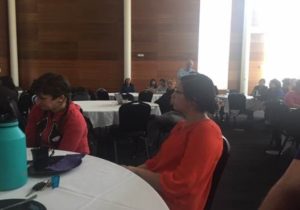
As many of you know, Joan and I have a new dog with us and living with her caused me to think a bit about dog poems. There are many of them. Poetry 101 students often read Elizabeth Barrett Browning’s poem, To Flush, My Dog. I once saw a little statue in Pablo Neruda’s Valparaiso home in honor of his dog memorialized in the poem A Dog Has Died. Thomas Hardy wrote of his beloved Wessex. And then there’s Alexander Pope. He was a real dog lover and kept large breeds because he liked them and to protect him from bullies. He was a short and kind of sickly guy who apparently got beat up quite a bit. Eighteenth Century London was tough. To protect himself he supposedly trained his dogs to attack on command and that threat coupled with the pistols hidden in his waistcoat apparently helped him feel a bit safer walking the streets at night. His favorite dog was a very large Great Dane named Bounce and the story goes that Bounce once actually saved Pope’s life. Someone broke into Pope’s home and attempted to rob him. Apparently the intruder had a large knife, which really adds to the story and might even be true. Bounce knocked the guy down and kept him down until the authorities arrived. I don’t think there is any actual record of this, but as I wrote, it is a good story. Bounce had a litter of puppies and Pope gave one to the Prince of Wales. The collar was inscribed with the epigram below. There’s been some speculation about what the verse means. Pope was a satirist and often skewered public officials, especially political figures. The thinking is that his short poem sent a message that even powerful people were beholden to someone, could (or should) not be able to get away with anything, and that no one was above scrutiny or the law. In other words, everyone is someone’s dog. Not sure if that is an accurate deconstruction or not, but it sounds right. So, in honor of Flush, Bounce, and Wessex, epigrams (and they are too rare these days), what I believe is the twentieth century update of Pope’s poem by Iggy Pop and the Stooges, and the largest compost heap in Europe located on the grounds at Kew, the breviloquent and satirical epigram of the week— Epigram Engraved on the Collar of a Dog Which I Gave to His Royal Highness by Alexander Pope.
Epigram Engraved on the Collar of a Dog Which I Gave to His Royal Highness
Alexander Pope
I am his Highness’ dog at Kew;
Pray tell me, sir, whose dog are you?
In regard to the poem above, the Erudite Bella says, “I am pleased to be the Minner’s dog—no shame in that—but I insist on having an equal say in all family decisions. And I do.”

Sam Minner,
President
Greetings colleagues. A brief update for the week February 25-March 1:
- We held a very successful Alumni Board meeting last Friday in Santa Fe. These dedicated HU supporters serve our institution in so many ways. They are unpaid and yet many of them drive or fly into Santa Fe for these meetings for one and only one purpose…to help HU as they can and to support our noble mission to serve our students. Many thanks to them, Juli, and the entire Advancement team for their hard work.
- Last weekend was busy as usual with an assortment of on campus activities including a recital, a free screening of A Star is Born, numerous athletic events, and other activities. Friday was a challenging day as the campus experienced a loss of water pressure and in many cases a total loss of water. City crews were working hard on the leak(s) and I decided to close the campus at noon if water was not restored. These are always tricky decisions—you don’t want employees or anyone else to go without water, but at the same time, you don’t want students driving many miles to campus only to find out their class is cancelled. Then, of course, instructors have to find a way to catch up, if possible. Furthermore, even when the campus is closed we have students in residence and some staff who must remain for safety, continuity of operations, etc. Noon came and went and I closed the campus and named our Environmental Health and Safety Officer, Mr. Brian Hennington, the single-point-of-contact to manage things in my absence ( once again, I was in Santa Fe…sigh). Brian immediately went into action finalizing the logistics to provide water to students and staff members, toilet facilities, access to showers, food, heat, and everything else required to support the students, staff, and others who remained on campus. We had several evening events scheduled on campus including women’s and men’s basketball games, a film, and other activities and all that had to be considered. The opposing teams were already on their way to Vegas. As it turns out, water was restored around 2:30 or so, but….I was very pleased how the campus as a whole responded to the water outage. It was very well done. Very professional. Thank you, Brian, and to everyone who played a role and was part of the solution to prepare the campus for what could have been a long-term and catastrophic event. Thankfully it was not.
- Every week I receive reports providing some insight into our performance in different domains. This is what I received this week:
- According to the Chronicle of Higher Education, NMHU remains the most affordable university in New Mexico and the fifth most affordable in the entire Southwest. If you are talking with someone about HU, please remember that—we are the most Tuition at HU is low. I know it is an apple and oranges comparison, but if we assessed the same tuition that one of our RMAC schools charges, we’d accrue about $33mil more…each and every year. Essentially, we could build a new building every year with our own funds (not have to ask the state for anything at all) or provide a huge compensation increase for all employees or allow all students to attend at no cost and on and on. We’re not going to raise tuition that much nor do I think we should, but this is illustrative of the huge differences between institutions.
- According to the United States Department of Education, our most recent cohort loan default rate has fallen once again. We are down to 12.4%. That means our students are able to repay their loans and are doing so.
- We are administering the NSSE right now and about 17% of our students have participated thus far. That’s not too bad, but please…encourage your students to do this. The higher the participation rate the better.
- We held the weekly EMT meeting this week and began the meeting with a discussion of a paper from Inside Higher Education. Here it is: https://www.insidehighered.com/blogs/confessions-community-college-dean/upstairs-downstairs. The article references some of the management ideas of Deming, the great management guru who is so influential still today. The paper basically focused on where innovation should (and does) come from in organizations and how structures and systems sometimes get in the way of real innovation and change. In regard to change coming from above or organically from the bottom up, the author of the paper asserted that “to get the systems right” change had to be pushed from the top down.” In another section of the paper the author suggested that in some cases, change from the bottom up is the ticket to successful innovation. I loved the author’s conclusion, “…there you have it. That’s why these jobs are so hard. They’re both right.” I think that is so true. People including many I consider good colleagues often argue that only one valence of innovation and change really works (either top down or bottom up) are just plain wrong, in my view. I’ve seen top down change succeed and I’ve seen it fail. Same for bottom up innovations. Thinking that only one way works or is valid or is even preferred is really naive, from my perspective. My take on this—if one asks which approach is best, that already means the person’s reasoning is off. The more legitimate question is—what ideas, irrespective of where they come from, are interesting and potentially meritorious and what structures are or are not in place to get some wind behind them? I think that organizations that function that way will probably win the day. We devoted the remainder of the meeting to a discussion of the upcoming board retreat, an update from the legislative session, and some additional budget discussion. We also collectively thanked Brian Hennington for his leadership during the water outage last week.
- On Tuesday evening, Joan and I welcomed members of the Viles Foundation Board, Viles students, and friends and families at a reception at the University Residence. As I imagine you know, the Viles Foundation supports students from our area who face challenges associated with attending university and over the years, the Foundation has assisted dozens and dozens of students. At Tuesday evening’s gathering, students introduced themselves and talked a bit about their plans. Wow. Students are completing demanding majors and have high plans to graduate, get great jobs, and lead lives of high meaning and purpose. It was truly a beautiful evening and Joan and I will host the Viles students every year I serve as president. I consider it a great honor to be even a small part of their success.
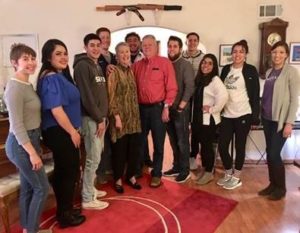
- The renovation of Rodgers continues on time and on budget. Most of the work is still in the demolition phase, but even now one can see how great the building will look in final form. We hope to have the newly renovated building—a modern classroom, the HU Heritage space, a board room, and some offices—open next fall. What Rodgers looks like now:

- As many of you know, our web consultant was on campus this week to conduct research that will help us build a better, more attractive, student-centered, website. I know a number of you attended Chantal Forster’s sessions, and she has reported the feedback has been invaluable. Ms. Forster visited with some of our current students as well as several high school students to conduct usability surveys during her visit to help us better organize and label information on the website. Sean Weaver is projecting the new site will be live in June, and we’ll be sending updates to everyone as the project moves forward. A photo of Ms. Forster leading a student focus group:
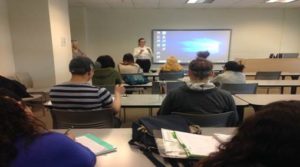
- Thursday was a very busy day on campus. It was Las Vegas, Mora, San Miguel County, and Pecos Day at the Roundhouse. Memorials were read in both chambers. I accepted the Memorial on the Senate side. David Sammeth accepted on the House side. Our Legislative Fellows were there and got same face time with the Governor. That was really generous of her…I think I have a tough schedule. I can only imagine her daily commitments. Later that evening, there was a social function at La Fonda and once again, Governor Lujan Grisham addressed the crowd. Our mariachis performed there (hit the URL below). It was a really great day for HU. A photo of our students with the Governor. Since I was in Santa Fe, I missed the Iron Tribe pour, which I regret. A photo of the pour appears below. As I wrote, Thursday was a busy one.
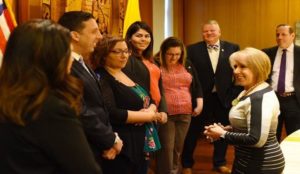
https://www.facebook.com/HighlandsUniversity/videos/2311905372467377/

- The dates for our HLC Focus Group visit have been set. Our visitors will be on campus March 30-31, 2020. Many thanks to Lee Allard for working so closely with the HLC to get this arranged.
- Let’s face it. The debate about the efficacy of online and other distance education approaches compared to face-to-face instruction is hardly over and I don’t mean just here at Highlands. It is a legitimate debate with many important implications. I think to the degree possible, the discussions/debates/arguments/knock-down drag-outs, etc. should be informed by science—by research—and there’s a lot out there. Speaking only for myself, when I was a faculty member and said I’d try some other modalities of instruction, I was absolutely confident that they would fail and students would not learn and I really didn’t want anyone to present any facts or science to suggest otherwise. That’s really no way to move forward, but that’s how I handled it nonetheless. Oregon State University has collected studies on this topic and that database is free. Here’s the link: https://ecampus.oregonstate.edu/research/projects/online-learning-efficacy-research/?utm_source=chronicle&utm_medium=print&utm_campaign=peer_influencer. This is really a useful database. Here’s an example of a study in the database comparing online and traditional student performance in college algebra:
College algebra – Online section versus traditional section.
Graham, V., Lazari, A.
The 21st century is considered to be the electronic age. This electronic age brings opportunities for new ways to deliver a lecture or a whole course in higher education. By offering courses online, universities are trying to reach the population of students that cannot attend classes on campus. Professors also utilize technology in a variety of ways to help them teach traditional classes. Valdosta State University (VSU) offers a variety of courses online including College Algebra (Math 1111). While we are trying to reach more students through the online courses, we should also examine the impact to student learning and success in College Algebra. In the fall 2016 and spring 2017 terms, VSU offered the first online sections of Math 1111 with 27 and 23 students, respectively. The course retention rate and the students’ performance on the departmental final exam for the treatment group, online section (OS), versus the control group, traditional section (TS) of 350 students, were compared. The OS had a statistically significant higher departmental final exam average, but there was no statistically significant difference in retention rate.
11. I am very pleased to announce that the Historic McCaffrey Trolley Building recently won another award. On February 22, 2019 the building won the annual Jeff Harnar Award for Contemporary Architecture in New Mexico. In my opinion, this is the preeminent architectural award in our state. A photo of the jewel of the HU campus:

12. This weekend also promises to be a busy one. On Friday evening, the Arts@HU program will present the Pink Floyd laser show in Ilfeld. The basketball teams will play in Pueblo (Joan and I will drive up to see those games). The men’s team has already earned an appearance in the RMAC tournament and the game on Friday will determine who they play and where. Good luck to them.
We’ve made it to March and that can be a tricky month. It can bitterly cold, but can also provide the first hints of spring. On our farm in rural Missouri, we referred to March as the Season Of Mud. Four wheeling down a 1 ½ mile dirt/gravel (mostly dirt) road was always an adventure and the Chev never got stuck, but you did think twice before you ran into town.

March is named after Mars, the god of war, so that sounds pretty fierce. It is also the month of Mardi Gras, daylight savings time begins, and of course, the Ides of March…a really bad day for Julius Caesar. What If Cats and Dogs Had Opposable Thumbs Day is also in March (https://www.daysoftheyear.com/days/what-if-cats-and-dogs-had-opposable-thumbs-day/), which is proof positive that some people do not have enough to do. The month has also inspired some poetry. To wit, Ella Wheeler Wilcox was a popular poet in the late 1800s and early twentieth century. I think she was considered more popular than good. Some of her poems even appear in anthologies of bad poetry and that’s a pretty mean thing to do if you think about it. I guess haters gonna hate, as they say. Interesting factoid: all season five titles from the Canadian science fiction series Orphan Black are quotes from Wilcox’s poem Protest. I guess that means she is popular with some person. So, in honor of laissez les bons temps ruler, Et tu, Brute?, the superior digit dexterity of human beings over cats and dogs, the mysterious Dyad Institute, and the mean spiritedness in the world that would cause someone to even publish a book of the “worst” poetry…the poem of the week: A March Snow by Ella Wheeler Wilcox:
A March Snow
Let the old snow be covered with the new:
The trampled snow, so soiled, and stained, and sodden.
Let it be hidden wholly from our view
By pure white flakes, all trackless and untrodden.
When Winter dies, low at the sweet Spring’s feet
Let him be mantled in a clean, white sheet.
Let the old life be covered by the new:
The old past life so full of sad mistakes,
Let it be wholly hidden from the view
By deeds as white and silent as snow-flakes.
Ere this earth life melts in the eternal Spring
Let the white mantle of repentance fling
Soft drapery about it, fold on fold,
Even as the new snow covers up the old.
The Erudite Bella says, “One of the humans I live with is always going to Santa Fe and he always comes home tired and grumpy. I mean…what’s with that? Glad I get to just hang out at home and play fetch and take naps.”

Sam Minner,
President
Greetings colleagues. A brief update for the week of February 18-22:
- Last Friday I held the most recent “Lunch and Listen” session—this one with the Registrar’s Office. The purposes of these sessions are to get to know the colleagues who work in various offices, their challenges and opportunities, and ultimately to think about and take action on initiatives that might make their lives better and improve our performance. Frankly, it is also a way to simply say thanks to individuals who work hard to serve our students and to make HU better. My takeaways from our time together—the colleagues there respect each other and even like each other. That’s a real plus. They dedicate some time on a routine basis to professional development and social interaction. Again…a plus. They care about our students and want to serve them. That doesn’t mean, of course, that students always get what they want, but the people in the office try to serve them well and efficiently. They care about the students who come to their office and work hard to serve them. We’ve had some good discussion on campus about whether or not higher education is a “business” and I’ve tried to be clear on my position there. When it comes to time in classes, trying to achieve at high levels, etc.—students are, well……our students. They are not guests we must try to please or customers we want to keep happy no matter what. I just don’t think it works that way. But, when it comes to working with our students in business functions—getting them registered, getting transcripts to them, answering their questions, etc.—I do pretty much think of our students as guests or customers. Students will not be happy in every situation—they want certain things and are not pleased, in some cases, when things don’t wind up that way, but in terms of their treatment…how we interact with them…I think the guest or customer approach is good. Tom Peters, the management guru, once said something like “…treat customers like guests and employees like people.” After my Lunch and Listen with this group, that seems like their approach too.
- Lots of discussions about enrollment continue on our campus and around the state (really, around the nation). We face lots of challenges, but still…we must find a way forward. Here’s one of the challenges we face:
In 2015-2016, 19,128 students graduated from a New Mexico high school. New Mexico has about a 72.4% continuation rate. That is, about 72.4% of our kids pursue some postsecondary education. That means about 13,849 students went to higher ed right out of high school. About 13.9% of all New Mexico high school grads leave the state and attend somewhere else. So…now we’re down to 11,921, That year, 2,660 in-state students went to UNM. Another 1,886 went to CNM and 1,359 students attended NMSU. That leaves 6,016 students across all other remaining New Mexico schools—41 institutions of higher education in total. That number—6,016 divided by 41 institutions means—-if the 6,016 were evenly divided, each school would yield about 147 students. If HU gets a fair share of in-state students attending higher ed, we’d enroll about 147 new students. 147. That’s it. Now I know that those 6,016 students are not distributed evenly across the 41 schools. Some institutions enroll more. Some less. But, this is illustrative of the challenge we face, particularly when it comes to new first-time freshmen.
And that, my colleagues, is a problem.
- The legislative session continues with nothing at all settled, but perhaps a little more clarity. People who read those tea leaves better than I can believe that we’ll probably end up with 2% new money, maybe 4% compensations increases, and some ERB relief. HU is in for numerous other possible increases including additional money for Rodgers, new equipment, some funds for the Native American Social Work initiative, and a few other items. Clearly, HU has some good friends there. On Wednesday, I attended the confirmation hearing for Kate O’Neil. I spoke on her behalf as did most other university presidents. She was unanimously confirmed and I look forward to working with her. The large crowd congratulating the new HES Secretary.
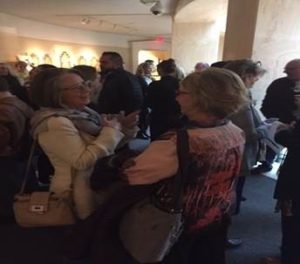
- Thursday was HU Day @ The Legislature and it was a great day all the way around. Our Legislative Fellows were there on Wednesday and Thursday and I am not kidding…they absolutely wowed the various officials they met. Great and insightful questions, fully professional in every respect, etc. Lt. Governor Howie Morales spent almost 40 minutes with them. The HU mariachis performed and we had numerous tables situated around the rotunda with information about the university. It was really a great day. A photo of the Lt. Governor talking with our students and Roxanne and Leon showing everyone how it is done during a rousing mariachi number.
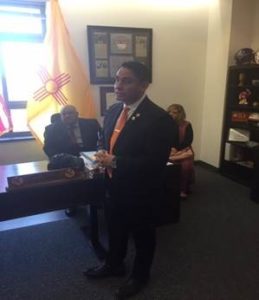
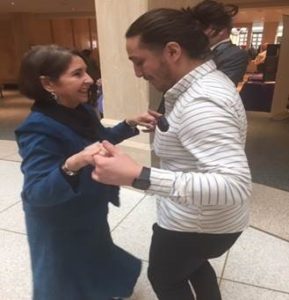
I recently spent some time in the Roundhouse during a day when lots of children were there. It appeared that some kids were with their parents and some were with their teachers, but it afforded me a nice opportunity to observe some interesting interactions between kids and adults. As usual, I observed a full range of interactions—both good and bad. One little girl ran around breathlessly looking at different exhibits with her mom in tow who shared her enthusiasm (or pretended to) for pretty much everything they saw. It was a beautiful day for that little girl and I one I imagine she’ll remember for a long time—maybe forever. Another kid slowly walked from exhibit to exhibit while almost constantly being reminded by the adults at his side to “not touch anything” and apparently to not get too excited about anything. Well, he didn’t touch anything and believe me, he certainly did not get excited, so I guess mission accomplished. I could tell that both adults—the super-excited mom and the very reserved parents making certain no one was too excited— thought they were doing exactly the right thing. I saw a child pretty severely disciplined for taking a free pamphlet of some kind by the entrance to the capitol. I mean…the darn thing was free and there were hundreds if not thousands of them in a pile. I also heard a little girl and her parents planning where they would have lunch while joking and laughing along the way. The little girl—and the adults—were having so much fun. As they say, you have to pass a test to drive a car or any number of other activities, but you don’t have to have any training to be a parent. Even with no training required, some parents seem to do pretty well with it all and some…not so much. Fortunately, children are pretty resilient (within limits) and even parents who are less than perfect and sometimes make mistakes (like me) can still raise some pretty great kids. So—in honor of all that, doing the best job with kids that you can, celebrating living arrows and stable bows, and allowing kids to take free material in a public building—the poem of the week. Not really a stand-alone poem, but a section from a book and one of my favorites—Speak To Us of Children from The Prophet by the Lebanese-American poet Khalil Gibran. The lines about “living arrows…sent forth…upon the path of the infinite” are among my favorites and I think very beautiful.
Speak To Us Of Children
from The Prophet
And a woman who held a babe against her bosom said,
– Speak to us of children!
And he said:
They are the sons and daughters of Life’s longing for itself.
They come through you but not from you,
And though they are with you yet they belong not to you.
You may give them your love but not your thoughts,
For they have their own thoughts.
You may house their bodies but not their souls,
For their souls dwell in the house of tomorrow,
which you cannot visit, not even in your dreams.
You may strive to be like them,
but seek not to make them like you.
For life goes not backward nor tarries with yesterday.
You are the bows from which your children as living arrows are sent forth.
The archer sees the mark upon the path of the infinite,
and He bends you with His might that His arrows may go swift and far.
Let your bending in the Archer’s hand be for gladness;
For even as He loves the arrow that flies,
so He loves also the bow that is stable.
There is a new resident at 1325 5th Street—the Erudite Bella. As you can see, the Erudite One is a chocolate lab and she is a very good girl. I mean…really…can you be anything but good…maybe even great…when the word chocolate is actually in your name? Anything chocolate is great, everyone knows that, and Bella is no exception.

Sam Minner,
President
Greetings colleagues. An update for the week February 11-15:
- It was another busy weekend. I (once again) drove down to Santa Fe for an early Saturday morning legislative hearing—this one focusing on athletics. I appreciated the interest our elected officials have in athletics. Though hardly at the center of our work in the academy, lots and lots of people are interested in collegiate athletics and want to know how all that is managed, how much it costs, and what the future of colleges sports might look like. One thing that I will emphasize—at least in Division II athletics—student athletes academically outperform the general student population and this is true at most schools. Taken as a group, student athletes are among the highest performing students at most all DII schools. This has been studied carefully and there appears to be several reasons why this is true, but foremost among them are (1) the structure/time management required to be both a student and a student athlete is high and focuses a student’s attention often resulting in good academic outcomes and (2) there is a built in support network for student athletes (i.e., the team, coaches, others) that non student athletes sometimes do not experience. Here’s an article about the athletic hearing: http://www.santafenewmexican.com/news/education/unm-president-draws-fire-from-lawmakers-over-sports-cuts/article_ec43d610-11fd-505b-86b4-c65b71c0b55a.html. Here’s a related op-ed from the Santa Fe paper: http://www.santafenewmexican.com/opinion/editorials/soccer-and-skiing-not-the-top-issues-in-higher-ed/article_7239fcfe-0bb2-5471-a516-ffee41daf487.html.
- The session in Santa Fe is about half done and things continue to look generally favorable. The Council of University Presidents (CUP) continues to press on a “5-5-1” position meaning five percent new money, five percent compensation increases for college/university employees, and one percent for ERB (retirement). If we get those gains, some additional funds for Rodgers, some funds for Native American Social Work, and a few other programs, I’ll consider the session a success. My sense is we’ll see some movement on the minimum wage issue and something for certain to settle or at least partially settle the Yazzie /Martinez vs. State of New Mexico lawsuit. Max starts his car and it automatically goes to Santa Fe. Mine too. Who knew a car could learn to be driverless?
- On behalf of HU, I provided comments to the United Stated Department of Education (USDoE) in regard to the proposed changes in Title IX requirements. Essentially, I objected to all of the proposed changes and recommended that we keep things the way they are at present (the so-called “Obama era” regulations/standards). Of particular concern is the proposed change that a person accused of misconduct would be guaranteed the right to cross-examine the accuser in a live hearing. It is my position that this has the potential to re-traumatize the victim and I am opposed to that. If an alleged victim agrees to a “live” hearing, that’s fine with me, but to require it…I am not in favor. The proposed changes also raised the bar of what constitutes sexual harassment. The old rule is that it is defined as unwelcome conduct of a sexual nature and the new rule is that it is unwelcome conduct…that is severe, pervasive and…offensive. The “pervasive” term bothered me. I mean, if someone is harassed, I really don’t care if it is pervasive or not. It should not occur on a college campus…pervasive or otherwise. That’s my position so I objected to that change as well. Regrettably, there was a website glitch and my comments were not received, but this week I received an email from the USDoE and the comment period has been extended. I’ll try one more time.
- There is understandably lots and lots of talk in Santa Fe about workforce development. I think everyone gets that—most everyone needs a job and it would be great if everyone had a really good job. What I don’t hear too much about, however, is how the old formula: go to college and major in x, get an entry level job in x. work for thirty years in x, and then retire from x simply doesn’t work that way anymore. I heard a young person the other day say he wanted to be a truck driver. In the past, that’s been a good job, but…how long might it be before most trucks are driverless? How many human beings have been and will be replaced by robots in different businesses? And on and on. Given all this, I think we all need to carefully think about the “core” skills and knowledge pieces that will (or might) sustain a worker into the future and in my mind, those are mostly the skill and knowledge pieces from the traditional liberal arts. Things like critical thinking, strong communication skills, knowing how to learn, the ability to prepare a good argument and detect a bad one, decent quantitative skills, decent tech skills, etc. What got me thinking about this was the photo (below). In the 1930s, Duke University supported a program to prepare students to be ushers in movie theatres. The photo below depicts the cohort in all their splendor. When is the last time you’ve even seen an usher? Are we currently preparing students to be “ushers” in some other job that exists today, but maybe not for long? I thought about this one more time this week when I was talking with a wonderful HU student who was interested in becoming a faculty member at some point. She asked me if she should learn something about online instruction…she wasn’t a fan although she admitted she had not tried it. I pulled out some data demonstrating how the ranks of full-time tenure-track faculty had been and continued to shrink and also demonstrating the growth of online instruction and asked her to tell me what she thought that all meant in regard to future job prospects. Her analysis—she loves face to face instruction and hopes that is in her future (good for her), but is also planning on learning something about best practices in online and other distance instruction (good for her, again). My prediction—she will do well.
- I sent out a global message the other day regarding the start of our website redo, but one more time…please try to attend a campus forum Feb. 20 at 10 a.m. in G-35 to learn about the process. The goal is to develop a more user-friendly and informative website. Students, faculty and staff outside of Las Vegas may attend the session via Zoom at https://nmhu.zoom.us/j/632187898 . There will be three listening sessions to gather information/ recommendations about the path forward:
- Feb. 20, 12 p.m. in Lora Shields Room 265 (Zoom: https://nmhu.zoom.us/j/632187898) for Strategic Enrollment Management, Business Office, Registrar’s Office, Financial Aid Office and other student-servicing offices.
- Feb. 20, 4 p.m. Student Center Room 321 for students (center and online students may attend via Zoom at https://nmhu.zoom.us/j/632187898)
- Feb. 21, 12 p.m. in Student Center Room 321 (Zoom: https://nmhu.zoom.us/j/632187898) for faculty, deans, chairs, and center directors/building managers.
I know and have known from my first day on campus that our website needed attention. We just have not devoted sufficient resources to it—frankly, I don’t think we had the resources to do so given our other needs—but this year we are able to start making improvements. Let’s not squander this opportunity. Please get your two cents in and then we’ll use the resources we have to make the site as good as it can be. Thanks so much.
- The Vatos won their most recent match against NM Tech—130-5. Wow.
- On Tuesday I convened the EMT meeting to prepare for the board meeting and to work on some budget matters. I mentioned that HU (and really, all institutions of higher education) are or should be “learning organizations”—a term popularized in the 1990 book The Fifth Discipline by Peter Senge. These days, I don’t keep many books on my shelf (I tend to give them away after I read them), but the Senge book is one I do keep and go back to often. I am sure that many of you know this book—it was wildly popular when it came out and remains popular today. Essentially, the author talks about how some organizations can (and should) focus on learning above all else. He also talks about how so many organizations seem to be “learning disabled” and how that hampers their success and growth. One of the organizational “learning disabilities” he talks about in the book is the “frog in the boiling pot” metaphor. Put a frog in a boiling pot and the frog will jump out. Put a frog in a pot of cool water, put the pot over heat and ultimately bring it to a boil, and usually the frog just remains in the pot getting groggy, but not jumping out. Ultimately, the frog expires. So…..maybe….higher education is the frog…for many years we were in an environment that was comfortable (plenty of state money, plenty of students, etc.)…but for some time the heat has been coming up (reduced state funding, reduced enrollment, reduced tenure track faculty with more and more adjunct faculty, etc.)…and we stay in the pot. We don’t make many changes. Will American higher ed wait too long before making a change?
- I toured Rodgers this week and things look great. We are on schedule and on budget. The renovated building will include a classroom, a board room for the Board of Regents, the Faculty Senate, general faculty meetings, the staff senate, and other large gatherings, and some offices on the second floor. Rodgers is shaping up to be a real campus gem. A photo of me living out my Bob the Builder dream:
- We had a board meeting Thursday and I’ll send out a summary of the meeting soon. There was lots of good discussion about enrollment and I will continue to think about what was said, but here’s where I’m at right now. We’ve engineered a new unit on campus—Strategic Enrollment Management—hired a good leader for that unit, worked with some good consultants to help us get organized, hired new and more recruiters, devised better promotional materials, purchased new tools (i.e., Slate) to help us manage things, etc. There’s always room for improvements and if you have ideas about how we might improve recruitment I’d be interested. But frankly, I am just not convinced that adding lots of new resources to what we are doing now would make much of a difference. The way we recruit now is pretty good, in my view, and just adding to that might add a few more students, but not many (in my opinion). I say….let’s allow the Division of SEM to work free of the cloud of accreditation woes and instead of adding resources to the unit, let’s push hard on new curricular offerings. We’re about to launch the new online teacher ed program and we’ve received interest from about 130 students (that’s 130 new students) and that is without really spending much at all on recruitment. We haven’t really had to recruit students to that program with the exception of a few newspaper articles—student want to participate. I know not all 130 students will really enroll, but if we launched 4-5 new programs attracting that much interest—voila….enrollment problems at partially resolved. Bottom line for me…continue to invest in enrollment management, but not too much. Instead, invest in new curricular offerings bringing student to us.
The board also heard a report from the Faculty Senate noting that there was little interest in any type of administrative reorganization—at least at this time. We will soon be starting discussion about our new strategic plan and an argument was made that it might be better to get all that done before we looked at our structure. I understand that argument and see how it makes sense, but…it assumes, of course, that after the new strategic plan is done there will not be any other major changes or possible changes confronting us. These days, I guess I am not sure that is or will be true. The pace of change in the higher ed sector is increasing, in my view, and most of the changes are external and often unanticipated. Still, the sequence of changes in any organization is important. What changes, if any, should come first? But also, is it wise to not act in the hopes that things might be a little more settled in the future? Interesting questions to ponder…
I don’t think the origin of Valentine’s Day is really quite settled. The version I am familiar with suggests that a Roman Emperor believed that single men made better soldiers than married men and outlawed marriage for single guys. This didn’t go over too well with some men—they wanted to marry and serve as soldiers—so they married in secret. There were no Las Vegas marriage chapels at the time and no Elvis imitators who could marry couples for 50 bucks. So, a fellow named Valentinus defied the Emperor’s orders and married people secretly. Unfortunately for Valentinus, the Emperor found out about all this (you apparently couldn’t keep a secret in Ancient Rome) and put Valentinus to death. Yikes. Like the Gram Parsons/Emmylou Harris song…love hurts. So…in honor of Valentinus, the day honoring his courageous, but perhaps foolish actions, and the tragic Gram Parsons-Emmylou Harris (supposedly) platonic love story and song—the poem of the week: How Do I Love Thee? (Sonnet 43) by Elizabeth Barrett Browning:
How Do I Love Thee? (Sonnet 43)
How do I love thee? Let me count the ways.
I love thee to the depth and breadth and height
My soul can reach, when feeling out of sight
For the ends of being and ideal grace.
I love thee to the level of every day’s
Most quiet need, by sun and candle-light.
I love thee freely, as men strive for right.
I love thee purely, as they turn from praise.
I love thee with the passion put to use
In my old griefs, and with my childhood’s faith.
I love thee with a love I seemed to lose
With my lost saints. I love thee with the breath,
Smiles, tears, of all my life; and, if God choose,
I shall but love thee better after death.
Sam Minner,
President
Greetings colleagues. A brief update for the week February 4-8:
- Last weekend was a busy one. Joan and I saw many of you at the Fool For Love play on Friday evening, The Cowgirls and Cowboys played in town on Friday and Saturday evenings. On Friday, the men scored 119 points in a big RMAC win over the University of Colorado-Colorado Springs and lost a very close one to Colorado School of Mines—one of the top teams in the nation. Then, of course, the Super Bowl on Sunday. Not sure if you know this, but this year’s Super Bowl had a strong Highlands connection. The Special Teams Coordinator for the Rams is John Fassel who coached at NMHU in 2003 and 2004. Here’s a brief story about John and his time at HU: https://www.krqe.com/sports/the-big-game/rams-special-teams-coach-has-ties-to-new-mexico/1747088892?fbclid=IwAR0hCMlRw884oj-c7Mq39Vf4WEi_mACWk6gsq-TRO1JvMDNyHibbYw4C3gA. Proof positive that anyone—a coach, a student, anyone—can start anywhere—say a modest state university in Las Vegas, NM—and go far. That is a beautiful truth.
- This was an incredibly busy week in Santa Fe as things heat up at the Roundhouse. I think HU was represented at every hearing that was important to the campus. I have tried to keep up with emails and so on, but my work down there has been significant and if I have been a bit slower to respond and or get in touch with, please forgive me. I’ll be attending a special session this Saturday that focuses on athletics—a hot topic down there these days. Many thanks to Max, Denise, our Student Ambassadors, and everyone who is working hard in Santa Fe to promote HU.
- While in Santa Fe the other day, I once again heard someone assert that “going to college in New Mexico” simply wasn’t worth it. The fellow making this assertion said that most New Mexico students had to borrow to attend, had to pay “sky high” tuition, and graduated with debt—sometimes significant debt. There were no facts or data to back up these assertions, but facts about all this do exist and are easy to find. The Return on Investment (ROI) of a college degree has been very carefully studied and quite consistently, students graduating from a New Mexico institution of higher education have the second highest ROIs in the nation. This was in 2018. The 2019 data are being collected now, but I bet it is about the same story. Here’s some data…some facts… about this:
- New Mexico: 2nd best ROI in the nation
- New Mexico: 151% 5-Year ROI on College
- Average high school graduate salary: $25,747
- Average bachelor’s degree holder salary: $43,257
- Increase in annual pay for earning a bachelor’s: $17,510
- New Mexico workers with only a high school diploma are among the lowest-paid in the nation, earning $25,747 a year on average.
- Earning a bachelor’s results in a respectable 68 percent pay increase. And with the third-lowest college costs in the nation, at $34,945 for a bachelor’s degree, this investment pays off in only two years.
So the truth about all this…New Mexico has a very favorable ROI. The investment our students make in their higher education is paid off in about two years—one of the best in the nation. New Mexico students pay the third lowest tuition in the nation. Also of note, New Mexico college graduates have the second lowest college debt in the nation and only a little more than half of New Mexico students (53%) have any debt upon graduation (go to: https://lendedu.com/blog/average-student-loan-debt-statistics That’s all good news. However, New Mexico was recently #1 in another statistic—the number of citizens with a bachelor’s degree leaving their home state. Yes, New Mexico has a higher percentage of citizens with a bachelor’s degree leaving the state than baccalaureate trained citizens in any other state. That’s not good.
- I imagine that some of you have been following the recent developments in Iowa pertaining to the potential abolishment of tenure. This comes up from time to time and a good HU colleague recently asked me about my opinions on the subject. My opinion is unchanged—tenure is very important in the academy and I will fight to retain it at all costs. Here’s a recent article expressing my view on that topic: https://www.abqjournal.com/1029357/three-flawed-suggestions-for-better-colleges.html.
- Thanks to our wonderful Advancement Team and everyone who attended the Love and War event Thursday evening. Chocolate dishes from several places in town were paired with drinks from Borracho’s. People voted for their favorite chocolate while listening to jazz. There was a silent auction and a live auction…and, of course, there was a Conga Line. That goes without saying. Hundreds of faculty, staff, students, and friends of HU attended this wonderful event. Well done to all. A couple photos from the event:
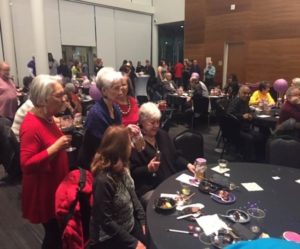
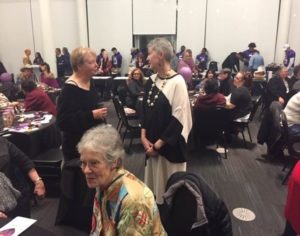
When I worked at Radford University, the incredible poet Nikki Giovanni frequently visited the campus. She is a Distinguished Professor at Virginia Tech and Tech is only a few miles from the Radford campus. I found her to be very generous with her time and like most great scholars I’ve known (compared to those who assert or act like they are great, but really aren’t) she was very accessible, kind, and down to earth. She has done so many wonderful things in her life and career, but perhaps none equals the acclaim she received for the chant poem she delivered at the campus ceremony held after the Virginia Tech shootings. I’ve heard many times—but not really sure that it is true—that Charles Steger, President of Tech at the time, asked her to give a speech at the ceremony and gave her only 24 hours to prepare. A tall order—but she delivered as always. She ended her speech with the now famous “We are Virginia Tech” closing. Hokies still use that phrase all the time. The affinity that Tech students, graduates, and others in the region have for that institution is really something. People love that institution and frankly, don’t want to hear non-Hokies say anything bad about it. In honor of Black History Month, the truth that all people are truly as “good” as anyone else even if some misguided people sometimes think and act otherwise, and Nikki for her willingness to frequently meet with students, community members, and me…the poem of the week. BLK History Month by Nikki Giovanni.
BLK History Month
If Black History Month is not
viable then wind does not
carry the seeds and drop them
on fertile ground
rain does not
dampen the land
and encourage the seeds
to root
sun does not
warm the earth
and kiss the seedlings
and tell them plain:
You’re As Good As Anybody Else
You’ve Got A Place Here, Too
Sam Minner,
President
Greetings colleagues. A brief update for the week January 28-February 1:
- I was in Santa Fe several days this week. One meeting I attended focused on New Mexico’s Dual Credit program. The whole dual credit idea has some merit and can help some students graduate with lower debt and faster. That’s good, but….the program here and in every state I’ve worked faces many challenges. Because of poor or nonexistent advisement, lots of high school students continue to take some dual credit classes that simply do not apply to their program of study when they get to college. I don’t know how many students and parents I’ve told that…yes, your daughter has 24 dual credit classes but…those classes are not required for any program…they won’t count for anything but electives. Those conversations usually do not go well. Dual credit classes are supposed to be at the same level of rigor as regular (non dual credit) colleges classes and sometimes they are. Sometimes not. How things work fiscally can be a problem and we have that kind of issue here in New Mexico, Basically, the college or university offering the dual credit class receives very little money to do that work—certainly not enough money to cover the real costs. A solution to the fiscal issue was offered at the meeting—a 9-12 million dollar fund to pay colleges and universities the real costs of doing this. We’ll see if that idea gets any traction. Also, strong participation in dual credit by a university can kind of mask what is really going on with their enrollment. Several institutions here in New Mexico would take a huge enrollment hit if dual enrollment high school students were not enrolled. There are some issues with that.
- The Council of University Presidents appeared before the Senate Finance Committee and we made our pitch—new dollars to even come close to those we lost over the last several years, improved compensation, and retirement. I think the presentation was well received. HED also made some recommendations. People know what we want in higher ed. Now, we wait and see what happens. I do sense that the new HED Director, many legislators, and others are working together in a collaborative way. That’s a nice change and bodes well for us…and the state of New Mexico. Many thanks to the servant leaders in Santa Fe who are working on these matters. While in Santa Fe, I heard several very positive comments about our new fast-track teacher certification program. We recently hired an individual to lead and manage that program, Ms. Lorraine Martinez (photo below). This week, Provost Gonzales also did a radio interview on the Richard Eeds show about that program.
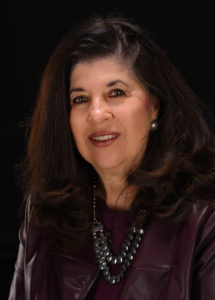
Lorraine Martinez
- Several colleagues have asked me about two other initiatives churning in the legislature—increasing the minimum wage and allocating potentially significant resources to at least partially resolve the Yazzie Both of these issues are relevant to HU so I don’t mind publicly expressing my opinions. I am absolutely, definitively, and without question in support of increasing the minimum wage. It is just not right to live in a very wealthy country where some citizens work hard every day and simply cannot afford life’s basic needs. I think that is shameful. However, assuming the measure is approved by the governor, HU and other agencies will face some challenges. For example, will we receive state resources to fund those increases? If not, where will get the money? If the minimum goes up to $12.00, what about the people working here—and perhaps some of them have been here for some time—who now earn $12.50? What can/should/will be done to address that salary compression? We’ll just have to deal with all that. Turning to the Yazzie case, again—I am pleased that New Mexico might provide additional resources to serve children who have been so poorly served for many decades. In my view, that’s the right thing to do and has been too long in coming. But again, there may be challenges if this moves forward. For example, some have suggested that K-12 teachers should receive a major compensation increase—maybe 10K per year. I support that fully. Teachers are incredibly important in our society and their compensation is simply not congruent with that reality. But, if that happens some K-12 teachers will probably earn more than some new assistant professors, thus making it even tougher to recruit good people in the academy. Again, we’ll deal with all that if and when it happens. Just because some action results in other problems and challenges is no reason to not do the right thing.
- Many thanks to Mike Petronis for winning the grant dollars to acquire a new piece of equipment for the Paleomagnetic Rock Laboratory. The equipment will help researchers to more powerfully understand volcanoes. It also sets HU apart from most universities—the HU Lab is the only one of its kind in New Mexico, Southern Colorado, Arizona, and West Texas. The equipment was installed this week. Well done.
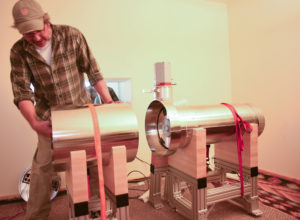
Highlands geology professor Michael Petronis installs a new instrument in the university’s Paleomagnetic Laboratory.
- Please encourage your students to complete the National Survey of Student Engagement (NSSE) which will be administered online beginning February 12. The NSSE is a well-respected survey designed to provide good information about the student experience—information we can then use to make HU better. We administer this measure every couple years. Our students will receive an email and several reminders up until March 18. Here’s some additional information: http://www.nmhu.edu/institutional-research/oier-reports/?fbclid=IwAR2lLxoOkTRzWnnzUAeTPUgvQe956NE_qSrmWu27BW6vI70gOEQymHC-IIE. We last administered the NSSE in 2016. First year students rated HU very favorably in regard to participation in a learning community (27 points higher than our peers). That freshmen group rated HU lowest in providing diverse perspectives in classes (17 points lower than our peers). However, senior students rated HU positively in regard to including diverse perspectives in classes (12 points higher than our peers) and lowest in “completed a culminating experience” (27 points lower than peers). Two very important questions on the NSSE pertain to overall student satisfaction. In 2016, 75% of our first year students rated their HU experience as excellent or good. Among seniors, 86% of students rated their experience as excellent or good. Eighty-three percent of seniors said they would definitely or probably recommend HU to others. Bottom line—in general, our students like HU and they have a good experience here. That was true, at least, in 2016. Let’s see where we land on this administration of the NSSE.
- I met with several local superintendent this week and HU will be working with them to host an event honoring top student athletes from the region. We’ll invite the student athletes, of course, plus their parents and other family members. Obviously, we’ll also try to interest the students in HU. More on this later.
- Many thanks to Victoria Evans and many others for organizing a benefit dance in support of furloughed workers. The event was held last Sunday in support of federal workers impacted by the partial government shutdown. In addition to this event, HU invited displaced workers to register at no cost in our new GIS online class, and we worked with individual displaced workers to make certain they could register for classes. Thank you, HU colleagues, for your efforts to help out. Hundreds of dollars were collected in support of this worthy cause. Thank you Vic for demonstrating such support for our friends hurt by the partial government shutdown. There was some music at the event—here’s an image of a few participants on the dance floor:
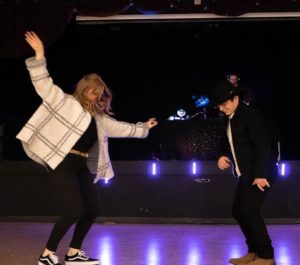
Participants attending the dance for furloughed workers raised hundreds of dollars for this fundraiser.
- On Thursday, Joan and I hosted the folks from FlagShakes who are putting on the Fool For Love The play will be at Ilfeld on February 1 and 2. Our guests were from Flagstaff and since Joan and I lived there for about ten years, we had a lot to talk about. It was a very nice evening. Also attending—-Brandon Kempner (Chair of English—currently on sabbatical), Donna Woodford-Gormley (former Chair of English), Lauren Fath (Interim Chair of English), and April Kent (never been a Chair of English, but a great librarian). Please try to hit one of the performances (7:30 p.m.).
T.S. Elliot called April the cruelest month, but February is very often the coldest and I personally think February would give April a good run for the money as the cruelest. It is a tough month. Etruscans named the month after Februs— the god of death. Romans called it Febris—after the god of fever and sickness. Not exactly ringing endorsements of the month, no? More recently, it is the month the music died. Think Buddy Holly and Ritchie Valens. Yikes. To keep with the February and how difficult that month can be themes, the poem of the week by Sara Teasdale. She was a pretty dark poet who lived a very difficult life. Some have suggested that this particular poem is atypically upbeat for Ms. Teasdale. She is on a hill looking at a star and it is peaceful. Calm. Others suggest otherwise. She is all alone and looking at a star who is looking back at her. No one will blink. A little creepy. At any rate, her poem—February Twilight:
February Twilight
Sara Teasdale
I stood beside a hill
Smooth with new-laid snow,
A single star looked out
From the cold evening glow.
There was no other creature
That saw what I could see–
I stood and watched the evening star
As long as it watched me.
Sam Minner,
President
Greetings colleagues. A brief update for the week January 21-25:
- I was very pleased that last Saturday HU hosted a community event focusing on opioid use in our nation and our local community. To say that this is a problem is quite an understatement. Thanks to everyone who made this happen and all who participated in the event. It was an honor to support this event on our campus.
- I hope everyone had an opportunity on Monday to participate or at least reflect on the legacy of Dr. Martin Luther King Jr. Monday was full of Dr. King quotes and those can help to inspire. But, action is required to really make the world more just. And actions begin with the individual. I believe that and will personally recommit to it and I hope you do too. Our own Dr. Ruthy Watson did a keynote at the Roundhouse on MLK Day and I heard many rave reviews. Well done.
- The legislative session continued this week and some potentially good and positive things appear to be moving forward. The Council of University Presidents continues to push for some new resources for all institutions of higher ed, compensation increases for employees, and additional support for retirement. We remain optimistic about additional funding for Rodgers, our nursing program, and our social work program. I’d say the vibe in Santa Fe continues to be pretty positive. Having some new money available for initiatives makes a lot of difference.
- This week I attended the national NCAA meeting along with hundreds of presidents and chancellors (and thousands of Athletic Directors, coaches, and other athletic administrators) from around the country. The national meeting is a major time commitment, but it is important, I think, to attend. Presidents and Chancellors are ultimately responsible for problems and issues in athletics (really, along with every other thing on campus) and excuses like “I didn’t know that was contrary to the NCAA” or “I really didn’t know what was happening in athletics” may be true, but don’t count for much if there actually are issues. Ultimately, you’re still responsible. I attended a number of sessions (e.g., equity issues, concussion issues, governance matters, etc.) and most were helpful and very professional. The most interesting session I attended focused on e-sports. It was interesting for a couple reasons. First, more than 1000 people were at the session. 1000 people now interested in this topic. Wow. Just wow. Several large, some middle size, and some small schools reported on what they were doing and how things were working out. A large school with a well established program has about 600 students playing e-sports and about 300 of them are attending this institution because of e-sports. The 600 students on the team have an average GPA of 3.35 and about half of them are STEM majors. Almost no one on the team leaves before they graduate. The university built a special space for the team to the tune of about $500,000 (which they got from a donor) and the total annual budget for all this is…about $20,000. Not a bad ROI. I met the CEO of Riot Sports. That firm owns one of the biggest games in e-sports. I told him about our team and he was very encouraging. A researcher in this domain (who knew there was such a thing?) found that many e-sports players just weren’t into regular NCAA games and maybe were never on any type of team before. He talked about the benefits of team membership and how e-sports players benefitted from that. It was pretty interesting. Florida is not really my favorite place. Grown men and women walking around in mouse ears just seems…I don’t know…a little creepy to me, but the meeting was worthwhile. Still, I’ll be glad to get back to NM.
- I want to thank Kino Hurtado who led a very successful effort to bring high quality professional development to more than 50 teachers, principals, and other educators. The workshop was led by Dr. Hector Montenegro, an international expert in Academic, Social, and Emotional Learning. The co-sponsors were Mora Independent Schools, the NE Regional Cooperative, and the NMHU School of Education. Great job all the around.
- Many thanks to Professor PJ Sedillo for leading two Safe Zone training sessions this week and many thanks to those who participated. College campuses should be at the vanguard of supporting and celebrating human diversity and these kinds of sessions help us achieve that goal. Well done to all who were part of this. A photo of Dr. Sedillo:
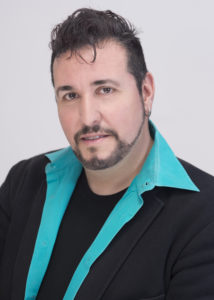
- Please plan to attend the production of Fool For Love by Sam Shepherd. The play will be performed on February 1 and 2 at 7:00 p.m. in Ilfeld and is produced by the Flagstaff Shakespeare Festival (also known as FlagShakes). We hope to bring some Shakespeare to the campus in the future. Please note that there is an age advisory of 14 for the play. A scene from the production:

Sam Shepard’s play Fool for Love will be performed Feb. 1 and 2 at Ilfield Auditorium.
Las Vegas, New Mexico
July 10-12-2019
- I also want to let everyone know of a very interesting meeting to be held on our campus—the 19th International Reversal Theory Conference. This from the call for papers—delegates to the conference are from a range of disciplines, fields, and professions interested in understanding and changing human behavior and experience, whether existing Reversal Theory researchers or those wanting to find out more. This conference has traditionally been very inclusive and welcome delegates from any discipline on any topic. We are always interested to receive submissions of new and innovative ways to apply and explore Reversal Theory, or studies conducted in, as yet, untapped fields of inquiry. To see more about the theory visit: http://www.reversaltheory.net/org/,
A rapid response after an anonymous, peer review will be returned within one month after submission. We welcome submissions on original research, methods and theoretical papers or critiques for direct oral presentations. Additionally, we intend to have a poster session one evening. All are welcome to submit a poster and while not limited to students it is a great opportunity to gain experience. We look forward to receiving your abstract on or before May 19th. The conference will be July 10, 2019. Many thanks to Dr. Jay Lee for bringing this to HU.
As a young faculty member and (younger than I am today) administrator, I really enjoyed travelling for my job. Staying in hotels, eating at restaurants, etc. was enjoyable. Today—not so much. I still like to travel if….it is someplace I’ve not been, but that is rare if we’re talking about work travel. I’ve not seen any meetings or conferences that I really need to attend in Mongolia or Antarctica or the Outer Hebrides. I’ve actually been to the Outer Hebrides so that one is not on the bucket list. Another trip to DC or LA or Chicago or somewhere like that holds little interest, but I still make those trips given the job I have. At some point, I usually open the hotel window (if it can be opened) and greet the city where I’m staying. I have a standard greeting to the city or town where I’m staying (that’s all I say about that) and then—I’m back to dealing with and temporarily living in the hotel room. The only really interesting things about hotel rooms are their occluded histories. I bet those would be interesting if I knew them. But, I don’t and never will even though I think about them quite a bit. How many people have stayed in the room? What dramas played out there? I will never know the answers to those questions, but it is fun to think about them. So—in honor of the hundreds of hotel rooms I’ve stayed including the most recent example in Orlando, Florida where I could occasionally catch a whiff of the Atlantic, but not see it—the poem of the week. Rhian Gallagher is from New Zealand and a real national treasure there. Her poem—Hotel Room:
Hotel Room
by Rhian Gallagher
It is a room just off to the side of our lives
newly emptied. Our small clutter spills
across polished surfaces as we fill up the vacancy.
Halt of a lift, voices that come through walls like a cloud,
no-one lives here. It is a room with no country.
Our half-emptied bags wearing yesterday’s flight tags,
the room makes loud its limitation yet
holds out hours and gives us passport. Space.
All around are towers, floors of rooms, window
squares of light. The city sounds, loading, unloading.
We draw the curtains on a night that is wide as the Atlantic.
Sam Minner,
President
Greetings colleagues. A brief update for the week January 14-18:
- Last weekend was a busy one. Our basketball teams played some games at home (our men’s team now second in the RMAC and 10th highest scoring team in the nation) and Joan and I attended the Montezuma Ball in Albuquerque on Saturday evening. HU was well represented at that event—Roxanne and Sandy attended as well as several HU staff members from the Center for the Education of Diverse Student Populations (CEDSP). Each year, the Montezuma Ball is chaired by a non-profit organization and proceeds are shared with a second participating organization. This year’s primary beneficiary was the Museum of New Mexico Foundation in support of the Palace of the Governors, New Mexico History Museum and New Mexico Historic Sites. The Montezuma Ball proceeds will provide these cultural institutions with resources for historic preservation, exhibition renovation and educational programming. Dual Language Education of New Mexico was honored to be the secondary beneficiary for 2019. A photo from the event:

- The legislative session began this week and I am confident that HU is well positioned to strongly advocate for our students. We are sending all legislators a new HU Update highlighting our accomplishments and making everyone aware of our needs. The Council of University Presidents has set numerous meetings to communicate our positions to decision makers and we have also clearly established our legislative priorities. The top two remain overall restoration of higher education funding and a 5% compensation increase for employees. We continue to press for one time funding to complete Rodgers as initially planned (cost have risen substantially due to, among several issues, tariffs and trade wars) and we continue to push for ERB sustainability with no harm to employees. We have a great HU Day At The Legislature planned complete with a performance by our new mariachi troupe. The HU Fellows program (students shadowing legislators) is going well. At this point, the General Fund Agency recommendations are out and the recommendation is to increase HU’s overall funding by 3.3%—one of the highest percentage increases among all institutions in the state (e.g. NMSU: +2%, Eastern: +2.8%, Northern: 0%, Luna: -.6%, Mesalands: -.2%, etc.). Thus far, we’ve done a good job advocating for HU, but all we have are recommendations at this point. Things can (and probably will) change. I think everyone believes the focus of the session will be preK-12 and it hard for me to argue against that. The latest Kids Count survey from the Annie E. Casey Foundation was just published and New Mexico was ranked 50th in the nation—the worst state to raise a child and prek-12 education was a big reason for our last place rating (go to:https://www.nmvoices.org/wp-content/uploads/2018/06/NM-KC-profile-2018-1.pdf). We just can’t seem to move the needle on those markers…take a look at our state performance over time (https://www.nmvoices.org/wp-content/uploads/2018/06/NM-KC-profiles-1990-2018.pdf). The solution? I think it just has to be a sustained focus on preK-16 education and I mean sustained. A one year push due to great gas and oil production will do little to change things. We need some consistent resources to move the needle and that means not relying so much on extraction. I recently learned that the number of rigs in New Mexico dropped—and dropped more than in any other state. So, extraction is boom and bust and it is tough to provide sustained resources to education (or anything else) when there is an overreliance on that sector. My two cents. You may disagree, of course. The Governor’s speech was met with great optimism pretty much across the board. Now, the work really begins. Here’s her entire speech:https://www.kob.com/kobtvimages/repository/cs/files/State%20of%20the%20State%20Speech.pdf.
- The Executive Management Team met on Monday. We began the meeting with a brief discussion of the issues and challenges at UW-Stevens Point. Like us, that regional comprehensive has been grappling and continues to grapple with falling enrollment and trying to find the right mix of programs for the 21st century. . For more, go to this New York Times article: https://www.nytimes.com/2019/01/12/us/rural-colleges-money-students-leaving.html. Several months ago, I wrote the Chancellor there and my letter eventually appeared in the local paper. Here it is: https://www.stevenspointjournal.com/story/opinion/readers/2018/05/11/uwsp-major-cuts-liberal-studies-prepares-students-career-options/594641002/. As we begin the process of establishing our new strategic plan, I think it is important to both safeguard the long-standing traditions of the liberal arts and sciences to free the human spirit and help humans live lives of dignity and high purpose and at the same time, address the many changes in the economy, the student demography, and the pace of change we see every day. In my mind, those taking a position that “nothing should change” are equally dangerous (and wrong) as those wanting to change for the mere sake of some change. I don’t think there are many souls at those extremes, but I hear from them from time to time. Something I think a lot about—might it be possible to fashion a university where everyone, not just middle class or wealthy students, has access to a top notch and affordable liberal education and are fully prepared to successfully participate in the modern economy? Not just get a decent first time job out of school (although that is important), but graduate as fully prepared as possible to have a great career with numerous jobs in numerous domains over a lifetime? What would that look like? When I think about that, I usually land on a very beefed up career services program. The idea is that all students…irrespective of major—graduate with the knowledge and skills to participate in the modern economy and get a good first job and more critically, have a great work career over their entire lifetime. I’ve often heard these skills referred to as “future proof” skills, but you know, if there is someone smart enough to reliably predict the future and what jobs will be hot then, I’d really like to meet them. I’m not sure anyone like that truly exists. I’ve read that about 80,000 robots “work” in Amazon Fulfillment Centers with more on the way. Who would have guessed? How soon will robots “drive” cabs and trucks? If that happens…some say when it happens—cab and truck drivers will be a thing of the past. Who would have predicted that, say, 25 years ago? After this discussion, we went on to what more we could and should do to support furloughed federal workers. We are offering free tuition for our online GIS class for those folks now, but what else might we do? Several recommendations were made and we’ll make final decisions soon. Max provided a legislative update and I provided an update on HU regent selection—nothing final on that, but we could hear any day.
- On Thursday I held this semester’s first Coffee with the President event. About 100 colleagues attended to hear me provide a campus update and answer questions from the audience. Sean Weaver also introduced a new colleague, Ms. Anne Maclachlan. Anne joined the University Relations staff this week as the university’s new web content manager. As you recall, I devoted resources in this year’s budget to improving our web presence, and Anne will be an instrumental part of that process. In February Anne, Sean Weaver and a web consultant will hold a campus forum to introduce everyone to the website development process and start collecting data to produce a more efficient, user-friendly site. I’ve often heard it said that there is never an upper limit to improving communication throughout any organization and that seems true to me. My efforts, at least thus far, have been to host monthly meetings, the weekly email messages I send out on Fridays, bimonthly EMT meetings involving a number of executives, the President of the Faculty, and others (most of the information from that meeting is supposed to be disseminated, but sometimes that happens and sometimes not), and an open door policy (i.e., if my door is open and I’m not on the phone, I’ll see you then…of course, you can also make an appointment). In addition to these efforts, this semester I am also hosting a monthly Lunch and Listen program where I invite various offices (e.g., Recruitment, Registrar’s Office, etc.) to lunch to hear directly from them. What’s working? What’s not working? What are their challenges? I hosted the first Lunch and Learn this week and listened carefully from our colleagues in Financial Aid. One of the questions at the Coffee pertained to “customer service”—and what we are or are not doing to work on that. Over the last year or two, HU has engineered numerous workshops, trainings, etc. focusing on this and there has been good participation across the board. We’ve also hired Michelle Bencomo and she has done a great job wrestling down numerous complex student issues. A number of our managers have also focused on improving service outcomes. So, we are doing things to try to improve. But, issues and problems remain. Frankly, higher education in general is pretty well known for providing poor service and not keeping pace with business processes commonly used in business and industry. Long lines, complaints about access to people, and concerns that answers to questions take too long or in some cases, are never provided at all have been and still are very common in the academy. Unlike businesses, there is really very little external pressure to improve. Universities go “out of business” from time to time, but I’m not sure any school has ceased to exist due only or even mainly to poor service. I think every single institution where I worked I’ve heard the phrase “X shuffle” as in the U of A Shuffle, the Murray State Shuffle, the NAU Shuffle, the ETSU Shuffle, the Truman Shuffle, and others (yes, I’ve worked at all of those places and more). I’ve heard it here—the Highlands Shuffle. My point…as a sector, we’re just not very good at this. I think some variables in higher education result in even more issues. If we are talking about traditional age students who have grown up online, they are accustomed to getting answers right now—no waiting. Older students are busy with their families, jobs, etc. and have little patience for inattention from people working in some university office. In our work, there is sometimes conflation of alleged poor service and not getting the answer you want (e.g., “it took two weeks to hear that I was not admitted to this program and I’m upset about that”). Some complaints of “poor service” occasionally mean that the student has simply not done what she or he needed to do in the first place. I think words matter too. I personally do not think of students as “customers” at all. In many businesses, the customer is always “right” and needs to leave happy and that is clearly not the case when we’re talking about the academy. We give students feedback they sometimes do not like. We sometimes award them what they consider a “bad” grade. No decent faculty member assigns students grades to make students happy. Anyone who does that is no colleague of mine. Students earn their grades and the chips fall where they may. We have tough conversations with students that are quite different from what someone at a retail outlet would have with a customer. I mean we sometimes tell a student she or he is not going to be admitted to a program—can you imagine telling a customer that she or he will not be permitted to purchase the five gallon tin of tortilla chips? It just doesn’t work that way. To me, the best way to think about all this is not to consider students as customers at all, but to simply treat our students as human beings deserving respect and dignity and as much attention as we can muster with busy lives and multiple demands. If someone calls you, they deserve a call back, but a call back within minutes of a request is not always reasonable or even possible. If someone wants some other person to sign or even look at something, of course the paperwork should be reviewed as soon as possible. But, the person waiting for some document usually has no idea what else or how much is in the person’s inbox. Often, they really don’t care. They want their issue to be handled asap. I enjoyed a recent piece in the New York Times that touched on some of this (https://www.nytimes.com/2019/01/12/opinion/sunday/email-children-balance-parenting.html). When talking about service to our students it is just too easy to think that things would get better if only some other person or office would improve. That may be true, I suppose, but I think the best path forward is to focus on one’s own behavior and do what can be done to improve things overall. We are here for our students and we need to take care of them as best we can. How to do that? The whole service issue is a complicated one in higher ed. If you have other thoughts about what we might do at HU, I welcome them. A photo from this week’s Coffee with the President:
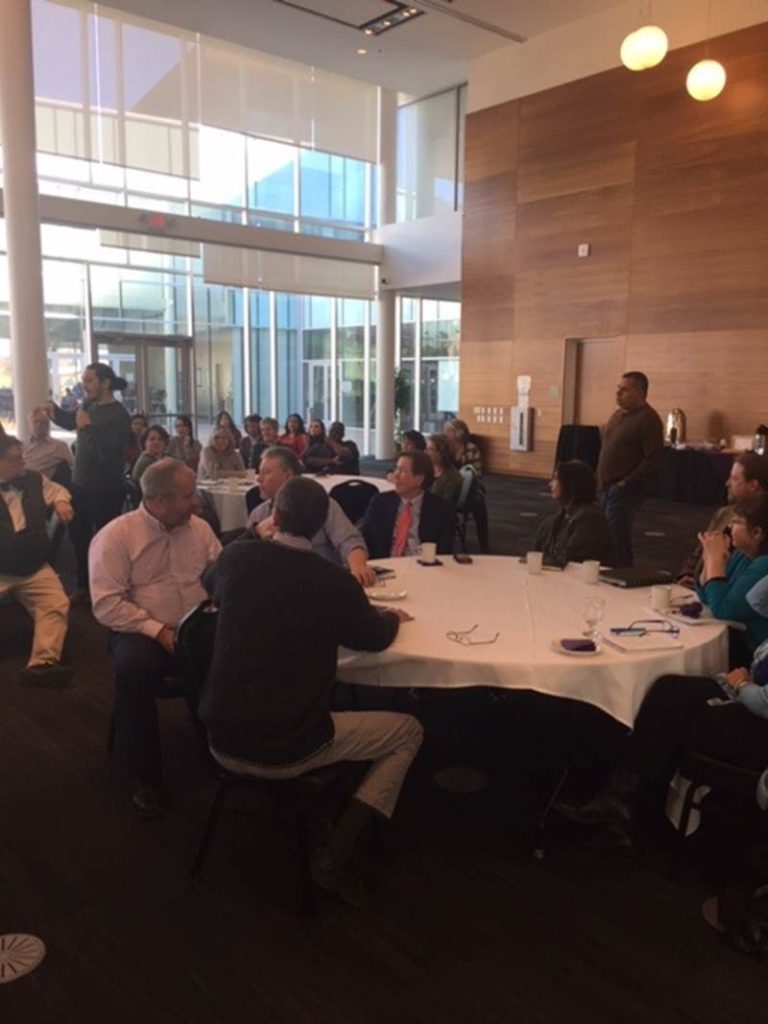
January can be pretty tough. Short days. Cold all the time. You can still maybe get outdoors, but you have to bundle up so much that it can be hard to even walk. My dad, a legendary gardener, wanted to be outdoors all the time and January was always difficult for him. His one escape while the cold wind was battering his living room windows in Central Illinois was endlessly studying dozens of seed catalogues. Although he spent hours studying the catalogs, he always wound up ordering the same seeds…I never really understood that. It is just what he did. His favorite catalog was from the Burpee Company. I’m not sure if that firm is still in business, but he always claimed that Burpee seeds were the best. I recall that he always wanted to plant a variety called “big boy” tomatoes. In honor of the derisive music that batters our windows in Northern New Mexico and finding somehow and someway to deal with January—constantly flipping through seed catalogues, binge watching Netflix, finally getting to books stacked in the corner during warmer weather, taking naps with your dog on your lap, or whatever—the poem of the week—-January by William Carlos Williams:
January
Again I reply to the triple winds
running chromatic fifths of derision
outside my window:
Play louder.
You will not succeed. I am
bound more to my sentences
the more you batter at me
to follow you.
And the wind,
as before, fingers perfectly
its derisive music.
Greetings colleagues. A brief update for the week January 7-11:
- This week, I met with Lore Pease, CEO of El Centro Family Health and Interim President of Luna CC Ricky Serna to sign an MOU providing healthcare services to Luna students. LCC students will receive healthcare, including behavioral healthcare services, at the NMHU Clinic. I’ve heard that the 21st Century belongs to the “connectors”—people who find new ways to work together to get things done and I think this new collaboration is a great example of that. In the higher ed sector—and I am not just talking about here in New Mexico, but the sector generally—we simply must be more collaborative. I really don’t see how else we can get things done. Like most all new and good things, lots of people were instrumental in making this happen, but it would not have happened without the substantial efforts of Dean Blea. Thank you, Kim, for going the extra mile to get this done. A photo of the MOU signing:
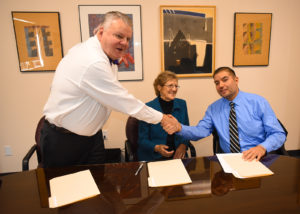
- On Tuesday, the newly established Las Vegas New Mexico Community Foundation (LVNMCF) met on our campus. I am on the board of that organization and it is already doing great things. The LVNMCF recently awarded grants to several non-profits in the region and more will come soon. Here’s our website if you care to check it out: https://www.lvnmcf.com/. These days, I am very optimistic about the future of Las Vegas. The opening of the Castaneda will be here soon. Main Street Las Vegas recently won a major grant to continue the work in the Railroad District. Other non-profits like the Arts Council continue to do good things in the city and now…there is a fully functioning community foundation that is off to a great start.
- I’m not sure where we landed on the end-of-year campaign in our Advancement Office, but I do know we received and continue to receive many gifts from dedicated HU supporters. This week alone we received a $10,000 check quite out of the blue. I write “out of the blue” as if it just happened by chance and that is not really true. We have a professional staff there now using good tools and strong leadership from the board and all that is clearly a recipe for success. And, we are indeed experiencing success there. Thanks to the Advancement Team and let’s keep things going strong.
- A few weeks ago, the NMHU mariachis participated in a very successful holiday concert and I’ve heard rave reviews from folks who attended. Our troupe will perform at the Roundhouse during the legislative session and will also perform at La Fonda during the annual Las Vegas Day event. The trajes for our group have arrived and they look great. Well done to our student performers and everyone who is part of this initiative.
- I am very pleased to announce that HU will be partnering with FlagShakes—a nonprofit bringing top quality Shakespeare and other productions to the city of Flagstaff. This spring FlagShakes will bring a production of the Sam Shepherd play Fool For Love to the campus and we all hope to begin some Shakespeare productions this fall. More on all this later.
- Our men’s basketball team continues to do well. They now have ten wins and are tied for third place in the RMAC. The team is also 16th in the nation in total points scored per game. HU student athletes also scored some impressive wins at a regional wrestling tournament last weekend. Our Cowgirls recently got a thrilling overtime victory over Adams State. A photo of Raquan Mitchell—one of our top HU players:
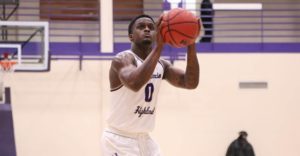
- On Thursday, Roxanne and I drove to Denver to meet with representatives of the Denver Zoo. As you may know, the zoo is the major partner in the Rio Mora Refuge and some of the funding the zoo was managing to keep the good work going out there has about been expended. It was a good meeting (although the drive home was rough—snow and ice almost all the way) and clearly, there is a mutual desire to maintain our work. The meeting was worthwhile and Rio Mora partners have some possible paths forward. Roxanne and I were also hosted to a “behinds the scenes” tour of the zoo. This is a rare deep jungle beast who had recently given birth to a calf. A photo of Roxanne taking a photo of the animal. Neither of us can recall the name of the animal.

Joan and I spent most of the holiday break in Bucksport Maine visiting our daughter, granddaughter, and son-in-law. Incredibly, we were in Maine—in late December—and learned that New Mexico was being hammered by one winter storm after another while we saw almost no snow whatsoever. It was cold there, make no mistake about that—but almost no snow or ice. Our beloved granddaughter, Mabel, spent a lot of time with us and to break things up a bit, we took her and one of her classmates from the Bay School to Camden. Camden is a short ride from Bucksport with incredible ocean views virtually the entire way. We checked into a hotel with a (supposedly) heated pool and the kids had a lot of fun while Joan and I did some recreational reading poolside and in front of the lobby fireplace. Any student of poetry knows that Camden, Maine was the home of the Pulitzer winning poet, Edna St. Vincent Millay. She was born in Rockland, Maine—again, not far from Bucksport—but basically grew up in Camden. In remembrance of our trip there and in honor of the poet—the poem of the week—the first lines of Renascence supposedly written atop Mt. Battie in Camden, ME by a twenty year old Edna St. Vincent Millay. This poem won her a scholarship to Vassar and is arguably the poem that made her famous.
Renascence
All I could see from where I stood
Was three long mountains and a wood;
I turned and looked another way,
And saw three islands in a bay.
So with my eyes I traced the line
Of the horizon, thin and fine,
Straight around till I was come
Back to where I’d started from,
And all I saw from where I stood
Was three long mountains and a wood.
Go to https://www.poetryfoundation.org/poems/55993/renascence if you’d like to read the entire poem.
